Cappadocia is one of the most unusual regions you can live in as a digital nomad. The valleys are filled with rock-cut churches and villages carved straight into the cliffs, and the mornings often begin with hot air balloons floating overhead. Life here moves at a slower rhythm: hiking trails start right outside town, cafés are tucked into cave-like rooms, and the evenings are quiet enough to actually hear the wind.
For nomads, Cappadocia offers some of the most striking landscapes in the world. It’s a place where you can spend the morning on calls, the afternoon walking through rose-colored valleys, and the evening sharing a simple meal in a family-run restaurant.
In this complete guide, we’ll cover what it’s like to live and work in Cappadocia: where to stay, how to get set up, and the best hikes and day trips.
Why Cappadocia?
Cappadocia feels like a desert frontier—jagged valleys, cave towns, and open skies that make the whole region feel otherworldly. At first, it’s easy to see only the tourism machine: hot air balloon rides at dawn, tour buses lining up in Göreme, and endless souvenir shops. But stay longer, and something else emerges. This is a place layered with depth. Beneath the tourist bubble is a vast network of trails, canyons, and rock-cut dwellings that can take weeks to explore.
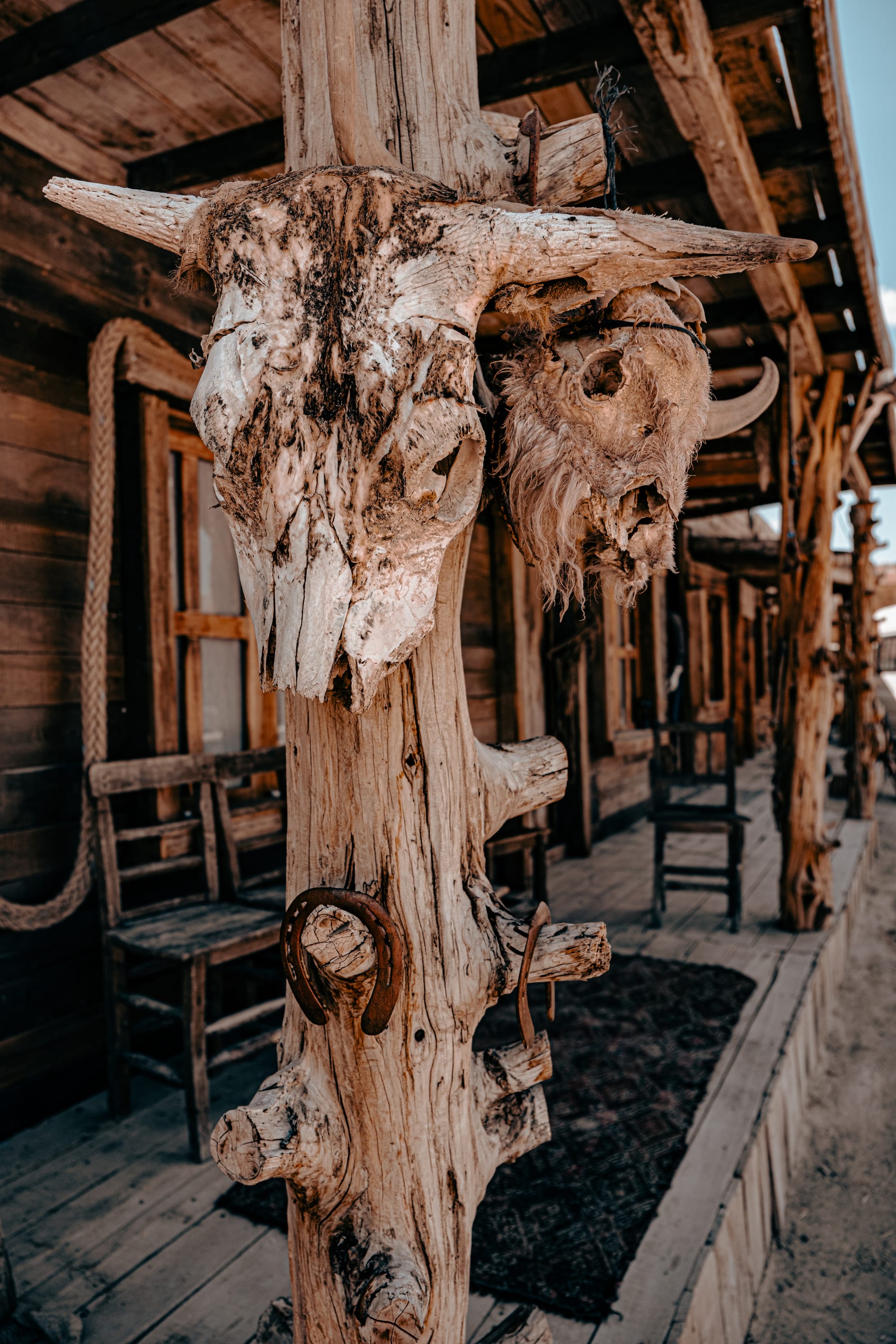
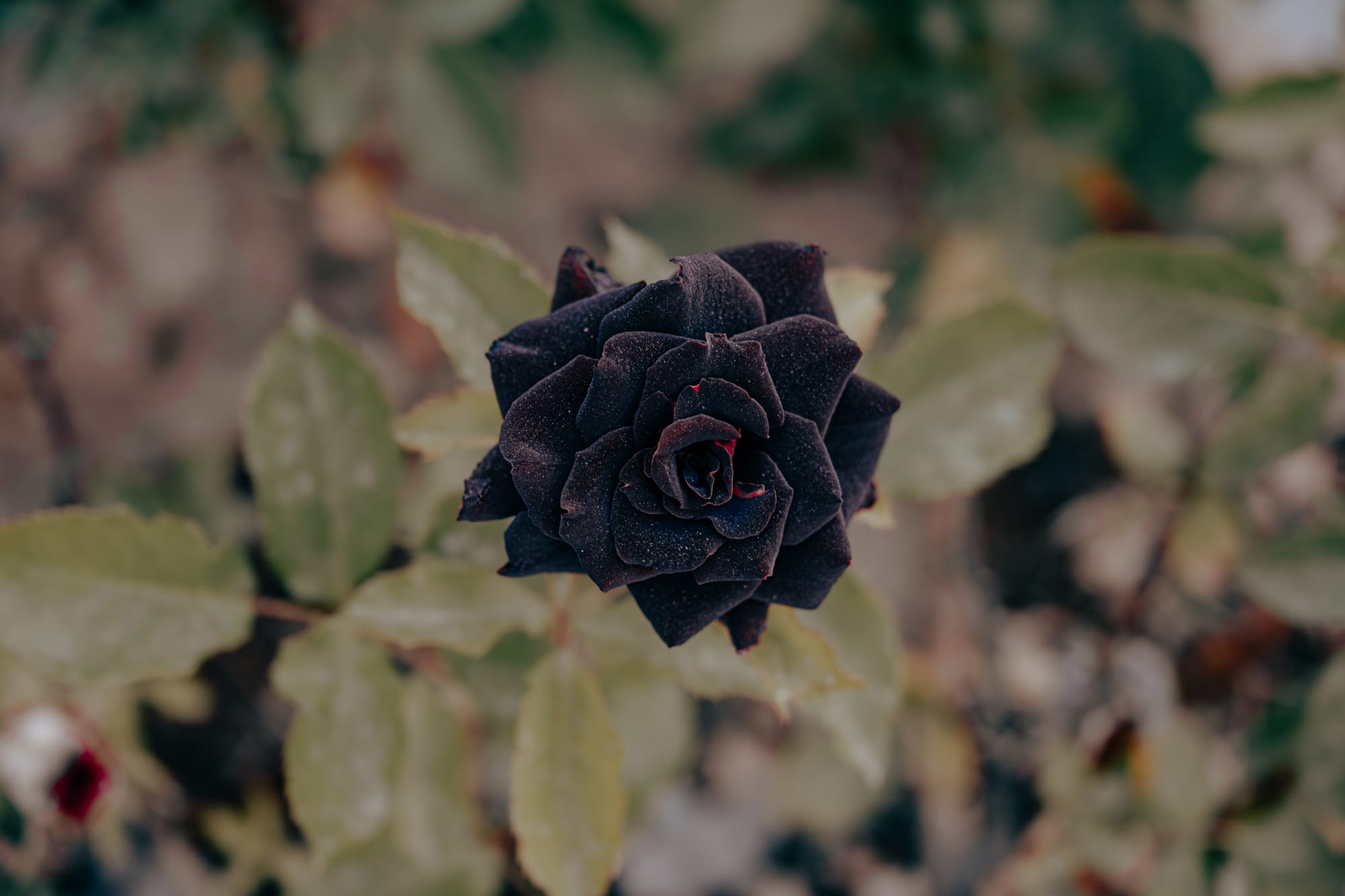
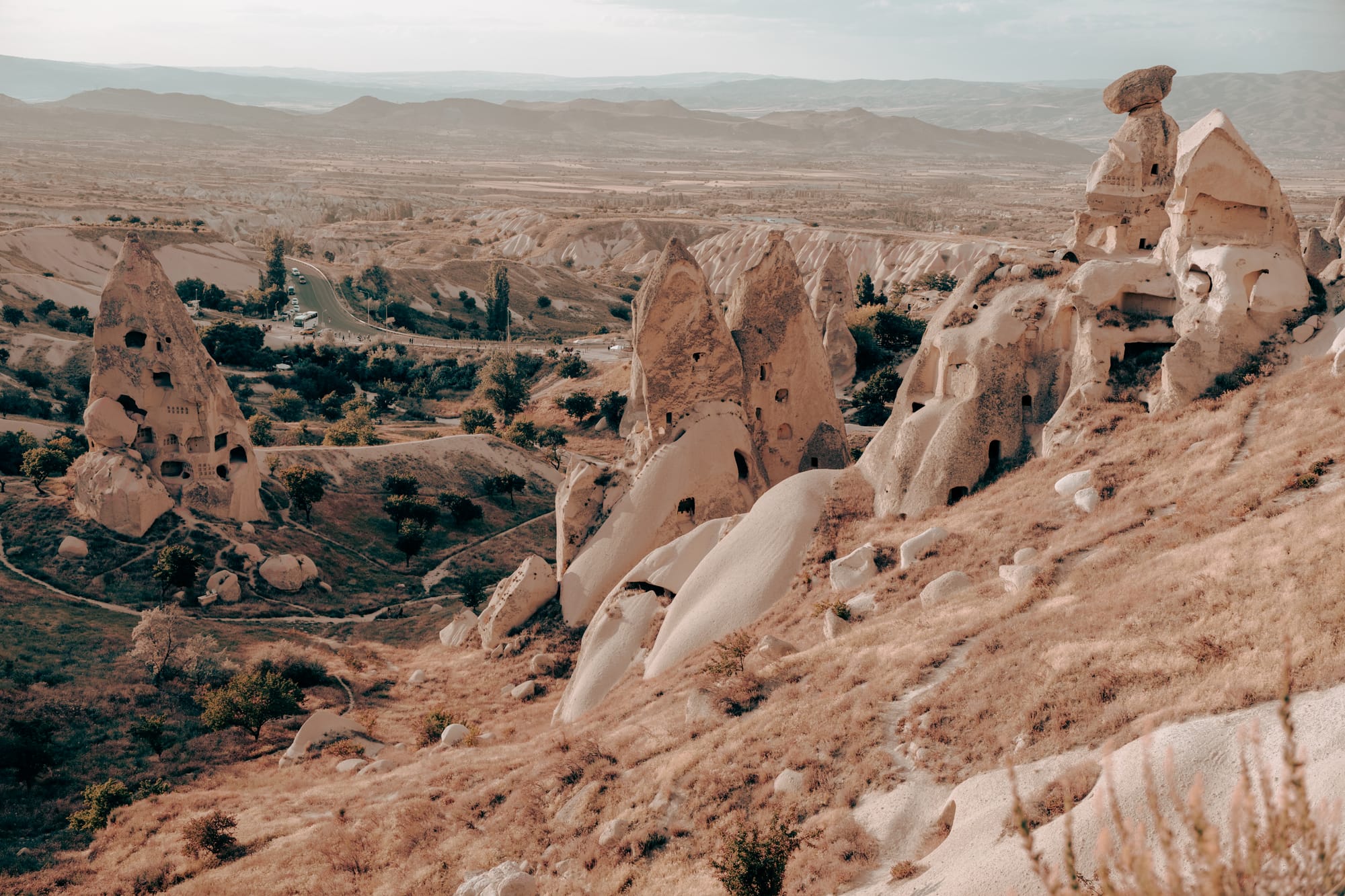
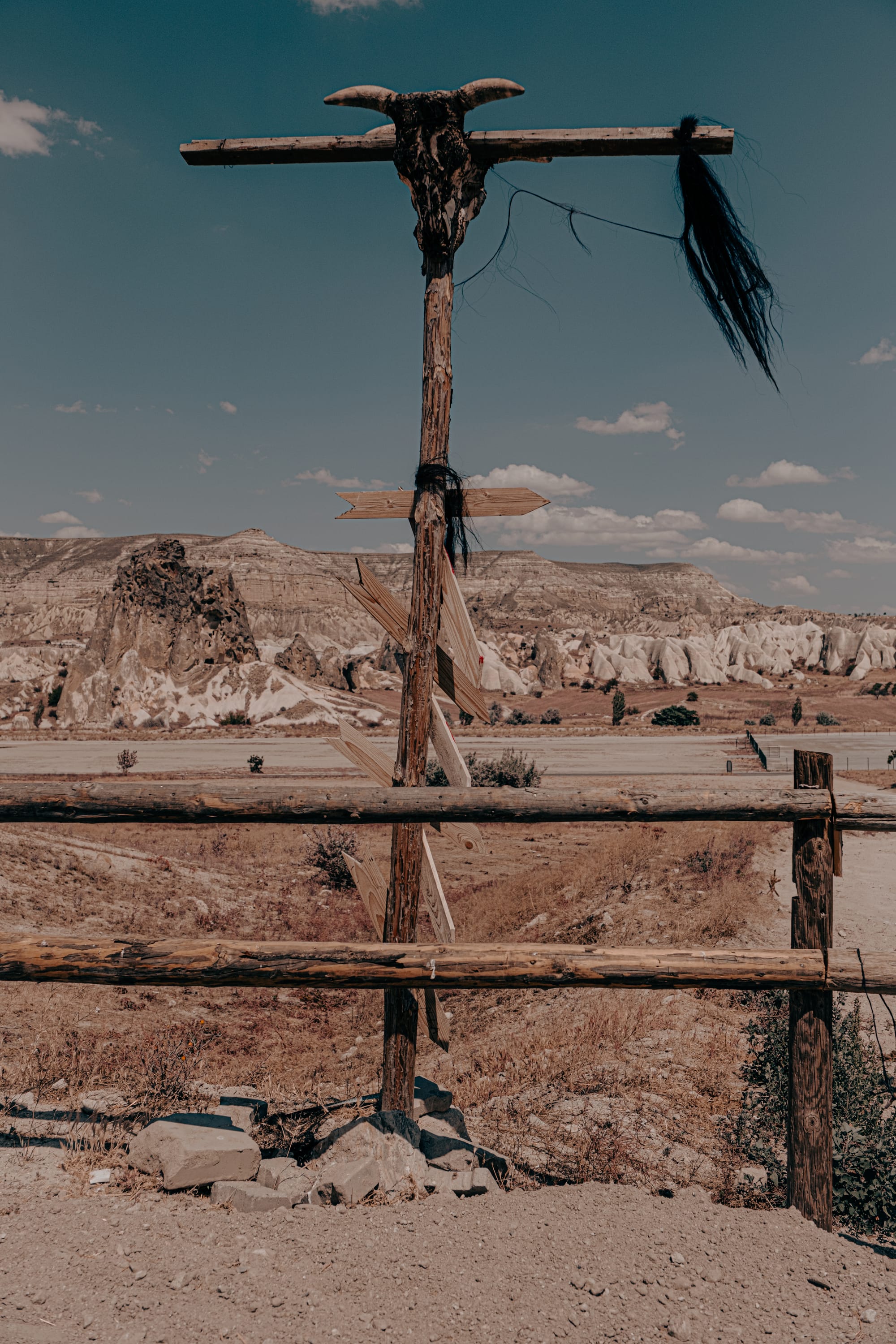
What makes Cappadocia distinct isn’t just the scenery—it’s the scale of what’s available. There are hikes you can do every single day for a month without repeating the same trail. There are underground cities the descend deep beneath the surface, hidden cave churches still carrying faint frescoes, and ridgelines where you’ll be completely alone at sunset despite the crowds elsewhere.
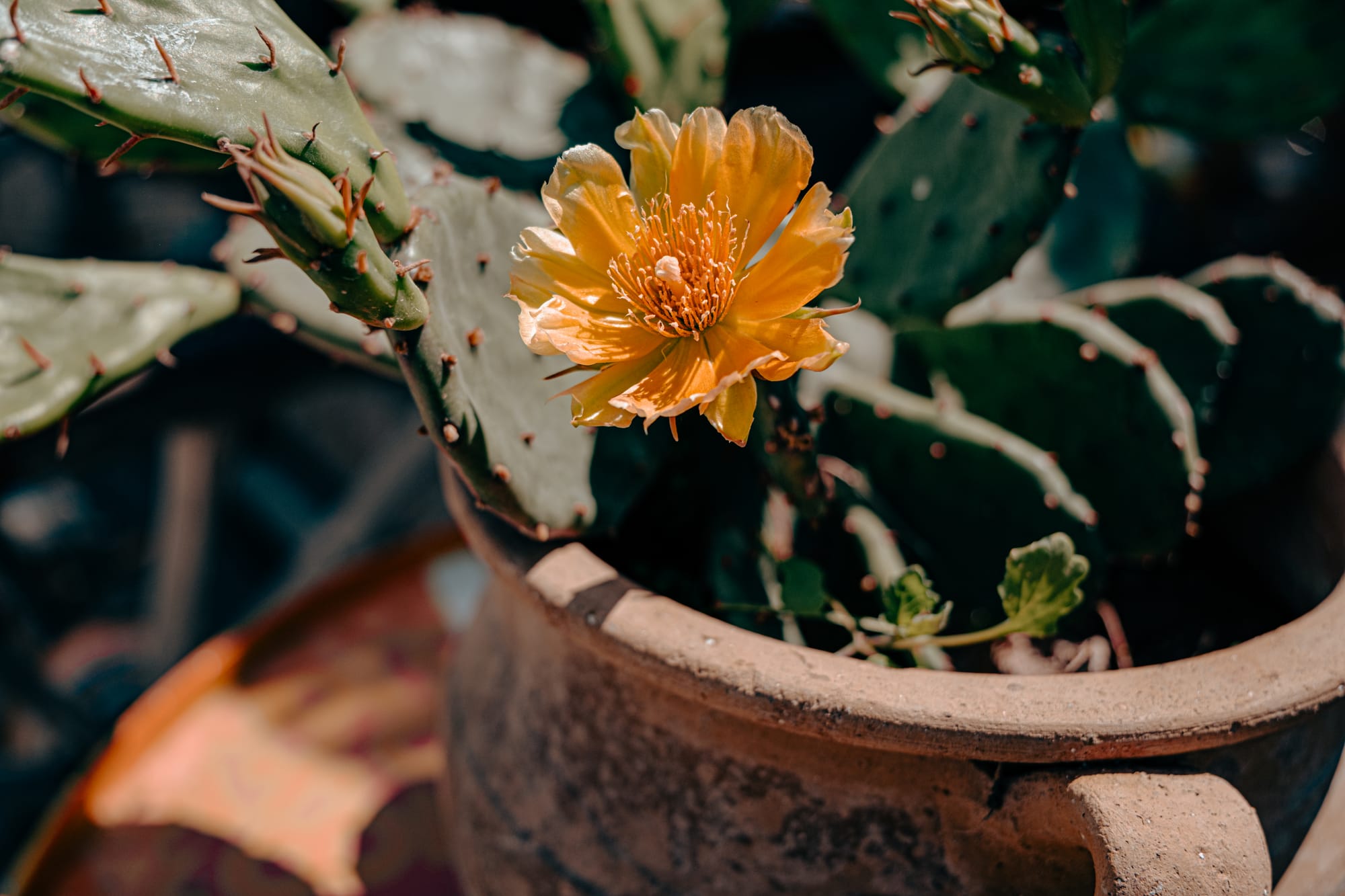
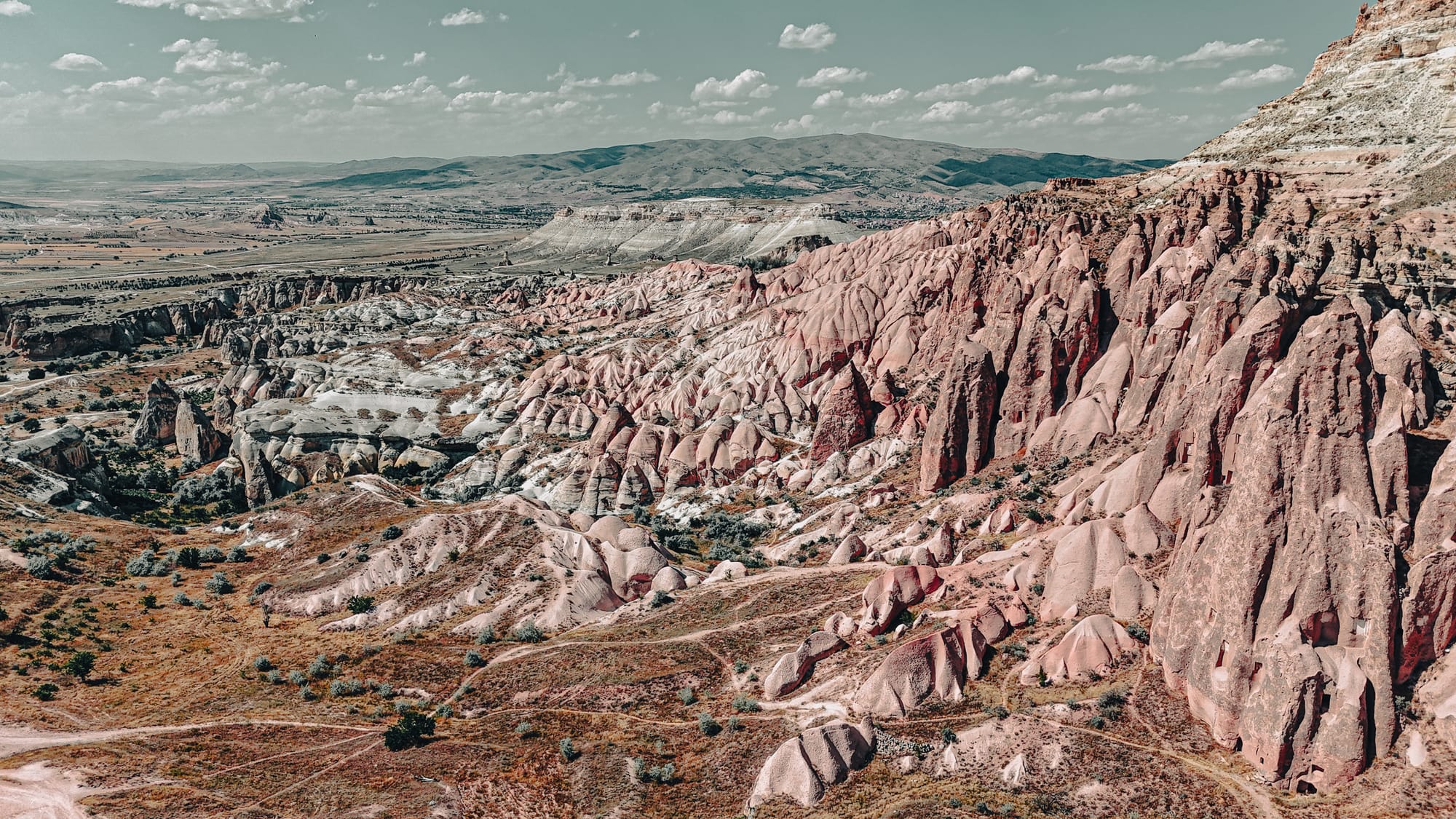
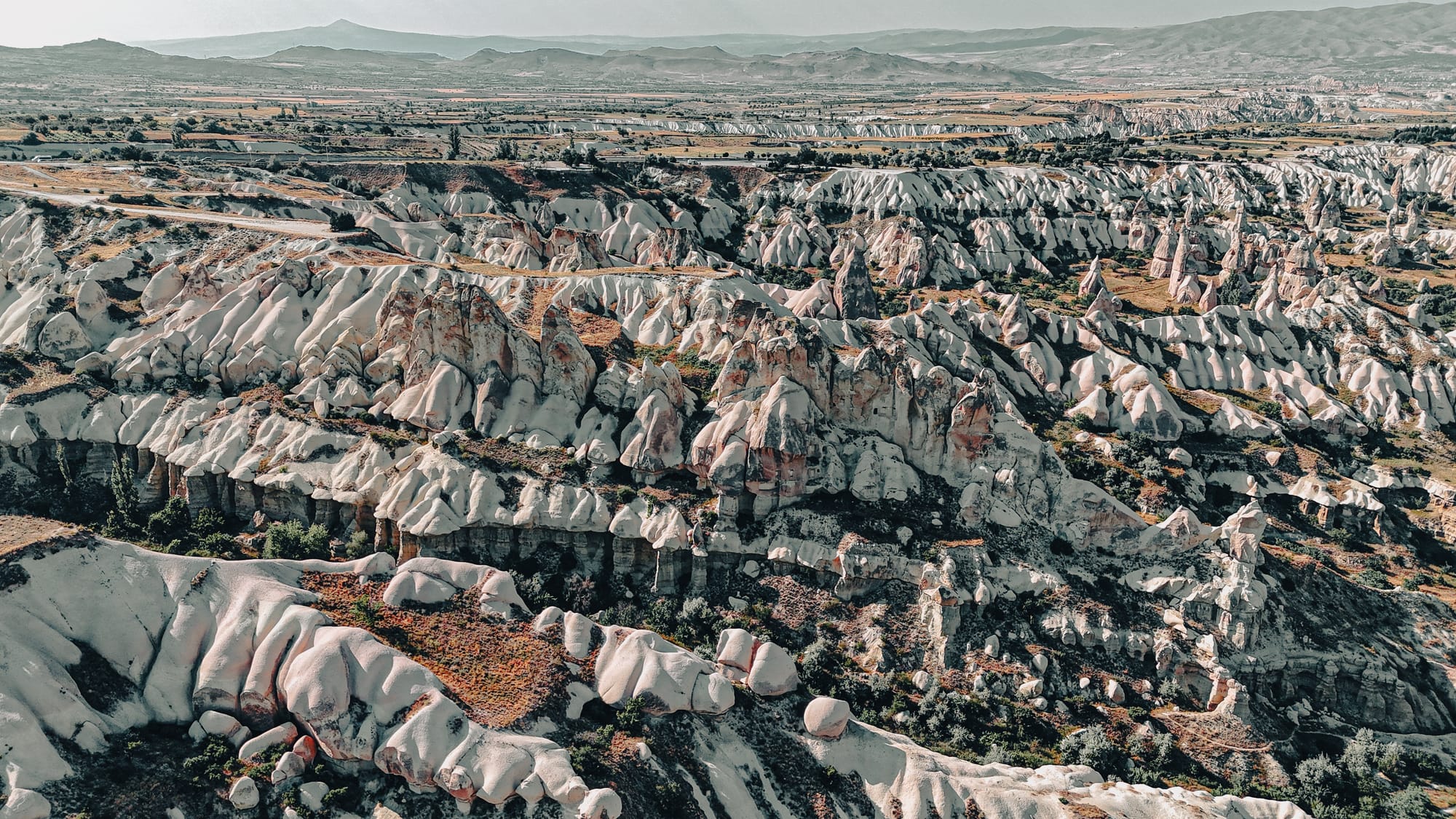
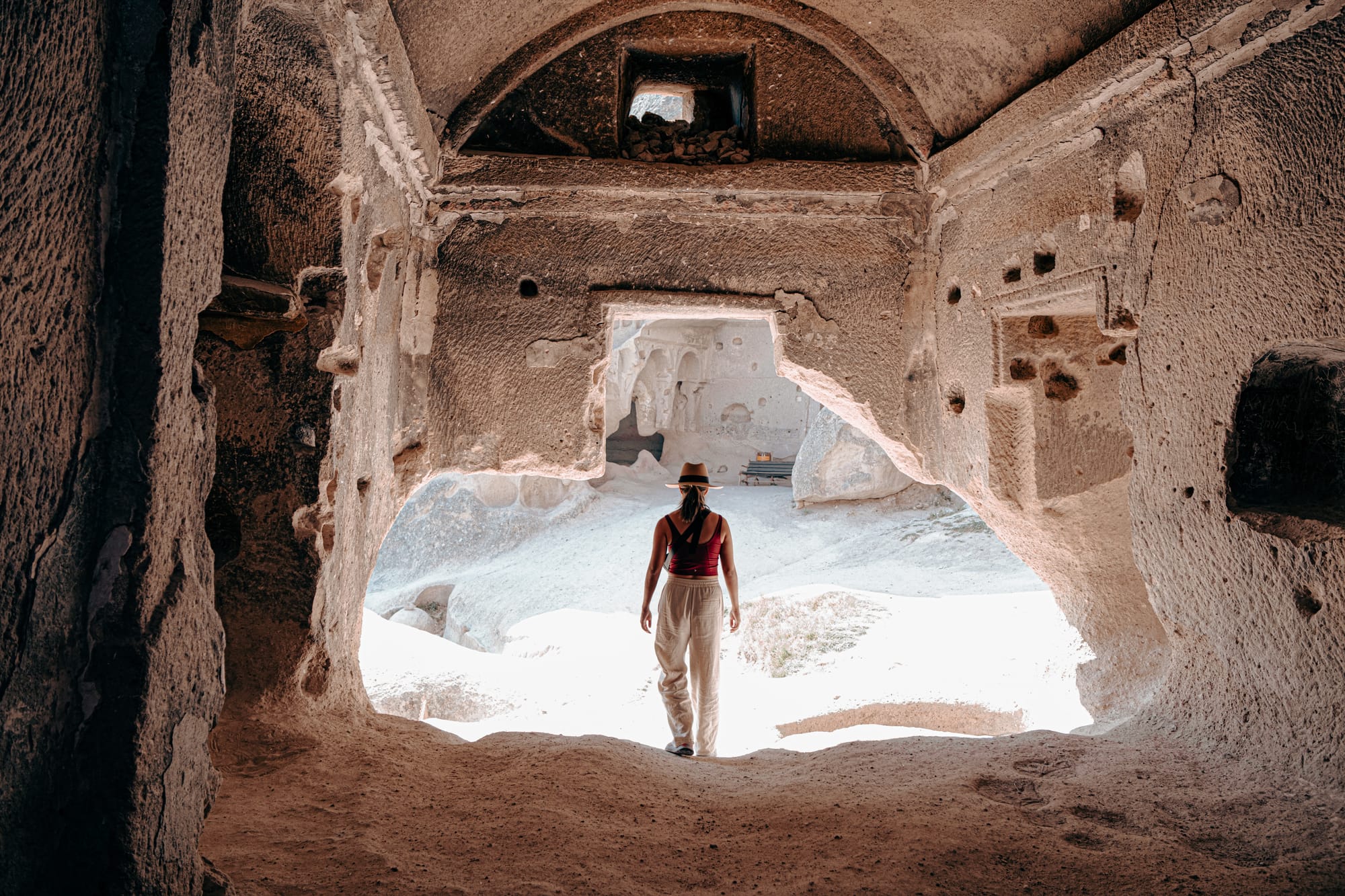
Unlike curated nomad hubs, Cappadocia does not have great remote work infrastructure. While you can certain find places with decent wifi, it can indeed be a challenge sometimes. But the real gift here is outside: the ability to step straight from your workspace into a labyrinth of trails, canyons, and stone-carved history.
The valleys never end
In Cappadocia, the landscape isn’t something you “see once.” It’s an unfolding map that keeps pulling you deeper. Most visitors stay three days—long enough for a balloon ride, an underground city tour, and a sunset in Göreme. But if you stay longer, you realize just how inexhaustible it is. There are valleys you can hike for weeks without repeating a path: Red, Rose, Pigeon, White, Honey, Love, Ihlara—the list goes on. Each one shaped differently, each one holding its own cave churches, hidden frescoes, or quiet ridgelines where you won’t see another person.
The scale of it changes your sense of time. What looks at first like a backdrop for tourism becomes a daily practice—walking new trails, tracing the soft stone with your hands, noticing how light shifts across the cliffs. Evenings settle into silence, but mornings pull you out again: another valley to wander, another ridge to climb.
And then there’s the strangeness. The hot air balloons that rise every dawn, floating silently above the fairy chimneys. The ridges shaped like waves, the pillars that look like they were sculpted for another planet. At some point, all of this resets your sense of normal. You begin to expect the surreal, to take note of the ways stone has been shaped not just by wind and water, but by centuries of human hands carving homes, churches, and entire cities into it.
Part of what drew us here in the first place was an image from Shelter by Lloyd Kahn—a spread of Cappadocia’s rock-cut dwellings, these crazy conical structures just protruding from the earth with whimsical windows carved in. That image lodged itself in our imagination years ago, and when we finally arrived, it was startling to find it all around us. The imagery isn’t exaggeration—it’s everyday reality. You walk through it, sleep inside it, and work in its shadow.
When to go
The best months to visit Cappadocia are April through June and September through October. Spring brings green to the valleys, wildflowers scattered between the rocks, and warm but not overwhelming temperatures—perfect for hiking and long days outside. Early mornings are crisp but clear, and balloon flights are more likely to run on schedule.
July and August are the peak of summer: hot, dry, and busy. Daytime highs often push past 30°C, and popular valleys can feel crowded. It’s still possible to enjoy it—especially if you plan hikes early in the morning or closer to sunset—but midday heat can make long treks draining. On the plus side, skies tend to be consistently clear, which means balloons often fly.
September is one of the best-kept secrets here. The days are still warm, the crowds thin out, and the evening light over the tuff cliffs is golden. October brings cooler air, fewer tour buses, and moody skies that make the valleys even more photogenic. It’s one of the most atmospheric months for photography and for slower hiking days.
November through March is Cappadocia’s off-season. Winters are cold—sometimes snowy—and many guesthouses, restaurants, and tour operators scale back. That said, the snow-dusted fairy chimneys are surreal, and the region feels quieter and more local. If you’re here to do deep work with occasional weekend hikes, winter can be a rewarding (if stark) time. Just expect shorter days, limited balloon flights, and fewer open cafés.
Our advice on the best time to be in Cappadocia
If you’re coming to work remotely and explore on weekends, aim for April–June or September–October. The weather is mild, the skies dramatic, and you’ll have energy left for hikes after work.
If you’re here mainly for the balloon experience, late spring and early autumn offer the best balance of flyable days and comfortable weather.
If you’re into hiking and photography, October and April are unbeatable—quiet trails, softer sunsets, and moodier skies.
If you’re looking for solitude and don’t mind the cold, December–February will give you snow-dusted valleys and the rare chance to see Cappadocia without the crowds.
No matter when you go, pack for layering. Mornings and evenings can be surprisingly cool, even in summer—and you’ll be outside more than you expect.
Getting to and from Cappadocia
Cappadocia doesn’t have its own big-city airport, but it’s well connected by two nearby ones: Nevşehir Kapadokya Airport (NAV) and Kayseri Erkilet Airport (ASR). Both receive daily flights from Istanbul and Ankara, and Kayseri also has routes from Izmir and sometimes Antalya. From Istanbul, flights take about 1 hour 15 minutes, and tickets are usually affordable if booked in advance.
From Nevşehir, it’s a 40-minute drive to Göreme, Ürgüp, or Uçhisar. From Kayseri, expect closer to 70–90 minutes. If your accommodation doesn't offer pick-up, we'd recommend booking a shared shuttle in advance–this is the one we booked.
If you’re already traveling in Turkey, Cappadocia is also reachable by intercity bus. Overnight buses run from Istanbul (10–12 hours), Antalya (9–10 hours), and Ankara (4–5 hours). Turkish buses are generally comfortable, with reclining seats, charging ports, and tea/coffee service, making them a viable low-cost option if you want to skip flying.
For nomads weaving Cappadocia into a longer route, the region pairs naturally with Istanbul (as a gateway hub), Antalya (for a coast-and-valleys contrast), and Ankara (with fast onward trains across Turkey). Some even combine Cappadocia with Georgia or Armenia by flying through Kayseri or Istanbul as a jumping-off point.
Working remotely from Cappadocia
Cappadocia isn’t a coworking destination. Most nomads here work from their guesthouse, hotel, or apartment rental, where wifi is generally reliable enough for calls and standard remote work. If strong, consistent internet is critical for you, it’s worth messaging your accommodation in advance to confirm speeds.
There are a handful of laptop-friendly cafés in Göreme and Ürgüp, but they’re more geared toward travelers than long-stay workers. Expect good Turkish coffee or tea, a quiet corner in the afternoon, and friendly staff, but not the plug-and-play infrastructure of bigger cities.
The rhythm here naturally leans toward deep work mornings and exploratory afternoons. The setting seems to inspire early work hours followed by heading into the valleys for hikes or sunset walks.
If you don’t need daily coworking events, the region can be a productive base—one where the view from your desk is often a stone ridge or a hot air balloon floating past at dawn.
Digital nomad community
Cappadocia doesn’t have a digital nomad community. There are no coworking spaces, no colivings, and no regular meetups. Even though we stayed a night at the Nomads Cave Hotel in Göreme, we didn’t actually meet any nomads. Most people you’ll encounter here are short-term travelers—passing through for a balloon ride or a few days of hiking before moving on.
That said, Cappadocia has all the raw ingredients of a future nomad hub. The region is packed with things to do: endless hikes, underground cities, cave churches, and unreal sunsets. It’s the kind of place you could easily spend a month exploring without running out of new trails or experiences. We’re honestly surprised no one has built a proper coliving or coworking base here yet, because the potential is enormous.
For now, though, you’ll need to be comfortable on your own. If you’re someone who thrives on structured community, Cappadocia can feel isolating. On the flip side, this can open up space for different kinds of connection: long conversations with locals over tea, chance encounters with other travelers, and more presence with the place itself.
If you come here, don’t expect a plug-and-play nomad scene. Expect instead a frontier—one where you might be among the first to imagine what a community here could look like.
Cappadocian culture
Cappadocia’s culture is inseparable from its land. For centuries, people have carved their homes, churches, and entire cities out of volcanic rock—creating a way of life that feels both ancient and continuous. Villages are dotted with stone houses, narrow lanes, and small squares where neighbors gather for tea. The call to prayer drifts across valleys, echoing against the cliffs and fairy chimneys.
Daily rituals remain simple and rooted. Fresh bread from the bakery, pomegranates and apricots at the weekly market, tea served in small tulip glasses whether you’re in a shop, a courtyard, or a bus station. Hospitality here is generous: strangers often invite you for çay, and conversations unfold easily, especially outside the tourist core.
Tourism is undeniably central to Cappadocia today. Balloon flights, day tours, and souvenir shops dominate towns like Göreme. But beneath that surface, local rhythms carry on. Farmers still tend vineyards and orchards on the valley floors. Shepherds guide flocks through the ridges. Families gather for weddings that fill entire streets with music, food, and dancing. If you stay longer than a few days, you begin to notice these quieter layers—the ones that most visitors miss.
Cultural life also turns with the seasons. Summer brings outdoor weddings and evening gatherings in courtyards. Autumn is marked by grape harvests and long walks through cooling valleys. Winter, when the snow falls, slows everything down—tourist crowds thin and locals retreat into tea houses, bakeries, and homes, where the warmth of hospitality feels even more vivid.
Horses are central to Cappadocia. The very name "Cappadocia" is thought to mean “the land of beautiful horses,” and riding has been part of life here for centuries. Ranchers still work the land with small herds, and horseback treks through the valleys are both a livelihood and a tradition. Spend any time outside the main towns and you’ll see horses grazing on ridges, a reminder that this is not just a landscape of stone but also of ranching rhythms—where land, animal, and human have long been intertwined.
Cappadocia is not a metropolis; it’s a patchwork of small towns, villages, and landscapes shaped by both nature and tradition. Its culture is quieter, more understated than in Turkey’s big cities—but if you give it time, it reveals a rhythm of resilience, generosity, and deep connection to the land itself.
Psychogeographics
What does it actually feel like to live in Cappadocia for a month or more? Think dawn skies filling with hot air balloons, the sound of roosters in the villages, and stone ridges catching the first light in shades of pink and gold. This is a place where mornings might begin in a quiet courtyard with tea, and end on a cliffside watching the sun slip behind fairy chimneys that look more like sculptures than geology.
Cappadocia hums differently than a city—it’s slower, quieter, more elemental. The rhythm here comes from wind in the valleys. Days stretch between work at a guesthouse desk and long hikes through canyons where you might not meet another soul.
The palette is desert-soft: ochre and rose, dusty greens from orchards, and the deep blue of a sky that feels impossibly wide. Horses graze on ridges, shepherds move their flocks, and every step seems to reveal another carved doorway, another cave that was once home. At some point, the strangeness becomes ordinary—you stop being surprised that you’re living among conical towers of rock, and start feeling them as part of your daily horizon.
We wrote a full piece on the texture of life here: Cave homes and colorful balloons: digital nomad life in Cappadocia.
Where to stay
Cappadocia’s towns each have their own character. Göreme is the heart of the tourism scene, full of cafés, restaurants, and easy access to tours. It’s lively but can feel crowded and expensive. Uçhisar, perched higher up, is quieter and more local, with stunning views over the valleys and a slower pace. Both make good bases depending on what you’re after. We prefer Uçhisar as a base because it's cheaper and more relaxed.
Göreme
Staying in Göreme means being right in the middle of it all—cafés, tour pick-ups, and balloon launches at dawn. Great if you want convenience, walkability, and atmosphere.
Nomads Cave Hotel & Rooftop: A cozy cave stay just steps from shops and cafés. The rooftop terrace is the highlight, with sweeping views of town and hot air balloons at sunrise—perfect for slow mornings and photos.
Uçhisar
Uçhisar is calmer, less touristic, and known for its panoramic views from the castle. It’s a good base if you want quieter evenings, stronger connection to local rhythms, and easy access to nearby trails.
Karma Cappadocia: Stylish, contemporary design blended with stone architecture. Serene setting a short walk from Uçhisar Castle, great for catching sunrise or watching balloons drift across the sky.
Cappadocia Villa Comfort: Spacious rooms and warm hospitality within walking distance of the castle and viewpoints. A peaceful base with modern comfort.
Moonlight of Cappadocia: Elegant stone rooms and a quiet atmosphere near the castle. Ideal if you want to soak in the landscapes but stay outside Göreme’s bustle.
Aysultan Stone House: Traditional stone rooms with modern touches (including desks). Easy walk to cafés, trails, and viewpoints.
Charming Villa in Cappadocia: A six-bedroom property perfect for groups or DIY coliving. With a communal kitchen, plenty of space, and each room fitted with aircon, it’s a strong choice for nomads traveling together.
The best things to do in Cappadocia
Cappadocia is overflowing with things to do—but what stayed with us most weren’t just the balloon rides or the headline tours. It was the scale and strangeness of the valleys, the quiet of cave churches tucked into cliffs, and the way each hike opened up to something unexpected: a fresco, a pigeon house, a ridgeline at sunset.
This list gathers our personal highlights—experiences we’d happily return for. Some are iconic, others are smaller, slower, or less expected. Most have their own full posts if you’d like more detail, photos, or tips.
Our advice: don’t try to tick it all off in a few days. Cappadocia is a place that rewards staying longer. Pick the hikes and experiences that speak to you, and let the valleys keep unfolding.
Red, Green, and Blue Tours
If you spend any time in Göreme, you’ll quickly hear about Cappadocia’s famous Red, Green, and Blue tours. These guided day trips are designed to cover the region’s spread-out landmarks without you needing to arrange transport yourself. Each one follows a set route, combining natural landscapes with cultural sites, and most include lunch and transport from your hotel. If you want to learn more, check out our full post where we break down what each tour includes.
Many of the activities we recommend throughout this guide are covered in these tours. If you prefer independence, you can piece these experiences together on your own. But if you’re short on time, don’t want to rent a car, or simply like the ease of having a guide explain the context, these tours can be an efficient way to see a lot in a single day.
Hikes and valleys
Guided hike through Red & Rose Valleys
Cappadocia’s most vivid landscapes, painted by light.
Red and Rose Valleys are a labyrinth of ridges, caves, and rock formations that change color with the day—soft pink in the morning, golden by afternoon, and a deep, glowing crimson at sunset. Trails wind past fairy chimneys, hollowed pigeon houses, and rock-cut chapels with fading frescoes, offering a blend of natural wonder and human history at every turn. Even a short walk delivers a sense of Cappadocia’s scale, with ridgelines opening suddenly to panoramic views across the plateau.
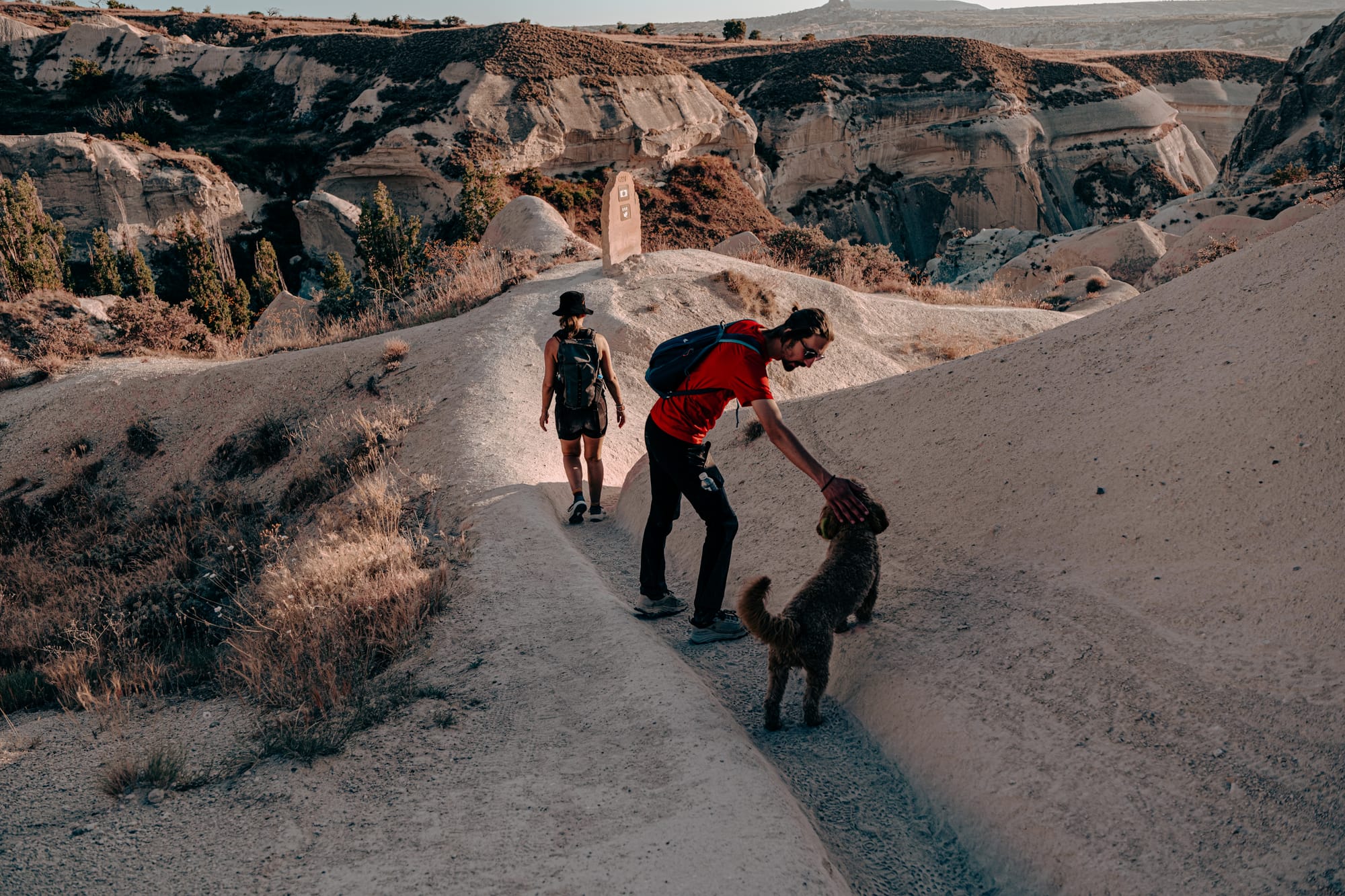
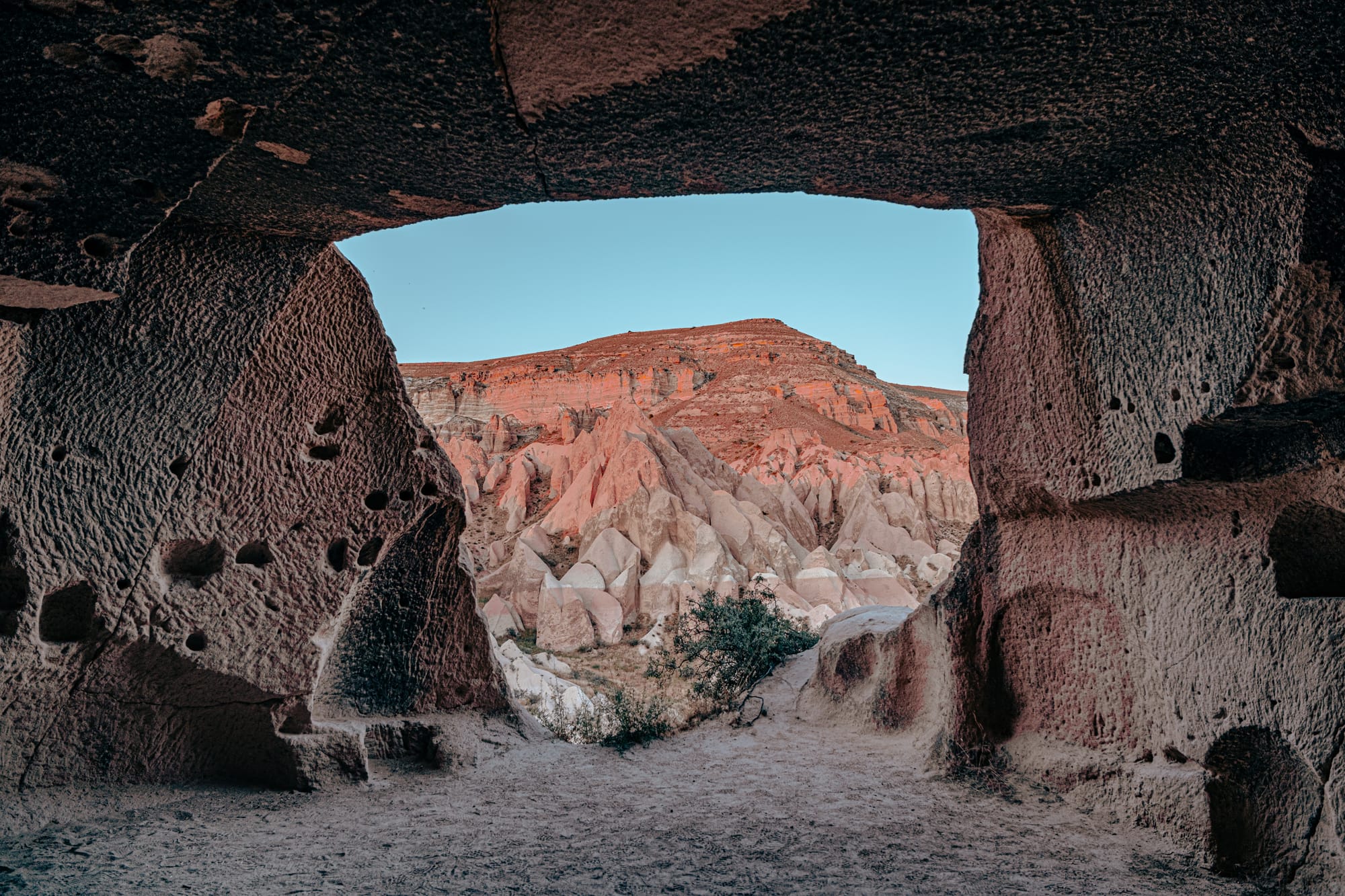
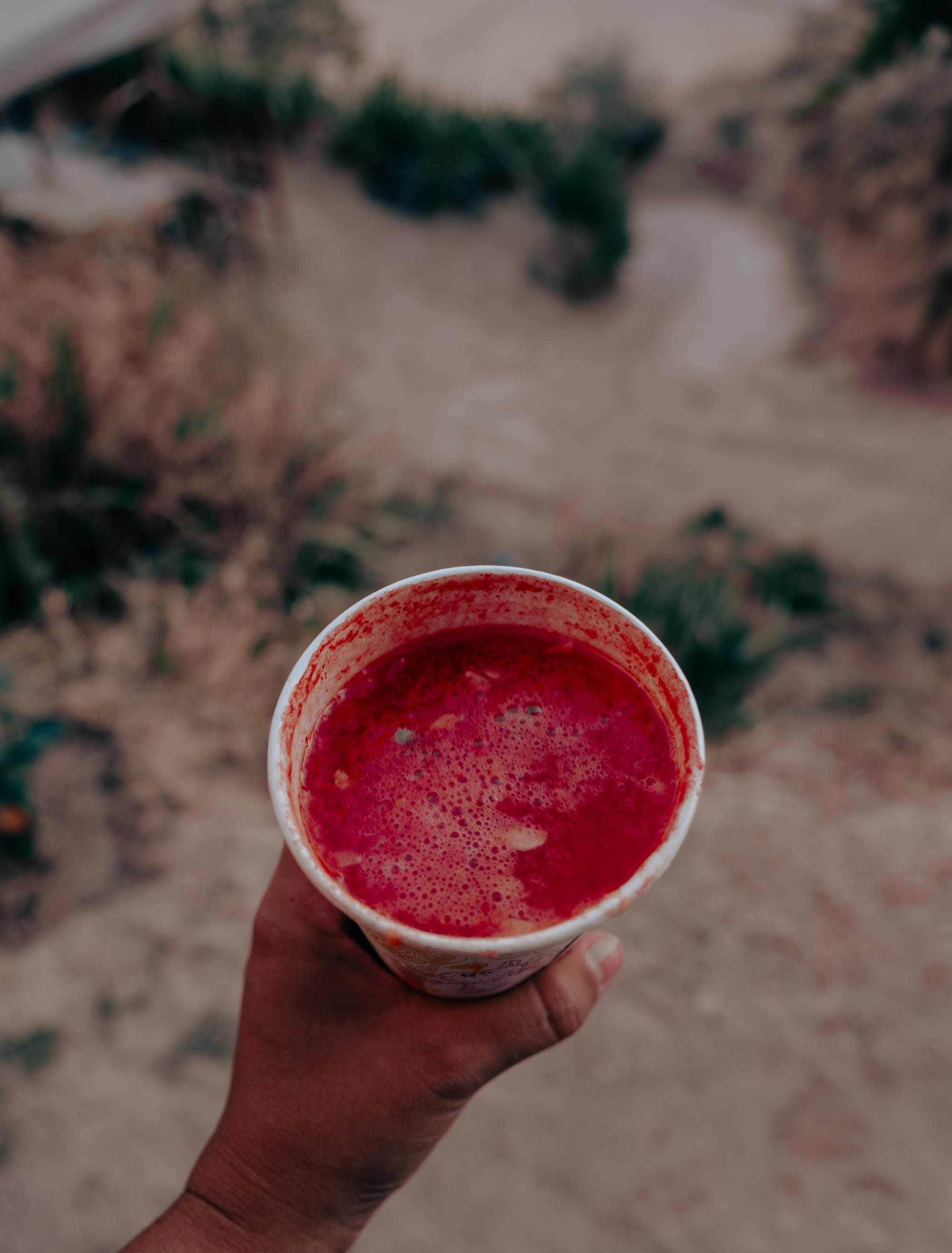
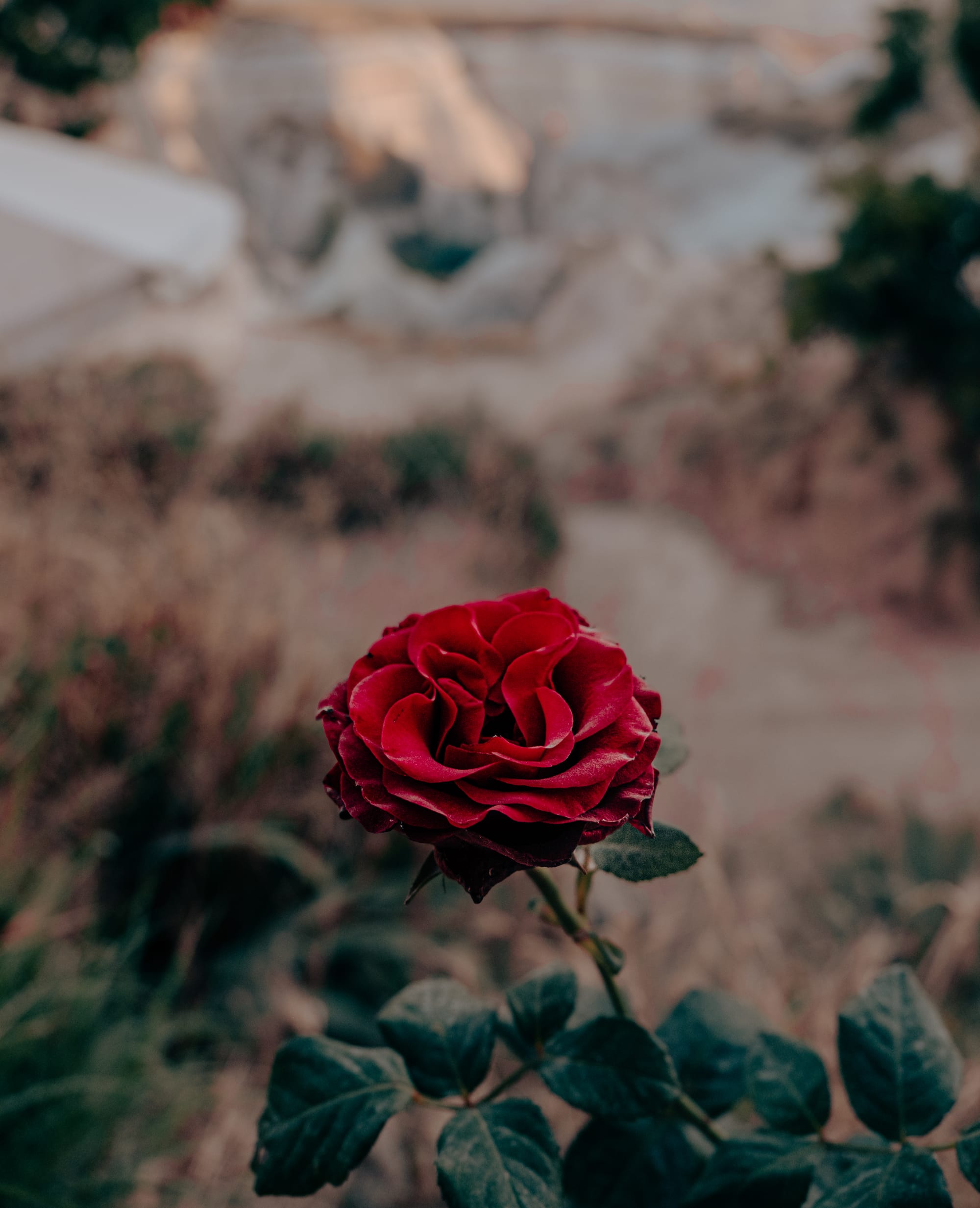
Unlike other valleys you can see in an hour, Red and Rose reward time. Paths split and rejoin, leading you through vineyards tucked into folds of stone and quiet corners where you might not meet another soul. Stay for the evening light, when the cliffs seem to catch fire, and you’ll understand why these valleys are considered the most beautiful in the region.
Guided hike through Pigeon, White, Honey, and Love Valleys
A winding journey through Cappadocia’s most storied canyons.
These interconnected valleys stitch together some of Cappadocia’s most distinctive terrain. The trail begins in Pigeon Valley, where dovecotes carved into the cliffs once provided fertilizer for vineyards. From there, paths flow into White Valley, marked by smooth, pale cliffs, and then into Honey Valley, quieter and less traveled, where orchards and cave dwellings nestle in the folds of stone. The route often finishes in Love Valley, where the towering rock pillars create one of the region’s most surreal and iconic sights.
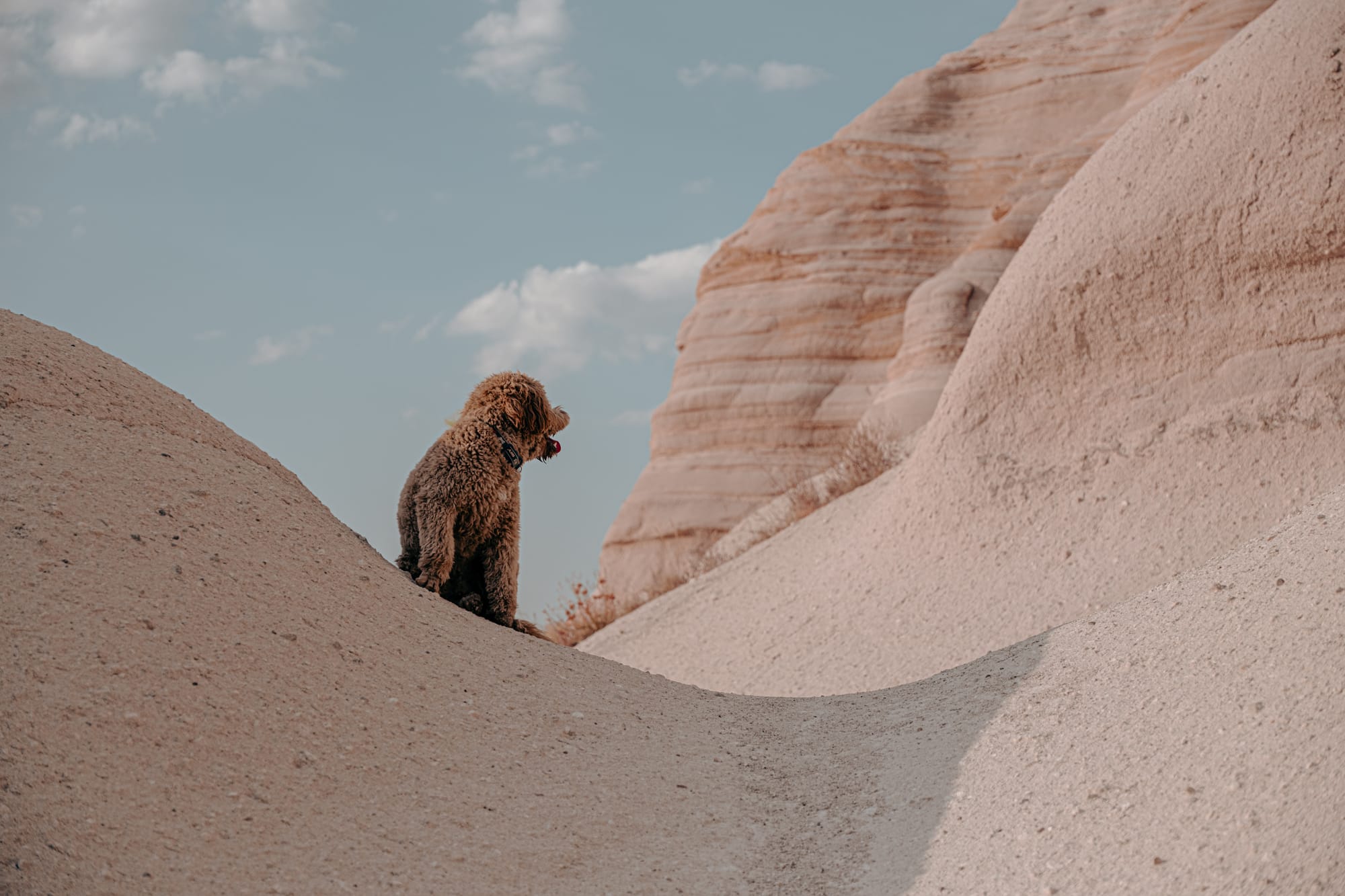
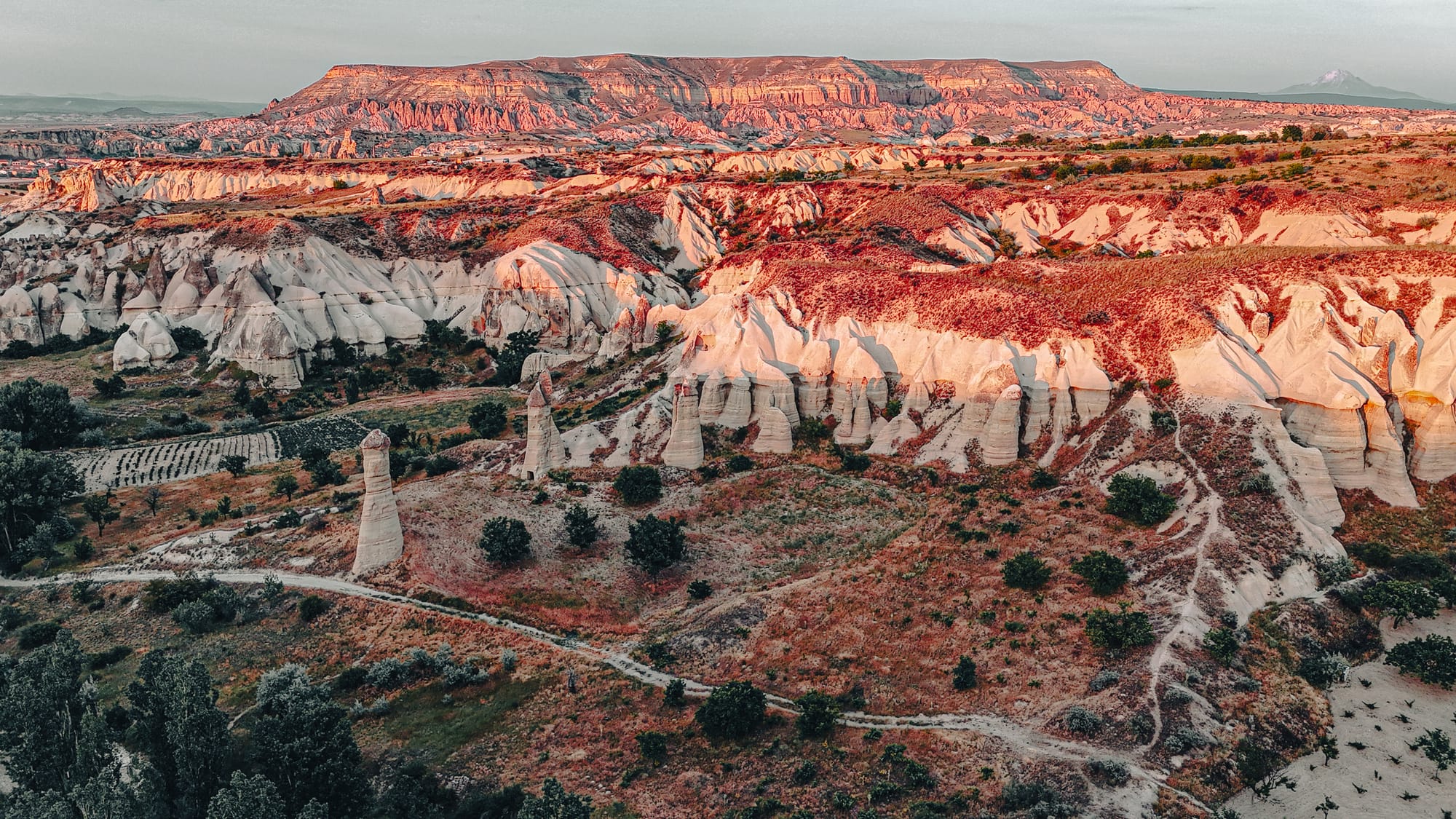
While each valley has its own character, taken together they form a hike that captures Cappadocia’s breadth: history, agriculture, and geology woven into a single day’s walk. Going with a guide can reveal details you’d otherwise miss—stories of how pigeon houses sustained local life, the hidden chapels tucked into cliff walls, or the best ridges for catching a sunset view.
Guided hike through Ihlara Valley
A river canyon carved with hidden sanctuaries.
Unlike Cappadocia’s smaller valleys, Ihlara feels vast—its gorge stretching nearly 14 kilometers, carved deep by the Melendiz River. The trail follows the water past poplar trees, carved steps, and cave churches etched into the canyon walls, some still carrying vivid frescoes after centuries. The greenery here is striking, a lush contrast to the surrounding plateau, and the sound of the river makes the valley feel alive in a way few other hikes in the region do.
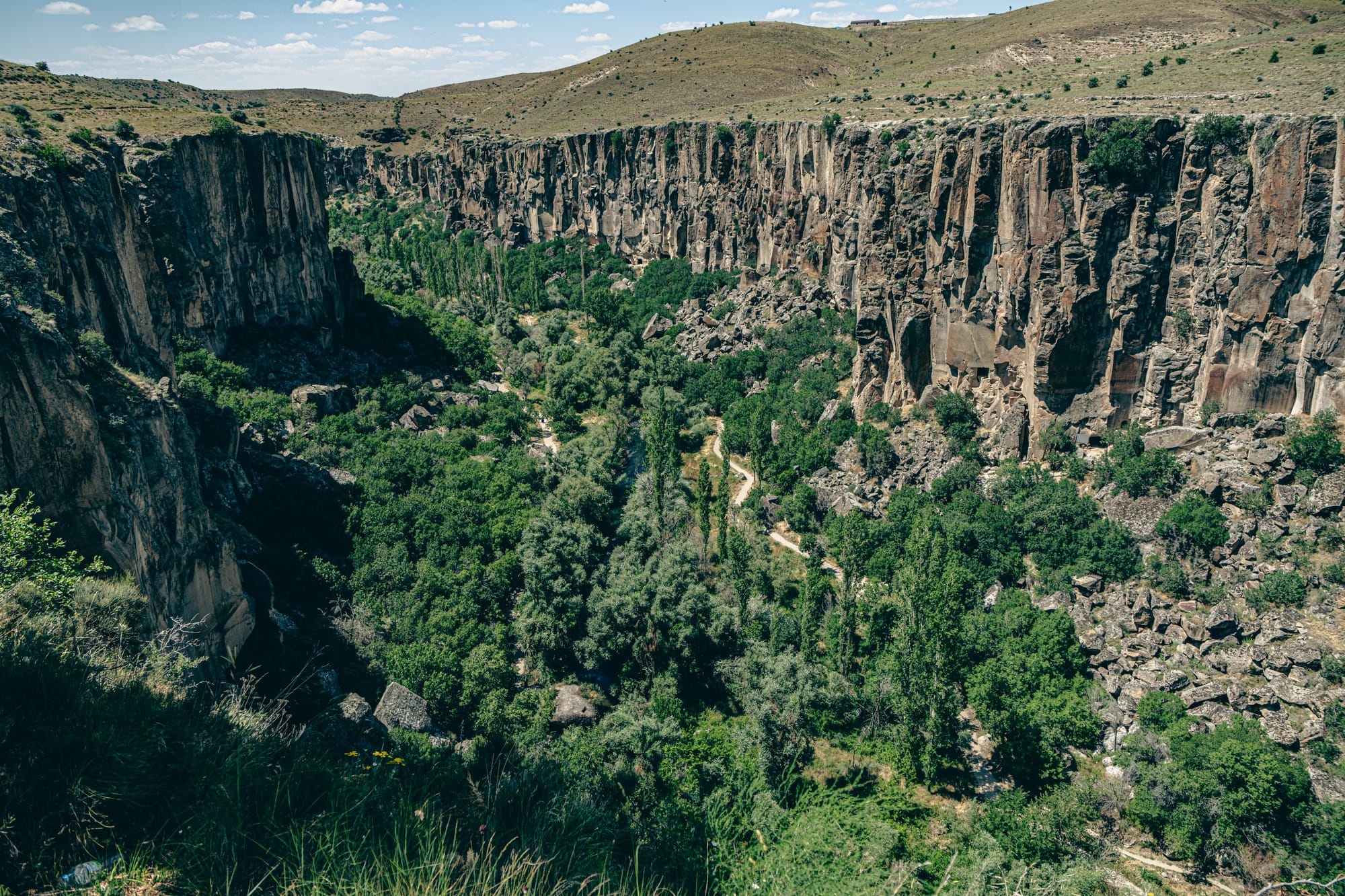
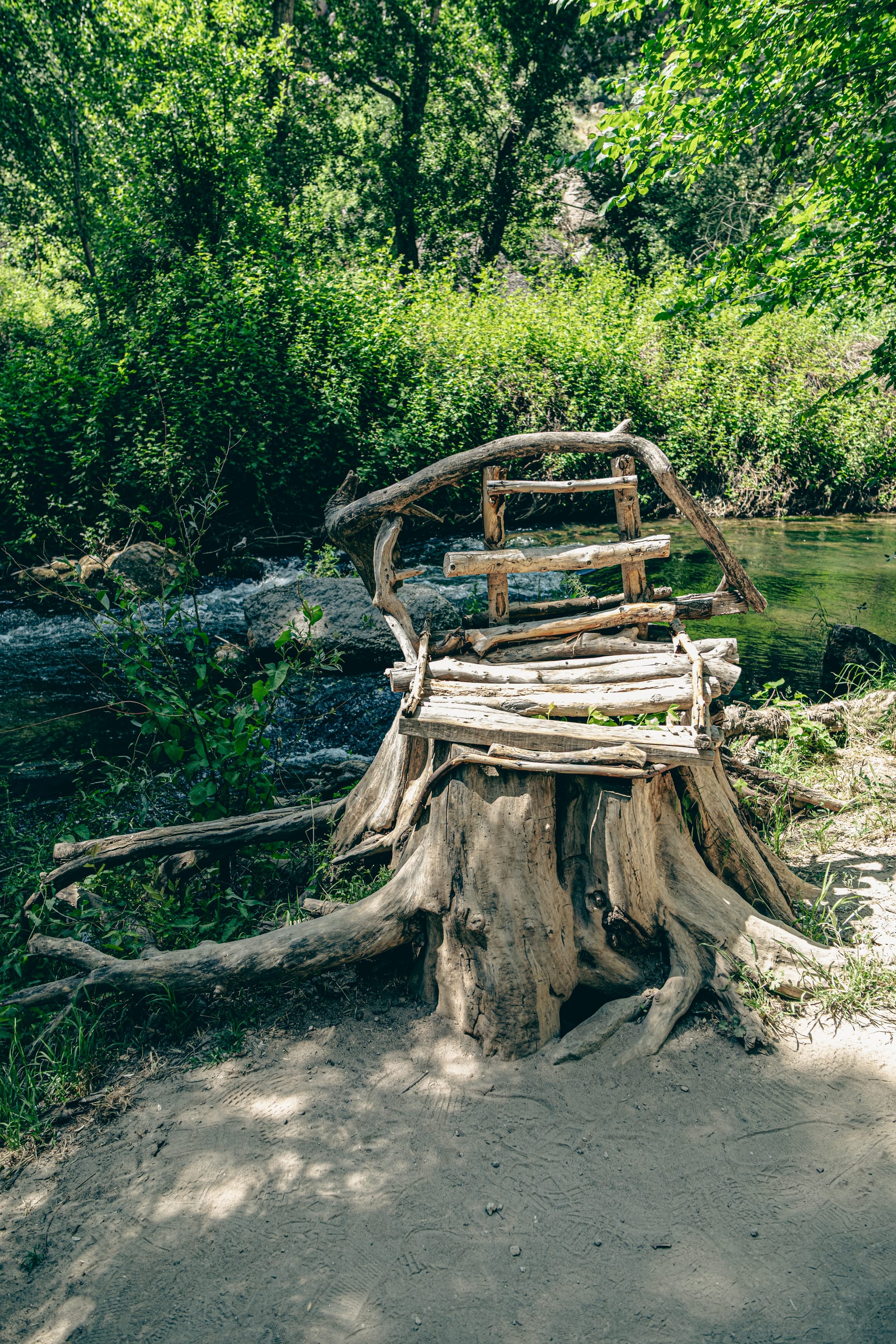
Walking Ihlara is less about dramatic ridges and more about rhythm: stone staircases down into the canyon, quiet chapels tucked away, and riverside tea gardens where you can pause and rest. Whether you hike the full length or just a section, it offers a rare sense of scale and solitude. For many, it’s one of the most surprising parts of Cappadocia—a reminder that this landscape isn’t only desert-like, but also fertile, layered, and filled with hidden traces of human devotion.
Paşabağ (Monks Valley)
Land of mushroom-shaped fairy chimneys.
Paşabağ is where Cappadocia’s famous rock formations reach their most striking form—tall, clustered fairy chimneys with multiple caps stacked like stone mushrooms. Once home to hermit monks, the valley still holds chapels and hermitages carved directly into these formations, including the cell of Saint Simeon. Walking among them feels otherworldly, as if you’ve stepped into a natural cathedral sculpted by wind and time.
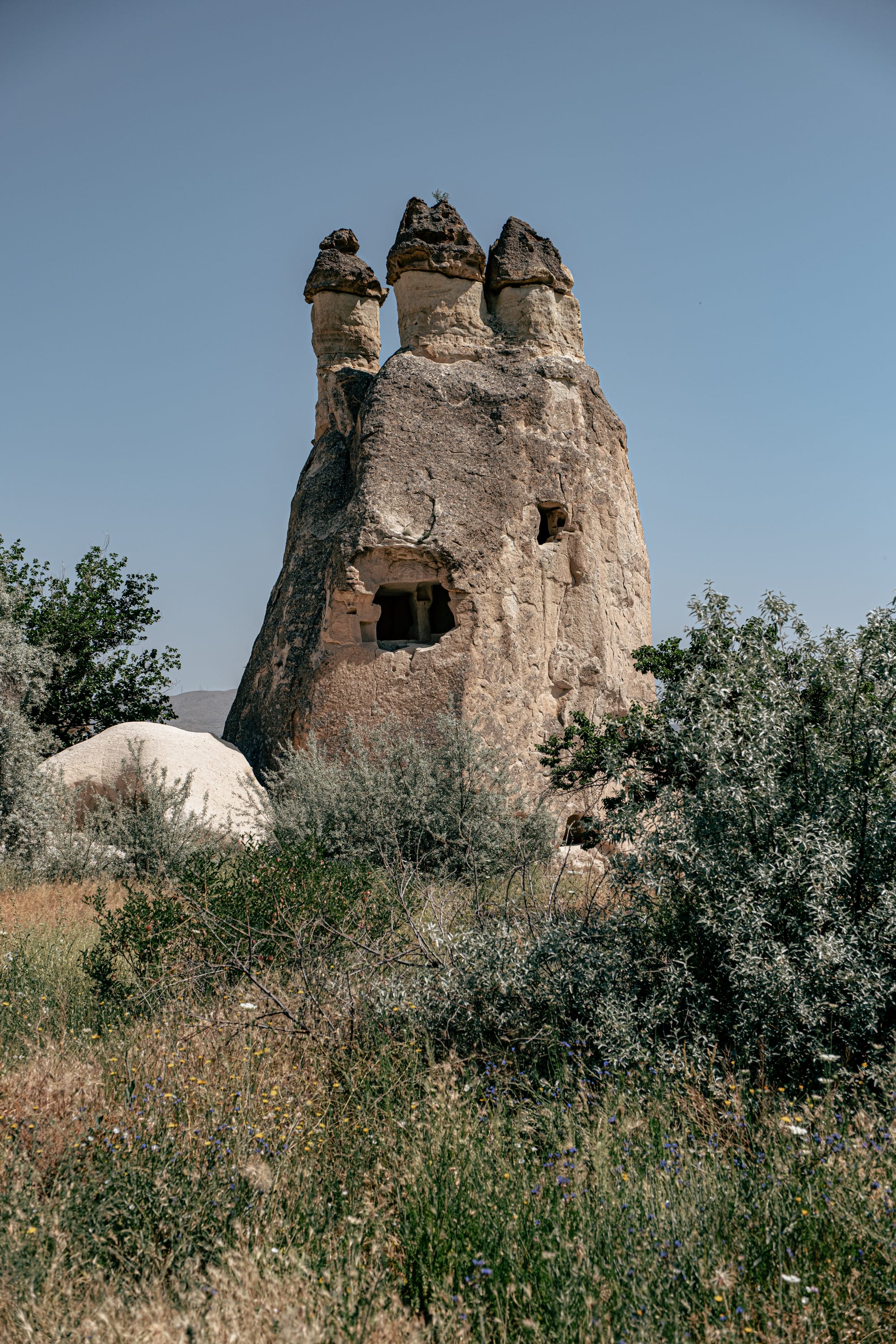
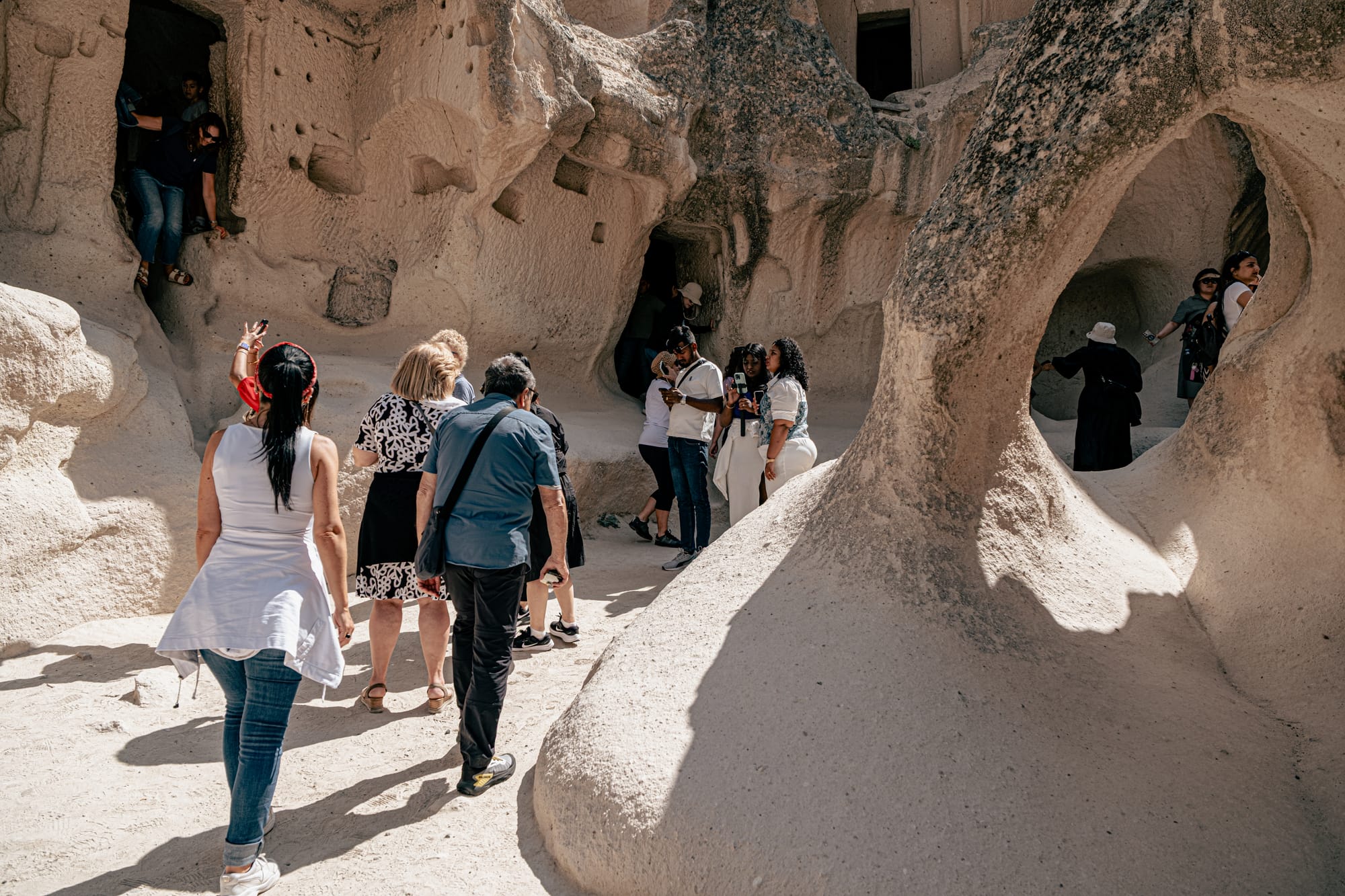
It’s one of the more popular sites in Cappadocia, but the scale and density of the formations make it worth the crowds. Arrive early or near sunset to wander more quietly, when the light softens and the rocks glow. Even if you’ve seen fairy chimneys elsewhere, Paşabağ is singular—the place where Cappadocia’s surreal geology is condensed into its most iconic shapes, a reminder of why this landscape has drawn both devotion and awe for centuries.
Hiking trails around Uçhisar Castle
Valleys unfolding beneath a stone crown.
From the base of Uçhisar Castle, a web of trails radiates into some of Cappadocia’s most striking valleys—Pigeon, White, and Love among them. Starting in the shadow of the castle, you can descend quickly into paths that weave between fairy chimneys, orchards, and dovecotes carved into cliffs. Each trail offers a different perspective on the fortress above, its jagged silhouette rising like a watchtower as you wander further into the landscape.
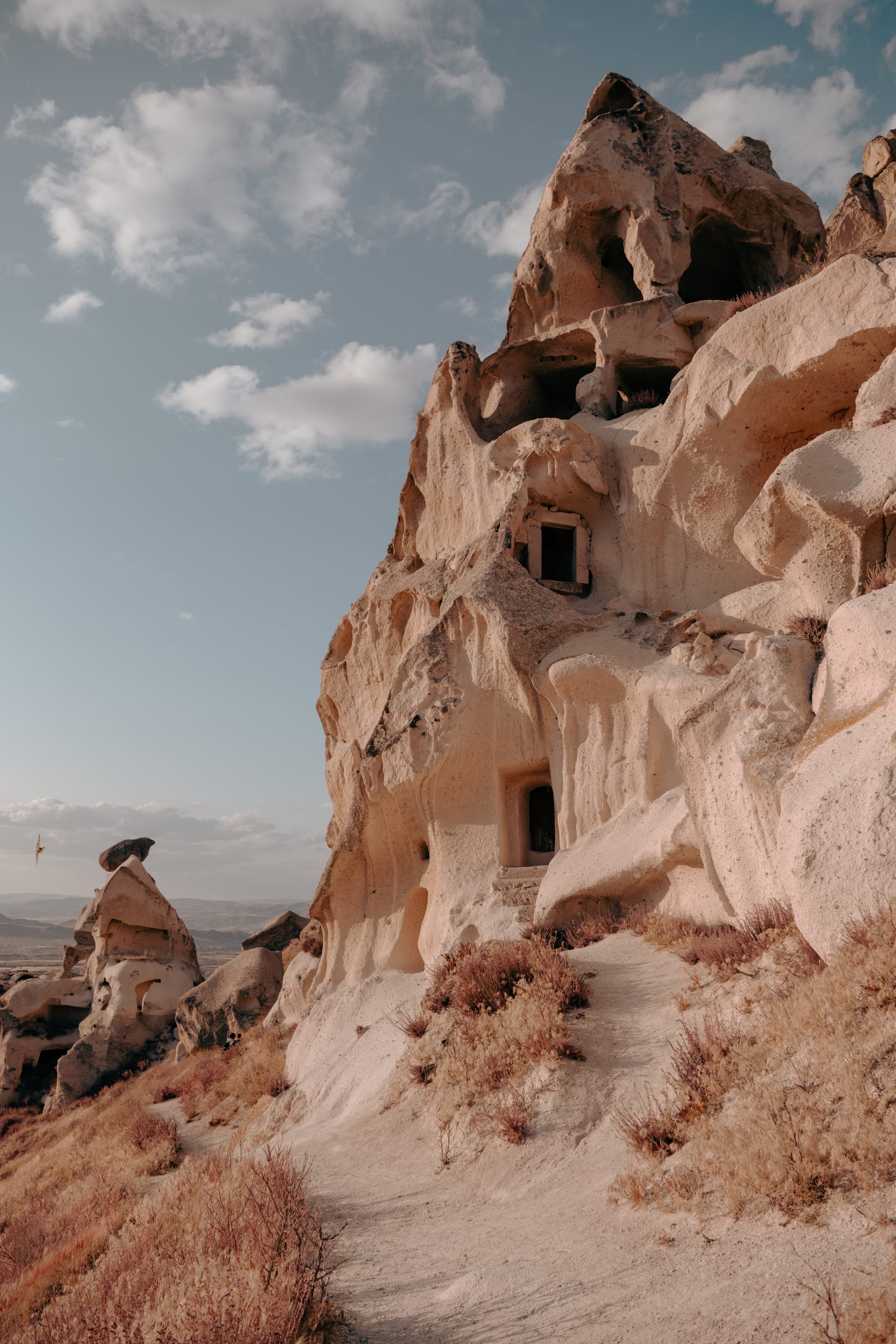
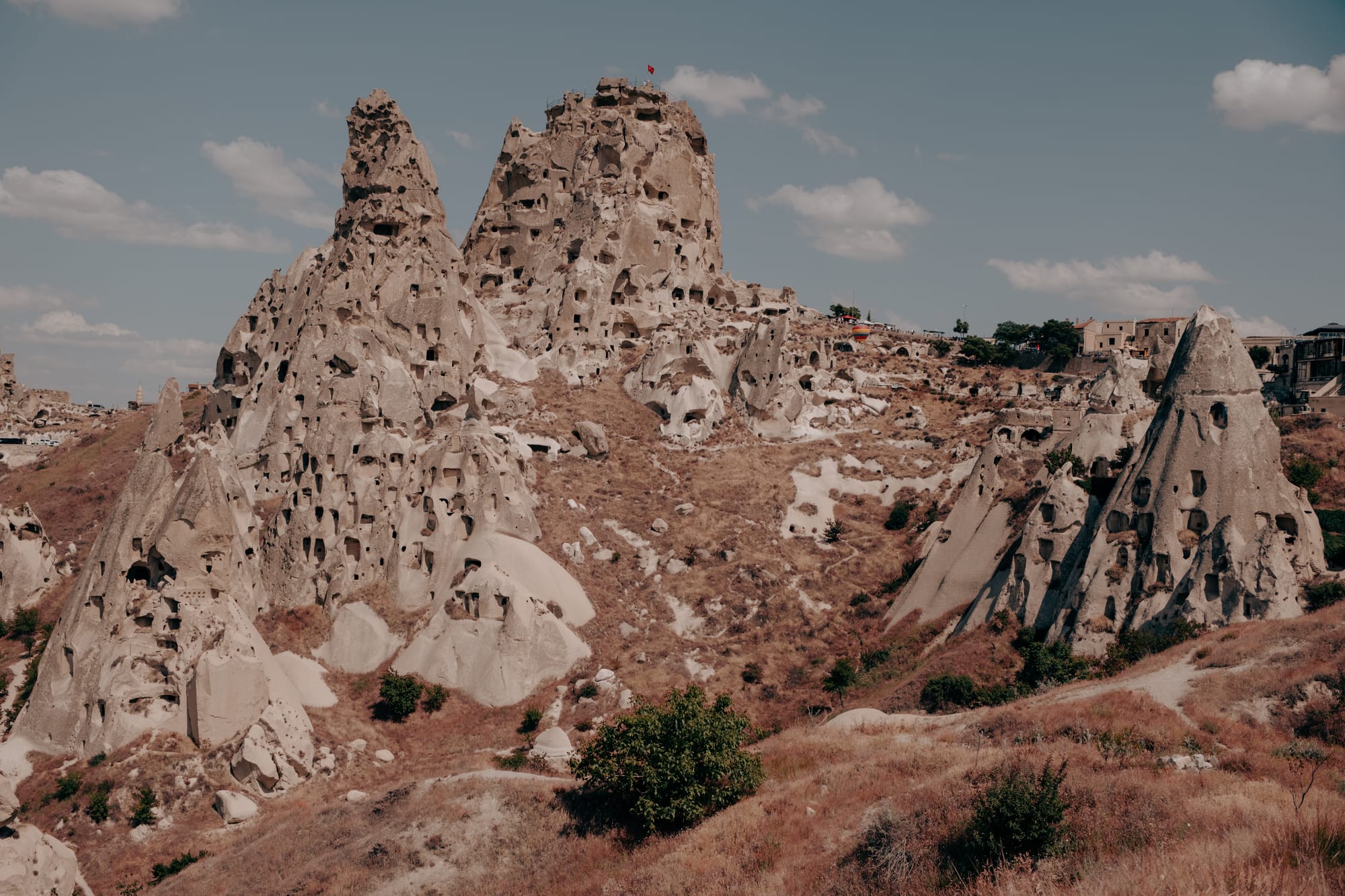
The beauty of these routes is their variety: short, easy walks that loop back to town, or longer hikes connecting Uçhisar with Göreme and other valleys. The trails are rarely crowded, and it’s easy to find yourself alone beneath ridges that glow pink at sunset. Hiking here blends the monumental with the intimate—Cappadocia’s vast scale held in view from the castle, and its quieter details revealed in the folds of the valleys below.
Underground cities
Derinkuyu Underground City
A subterranean world of refuge and resilience.
Derinkuyu is the largest of Cappadocia’s underground cities, a vast network of tunnels, chambers, and passageways carved deep into the earth. Extending as many as eight levels below ground, it once sheltered thousands of people—complete with kitchens, stables, wine presses, and even a school. The engineering is astonishing: ventilation shafts carried fresh air, rolling stone doors sealed passages, and water wells provided sustenance even in siege.
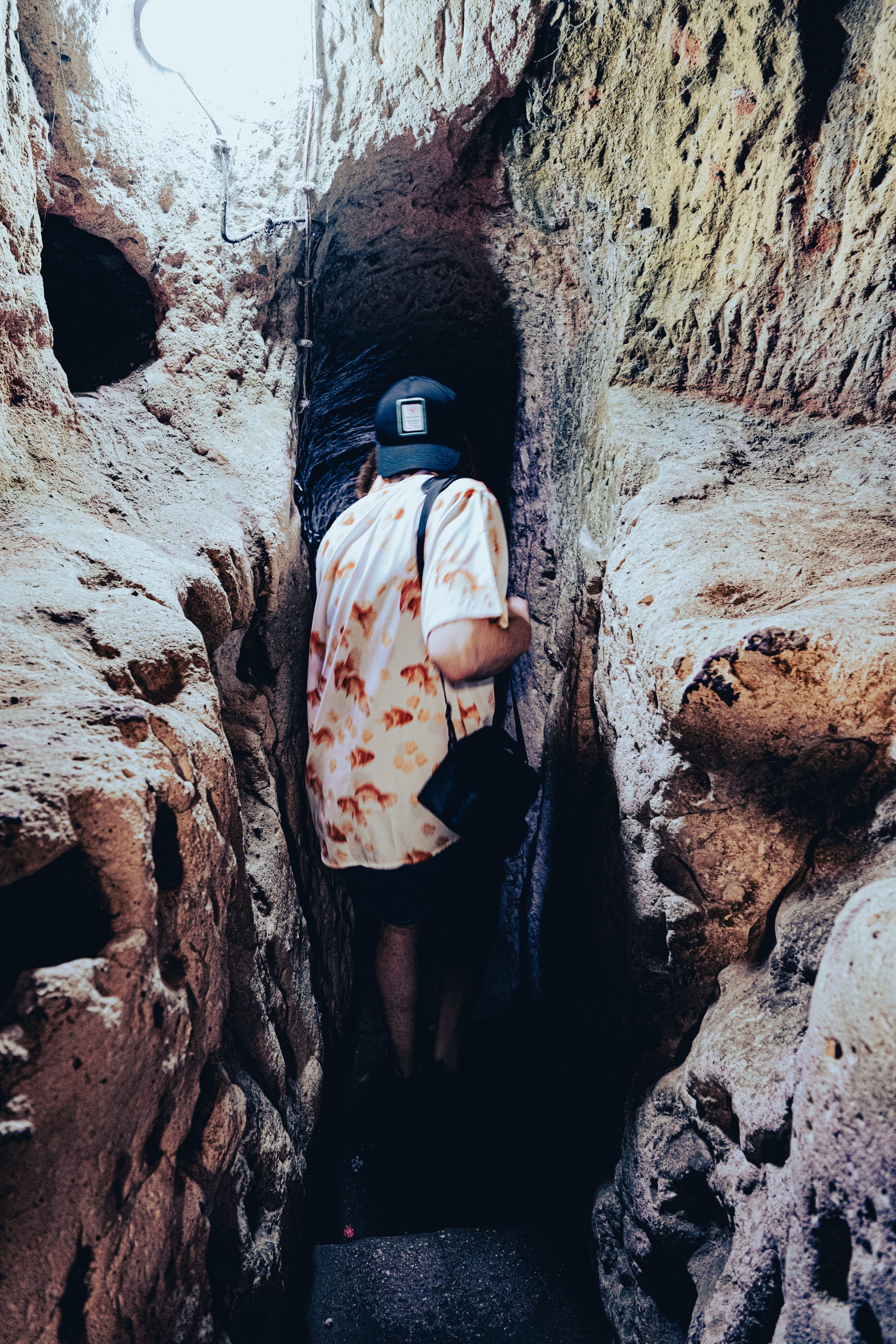
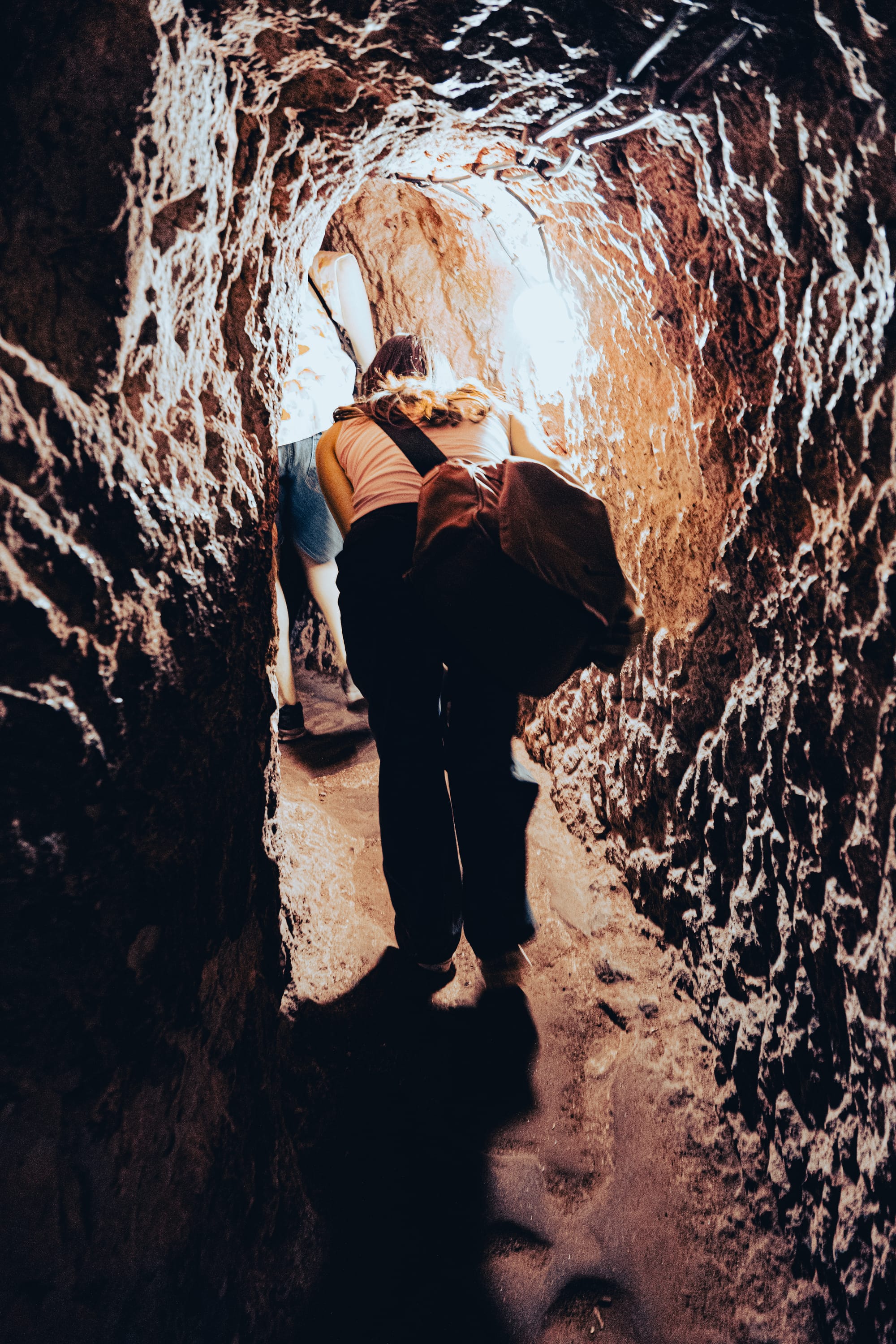
Exploring it today is both humbling and disorienting. Narrow stairways lead you deeper and deeper, until daylight feels far away and you start to sense the lives once lived in this subterranean refuge. While it can be busy with tours, the sheer scale of Derinkuyu sets it apart. It’s not just an archaeological site—it’s a testament to endurance, creativity, and the ways communities shaped their world beneath the surface to survive.
Özkonak Underground City
A hidden labyrinth with echoes of defense.
Smaller and less visited than Derinkuyu or Kaymaklı, Özkonak offers a quieter window into Cappadocia’s subterranean life. Built into volcanic rock, it extends across multiple levels, with narrow tunnels linking chambers that once housed families, animals, and supplies. What makes Özkonak distinctive are its defense features—long communication tunnels, hidden ventilation shafts, and heavy stone doors designed to seal off passages in times of danger.
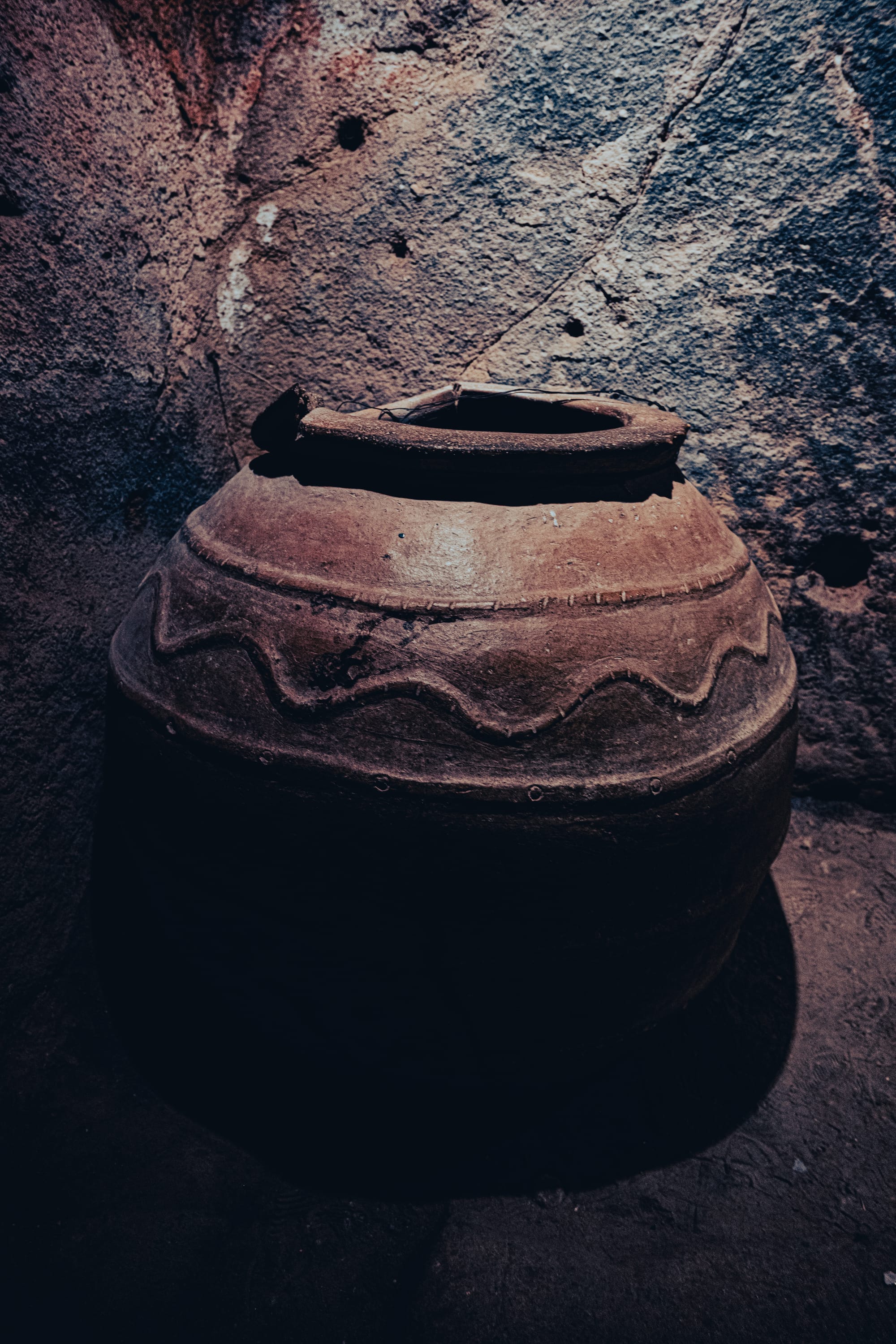
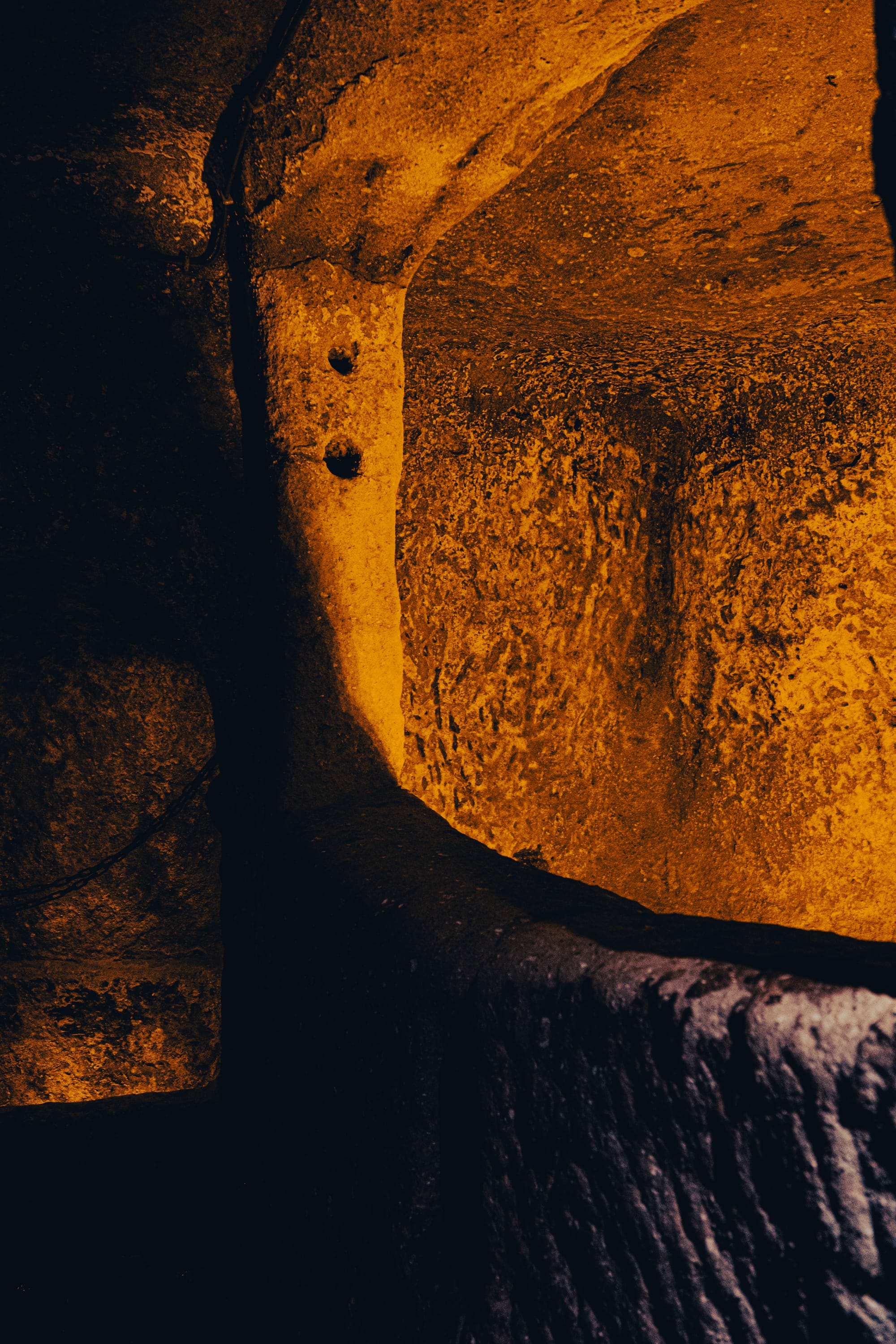
Because it’s off the main tourist circuit, exploring Özkonak feels more intimate. The spaces are tighter, the light dimmer, and the sense of history closer. You can imagine the urgency that led entire communities underground, and the ingenuity required to make these spaces habitable. It may lack the scale of Derinkuyu, but Özkonak carries a different kind of weight—a reminder that Cappadocia’s underground world was as much about survival as it was about shelter.
Iconic Cappadocian experiences
Hot air balloon ride
Cappadocia’s most iconic experience, seen from the sky.
At dawn, before the valleys are fully awake, hundreds of balloons rise together into the sky—an almost dreamlike choreography that has become synonymous with Cappadocia. From the basket, you float above fairy chimneys, vineyards, and canyon ridges, watching the rock shift in color as the sun climbs. The silence is striking: aside from the occasional burst of flame, there’s nothing but stillness as you drift over a landscape that looks carved for another world.
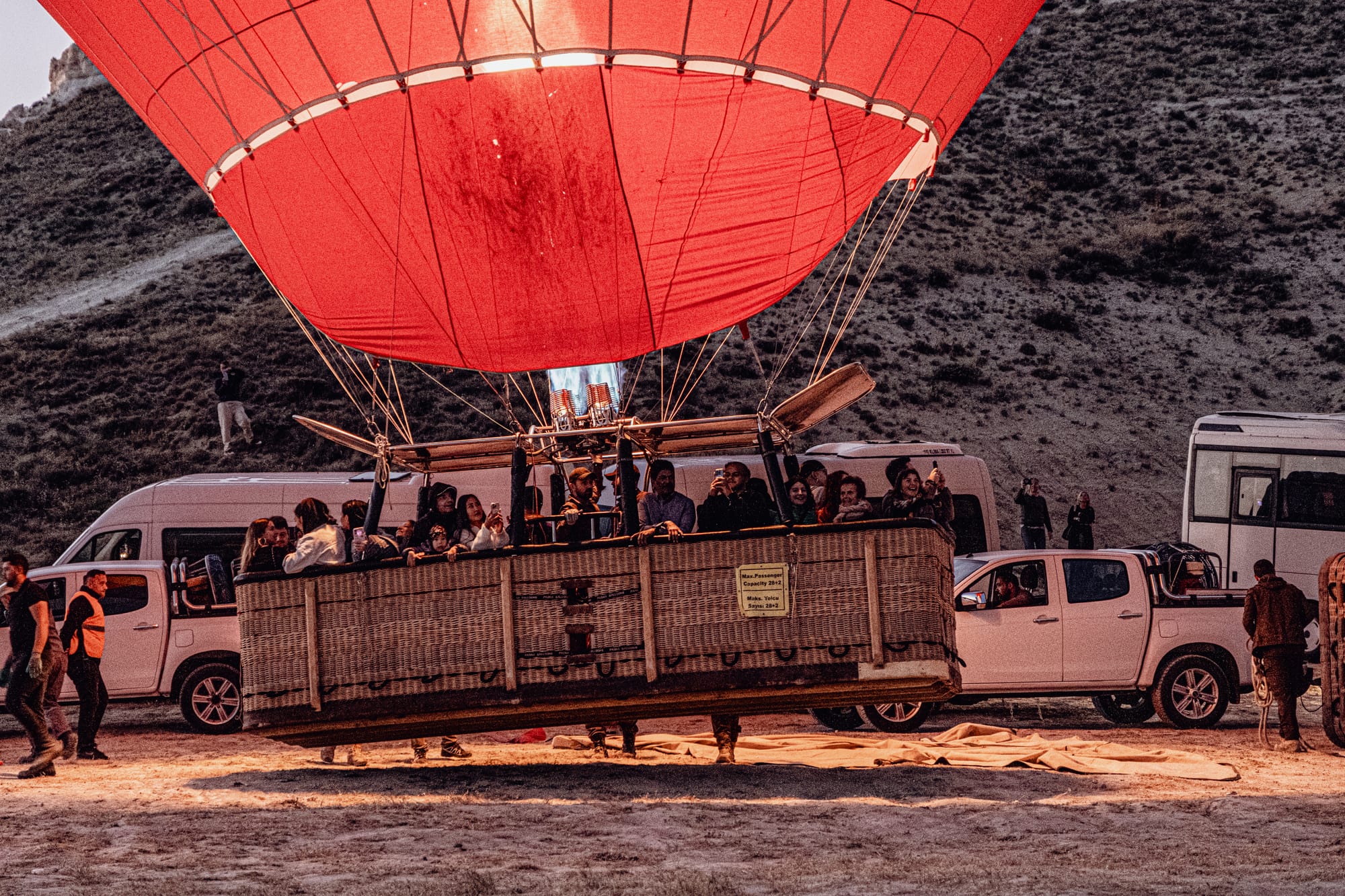
The flight usually lasts around an hour, giving you time to watch the light change and to trace the valleys from above. It’s not a cheap experience, but it is singular—something that cannot be replicated elsewhere with this scale or this terrain. Even if you’ve seen balloons before, Cappadocia’s combination of geology and sheer numbers makes it unforgettable. For many, it’s the highlight of their time here—not just for the view, but for how it reframes the land you’ll spend the rest of your stay walking through.
Sunrise jeep safari to see the hot air balloons
An off-road dawn chase through Cappadocia’s valleys.
Before the sun is fully up, jeeps rumble out of Göreme and Uçhisar, winding along dirt tracks to reach panoramic ridges just as the hot air balloons begin to rise. The safari isn’t just transport—it’s part of the experience: headlights cutting through the dark, dust lifting as engines climb steep hills, and sudden pauses at overlooks where the first colors of dawn spill across the valleys. When the balloons finally take flight, dozens of them drift overhead, glowing against the morning sky in complete silence.
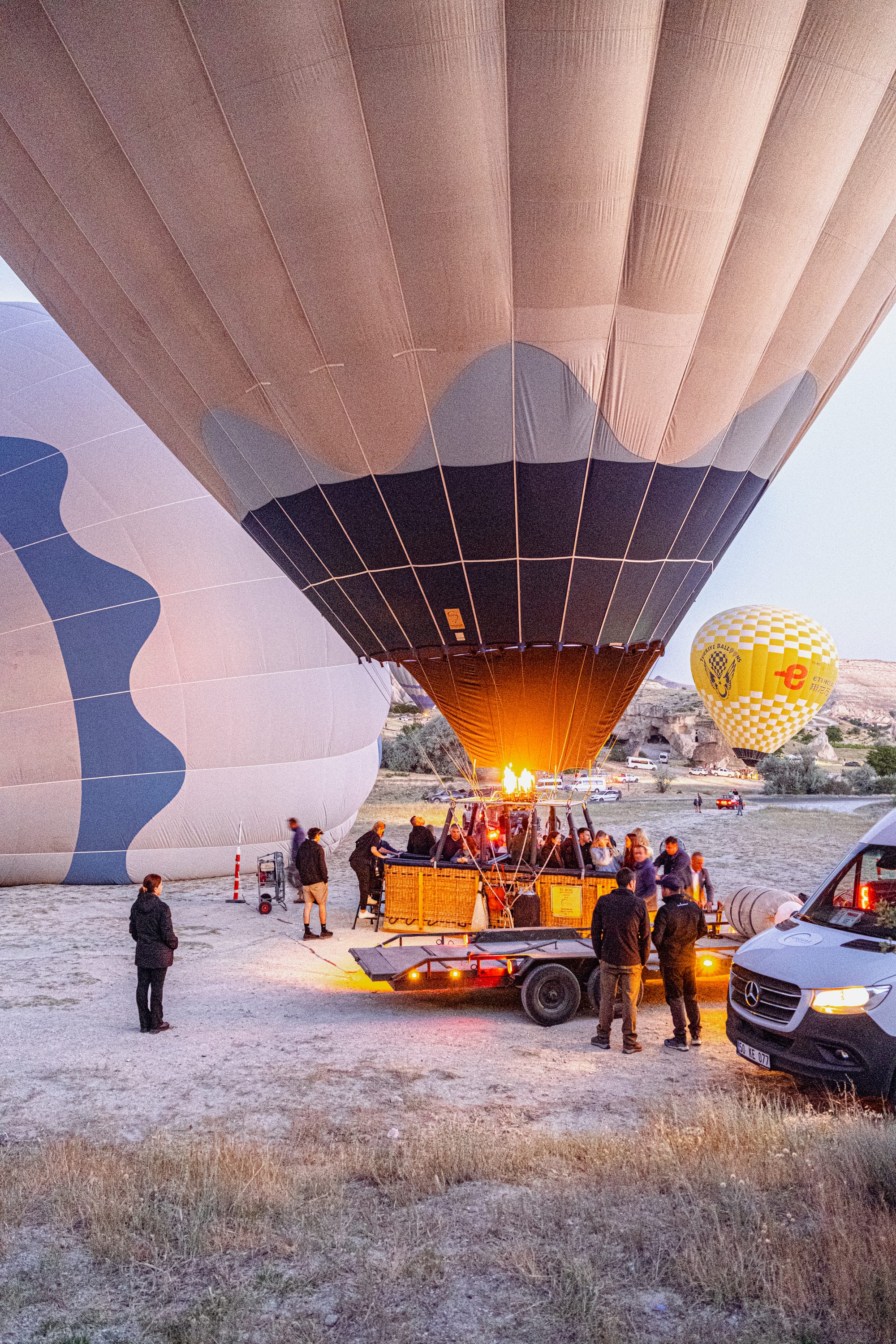
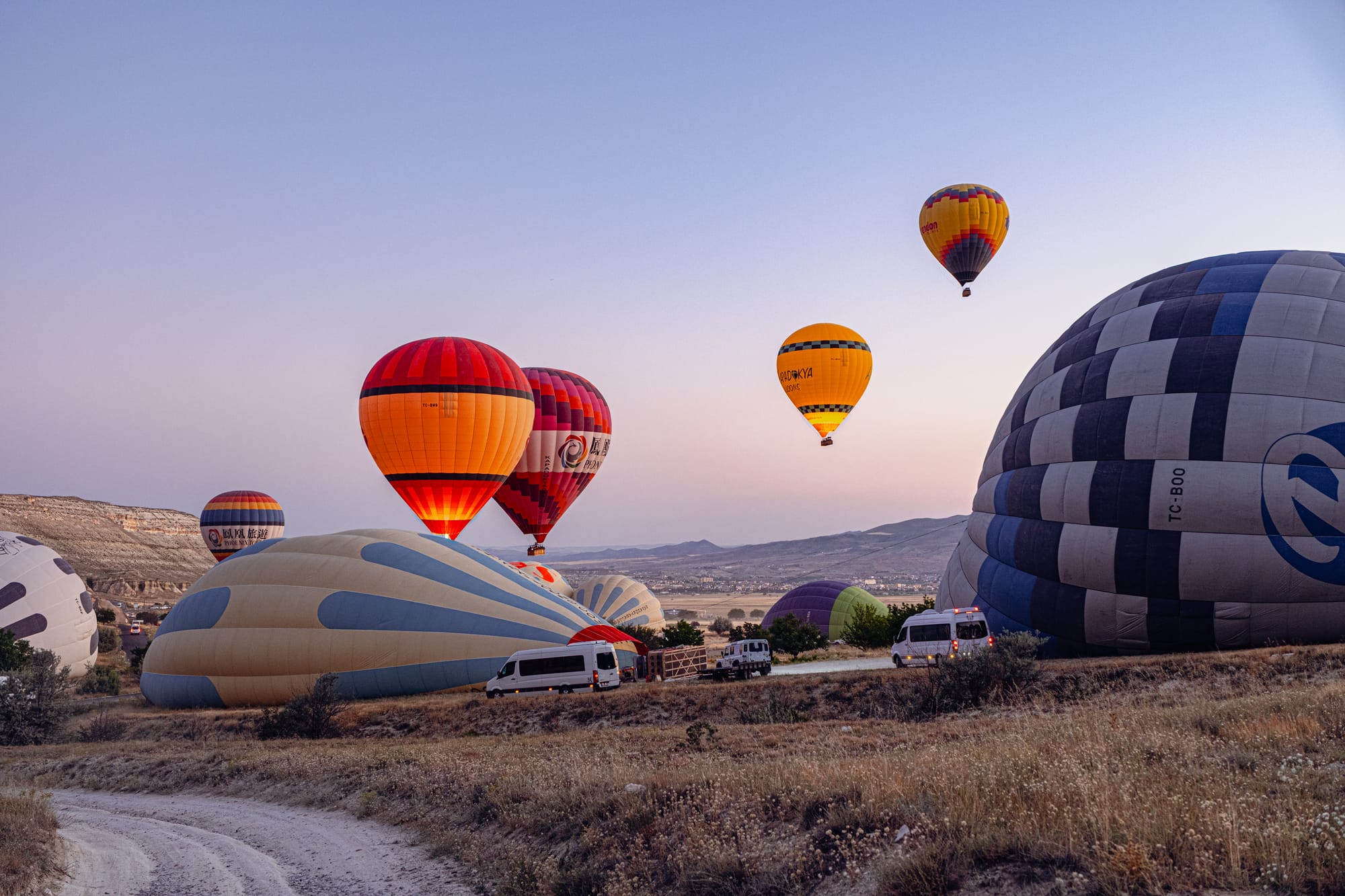
The ride itself is an adventure, bouncing through valleys and climbing to viewpoints you might not otherwise reach on foot. Guides often stop at multiple spots, giving you different perspectives as the balloons float by cliffs, fairy chimneys, and ridgelines. It’s less polished than the balloon ride itself, but that’s the appeal—you’re on the ground, moving with the land, watching the sky fill with color and scale. For many, it’s one of the most atmospheric ways to experience Cappadocia’s mornings.
ATV adventure through the valleys
Dust, speed, and stone silhouettes at sunset.
Riding an ATV through Cappadocia’s valleys offers a faster, rougher encounter with the landscape—one where you trade silence for the hum of engines and the rush of wind. Most tours wind through Swords, Rose, and Love Valleys, stopping at panoramic ridges along the way. The thrill comes not only from navigating dirt paths and sharp turns, but from the constant backdrop: fairy chimneys rising like sculptures and ridgelines glowing in late-afternoon light.
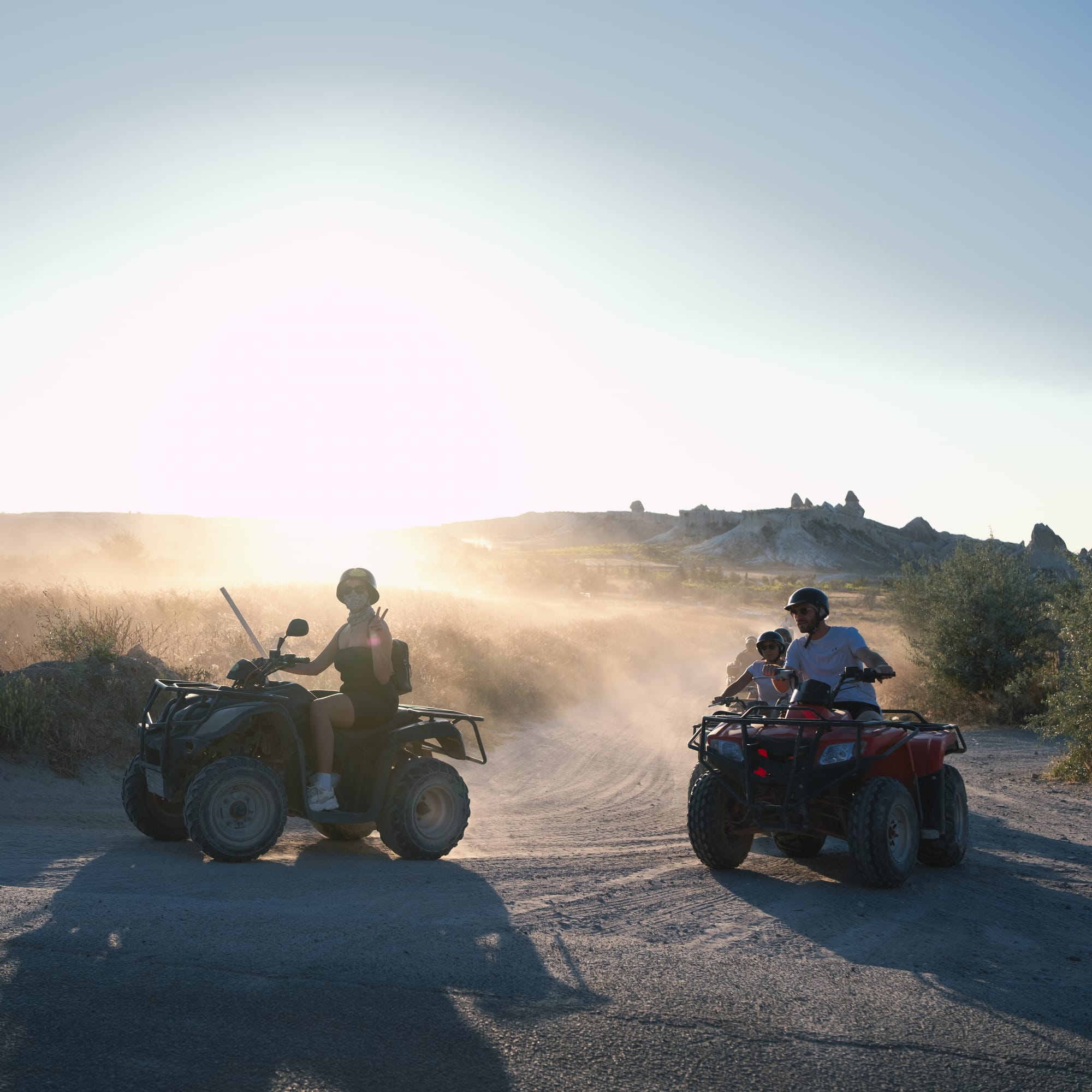
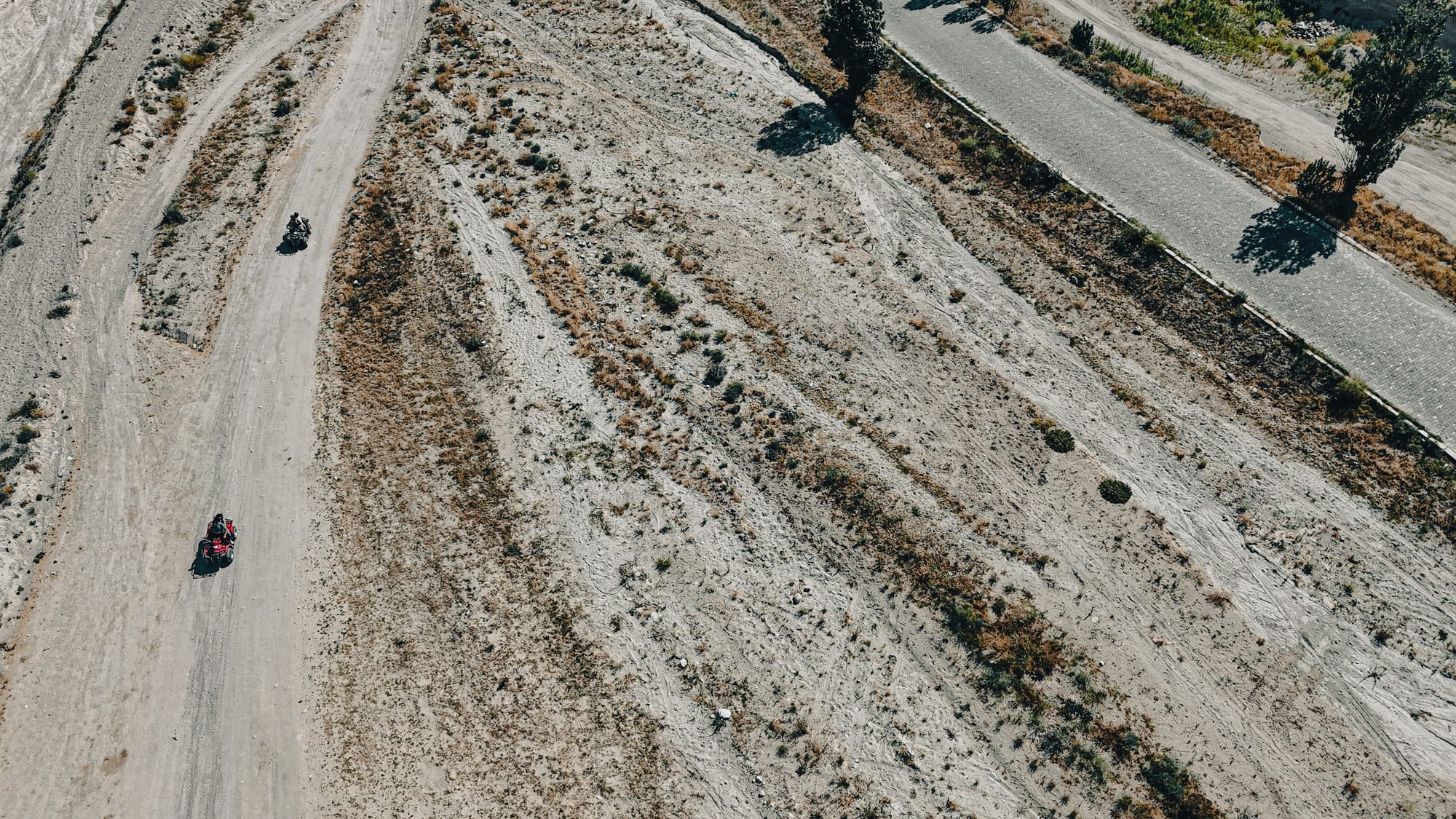
While not as meditative as hiking, ATV tours open up terrain you might not otherwise cover in a single outing. Guides often time the rides for sunset, when the dust in the air catches the fading sun and the cliffs turn shades of pink and gold. It’s a social experience too—you’ll often be in a convoy of riders, headlights flickering on as dusk deepens. For a different perspective on Cappadocia’s valleys—one rooted in movement and adrenaline—this is a memorable way to experience them.
Gözleme making with local women
A hands-on taste of Cappadocian hospitality.
Gözleme, a thin flatbread stuffed with fillings like spinach, potato, or cheese, is one of the simplest yet most beloved foods in Turkey. In Cappadocia, you can learn to make it alongside local women, often in village homes or small family-run kitchens. The process itself is tactile and communal: rolling dough paper-thin, spreading the filling, folding it into shape, and cooking it over a domed griddle. Conversations often flow as easily as the tea, turning a cooking lesson into a cultural exchange.
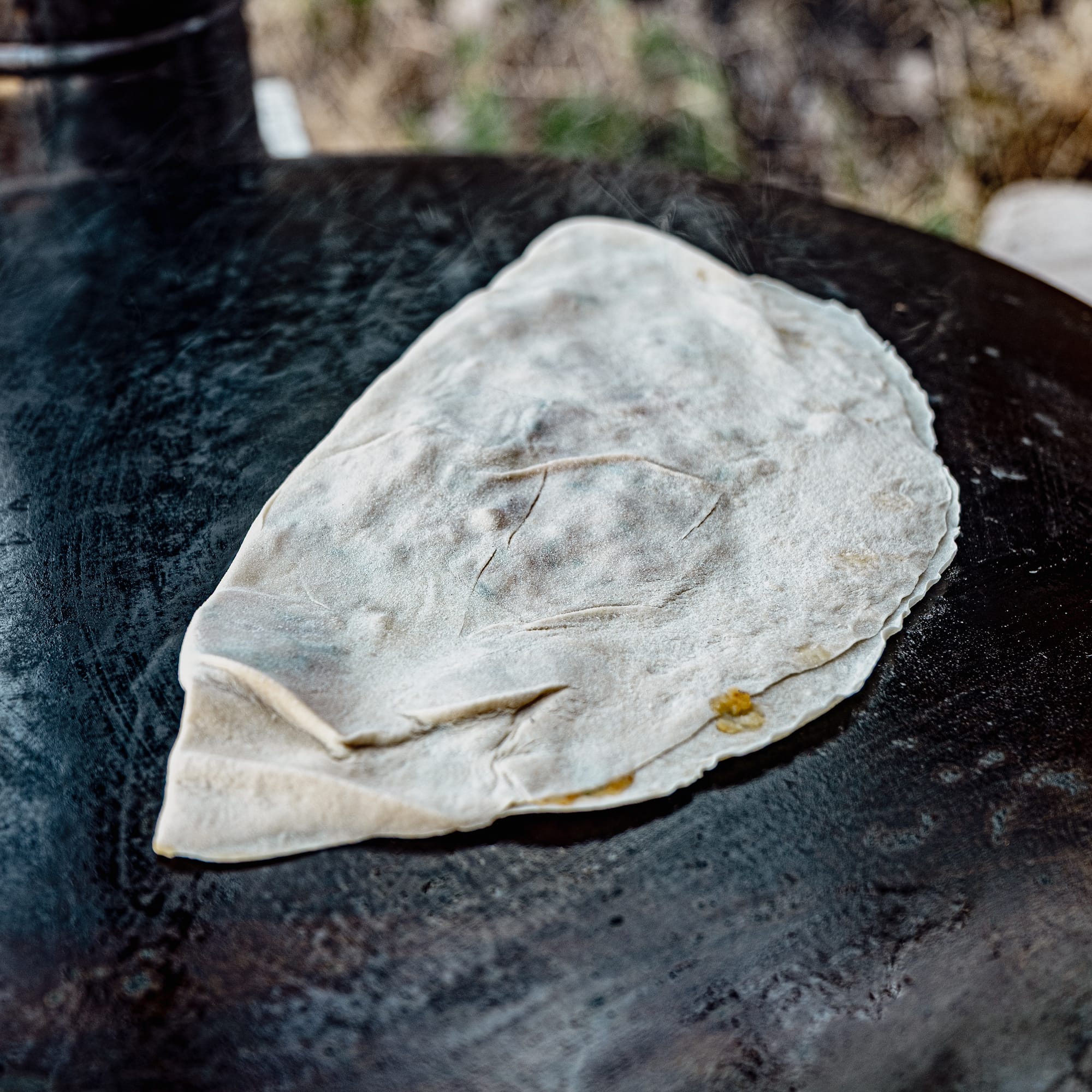
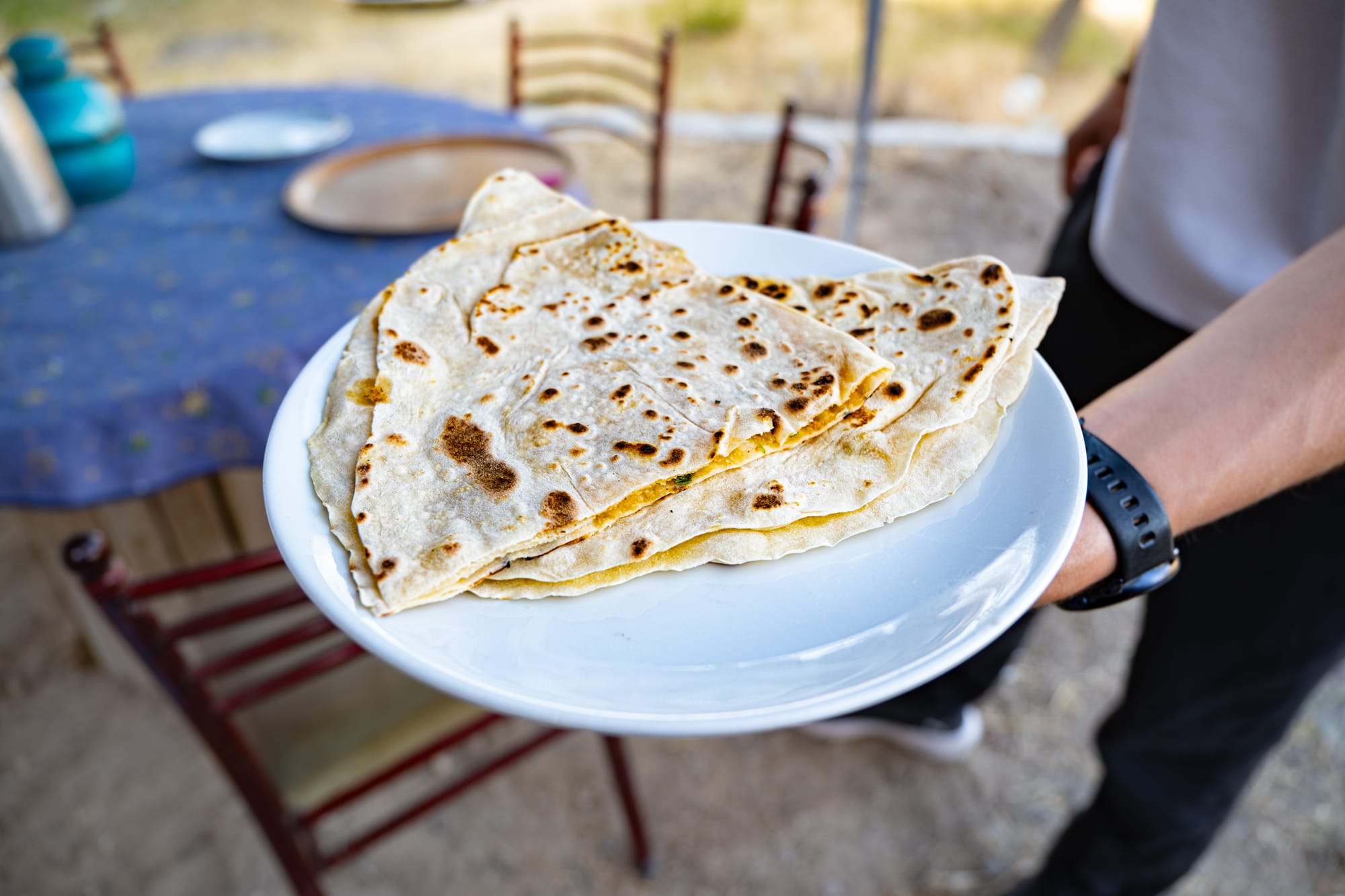
Eating gözleme you’ve made yourself—warm, blistered from the griddle, and brushed with butter—is a grounding experience after days of wandering Cappadocia’s surreal valleys. Beyond the food, the act of cooking together opens a window into daily life here: rhythms shaped less by tourism and more by tradition. It’s a reminder that Cappadocia is not only a land of fairy chimneys and balloons, but also of kitchens, families, and flavors carried across generations. Vegan options available.
Pottery demo at Sultan’s Ceramic in Avanos
Clay shaped by centuries of tradition.
Avanos has been a pottery center since Hittite times, thanks to the red clay drawn from the Kızılırmak River that runs through town. At Sultan’s Ceramic, you can watch artisans continue this lineage—spinning clay on a kick wheel, shaping jars and plates with practiced hands, and painting them with the intricate floral and geometric patterns that Cappadocia is known for. The workshop itself feels like part gallery, part living history, with shelves of glazed ceramics alongside the sound of clay being thrown.
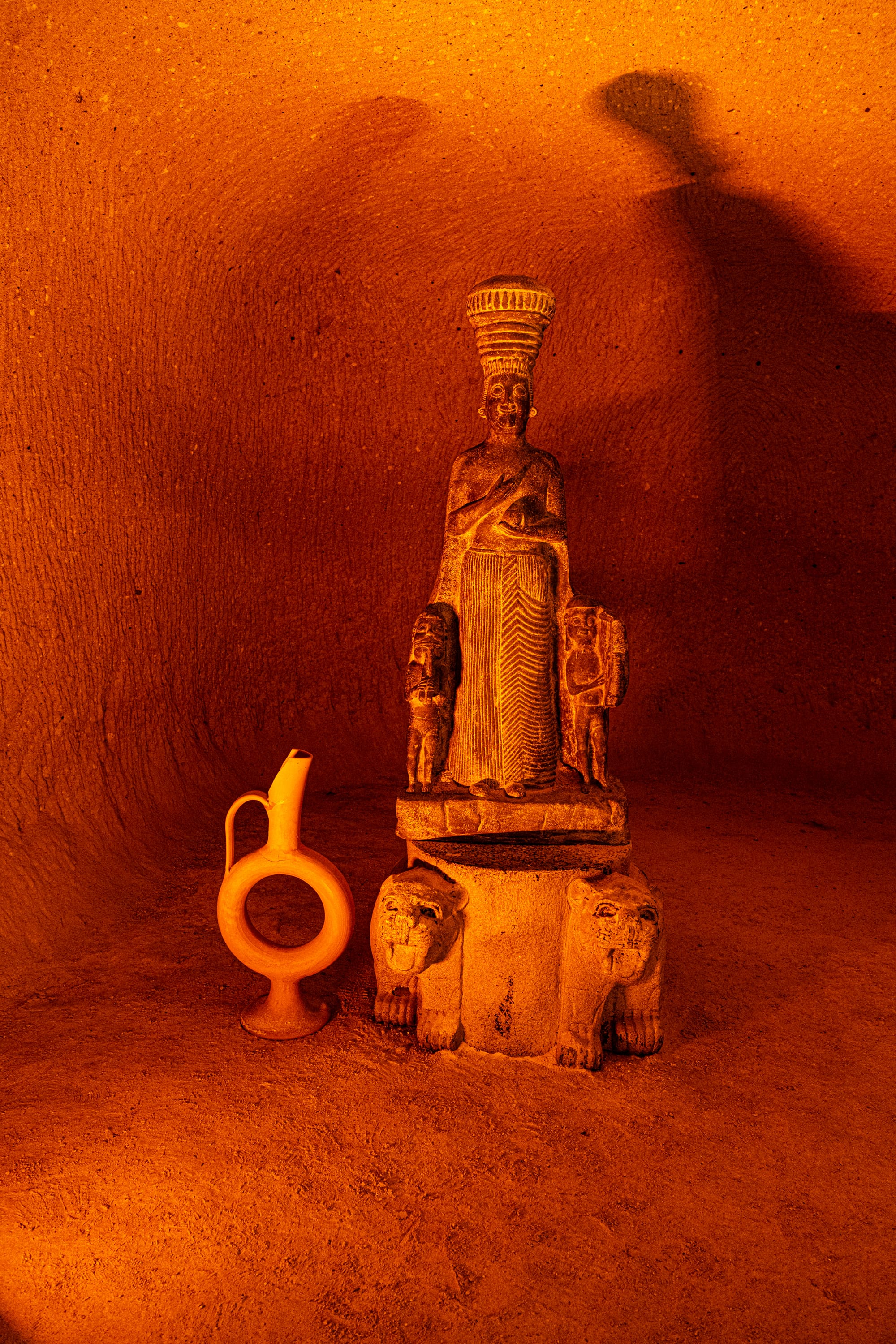
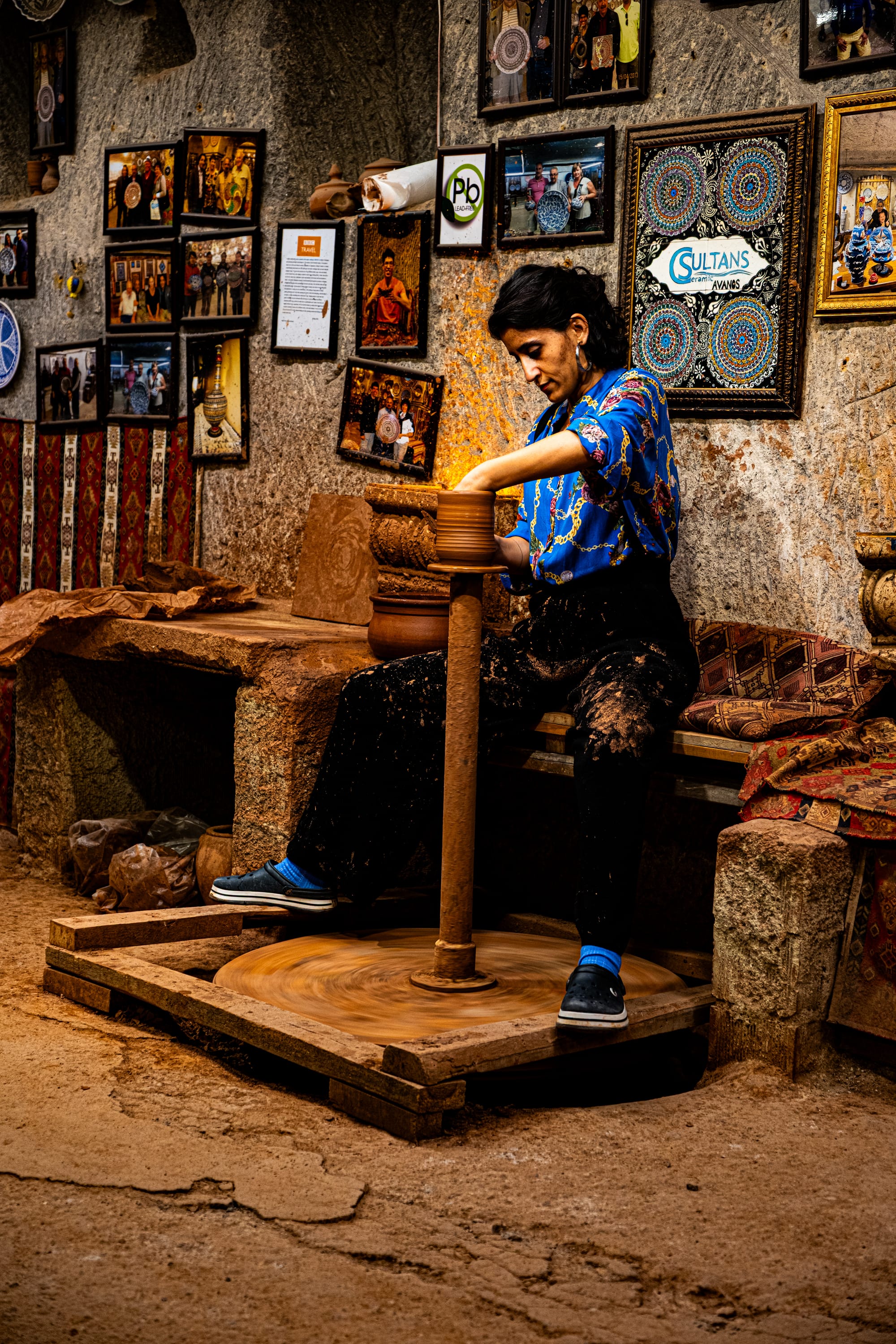
What makes the experience memorable is its intimacy. Visitors are often invited to try the wheel themselves, guided by a potter who shows how to center the clay and let it rise beneath your fingers. Even a few minutes at the wheel makes clear how much skill and patience the craft requires. Whether you leave with a piece of pottery or simply the memory of red clay under your nails, the demo is a tactile way of connecting with Cappadocia’s human landscape—one where earth is not only walked on, but shaped into beauty and use.
Try a vegan clay pot at House of Memories
A traditional dish reimagined in a cave kitchen.
House of Memories, a family-run restaurant in Göreme, serves one of Cappadocia’s most memorable specialties: the clay pot. Traditionally made with meat, the dish is slow-cooked in a sealed earthen pot, which is cracked open at the table to release a rush of steam and aroma. Here, the lovely owner Chef Bayram offered us vegan version, filled with seasonal vegetables and fragrant spices—a thoughtful twist that keeps the ritual while opening it up to different diets.
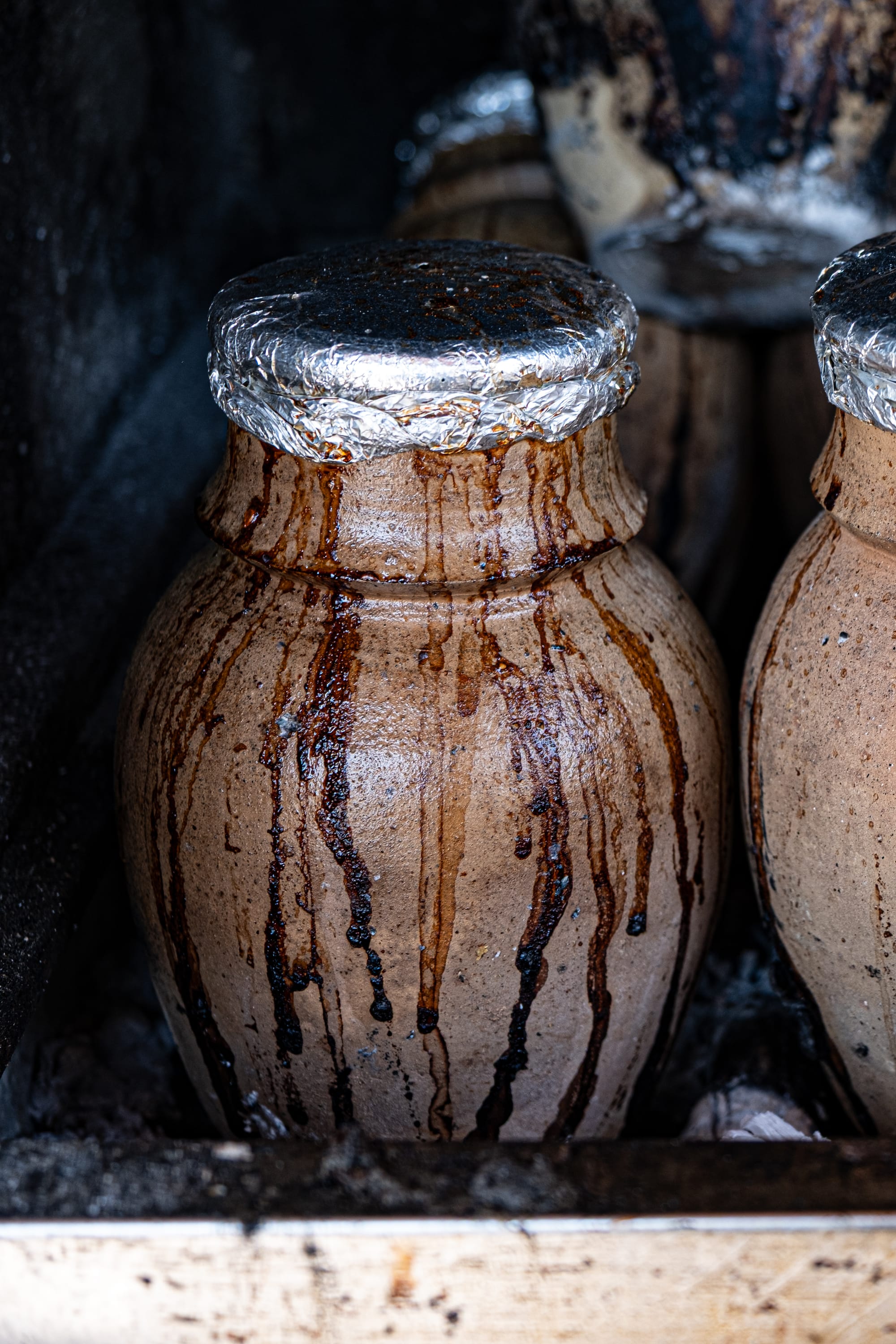
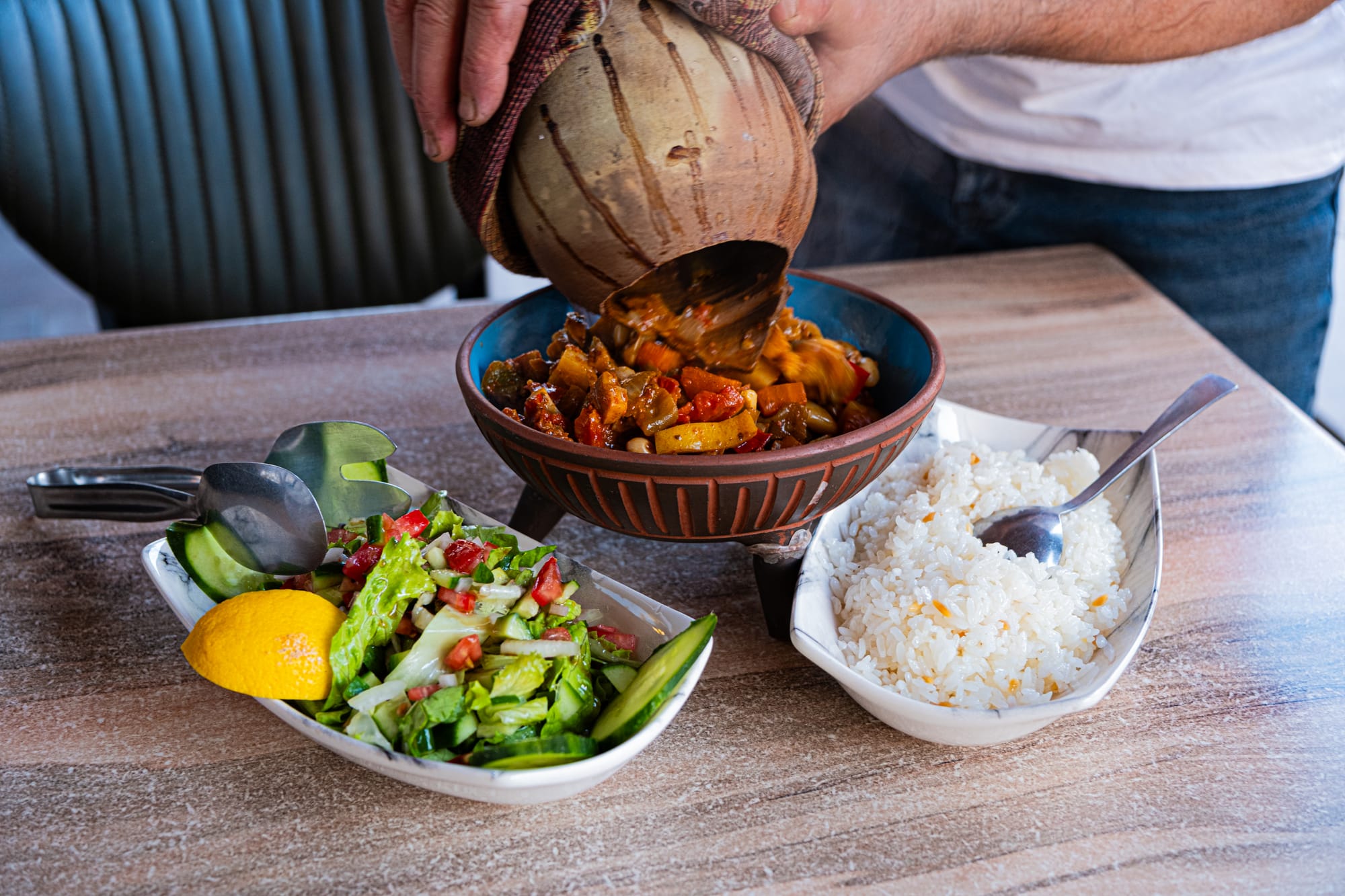
The setting makes the experience even more atmospheric. Tucked inside a stone-walled room, the restaurant feels as if it has grown out of the rock itself. Meals are unhurried, often accompanied by tea and warm conversation with the owners. Trying the vegan clay pot here isn’t just about food—it’s about participating in a Cappadocian tradition that connects land, craft, and hospitality in one simple but striking gesture. Make sure to reserve a pot in advance.
Viewpoints and open air wonders
Selime Monastery
A cliffside cathedral carved from stone.
At the far end of the Ihlara Valley, Selime Monastery rises dramatically from the rock—a vast complex of chapels, living quarters, kitchens, and even stables all carved directly into a cliff face. Dating back to the 8th or 9th century, it was both a religious center and a refuge, its scale unlike anything else in Cappadocia. Walking through its cavernous halls, you feel the ambition of the builders: domed ceilings, archways, and fresco fragments that still cling to the walls despite centuries of erosion.
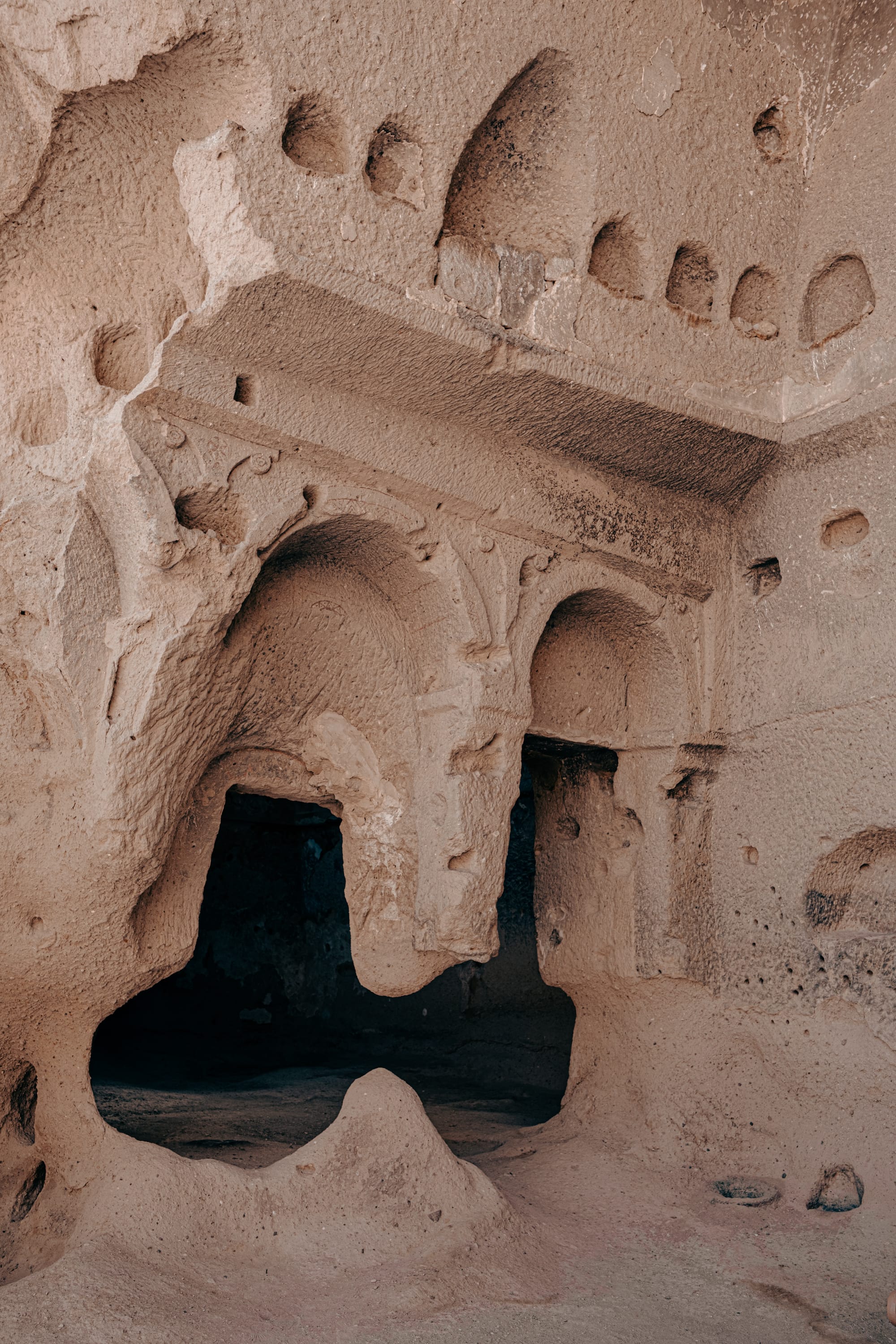
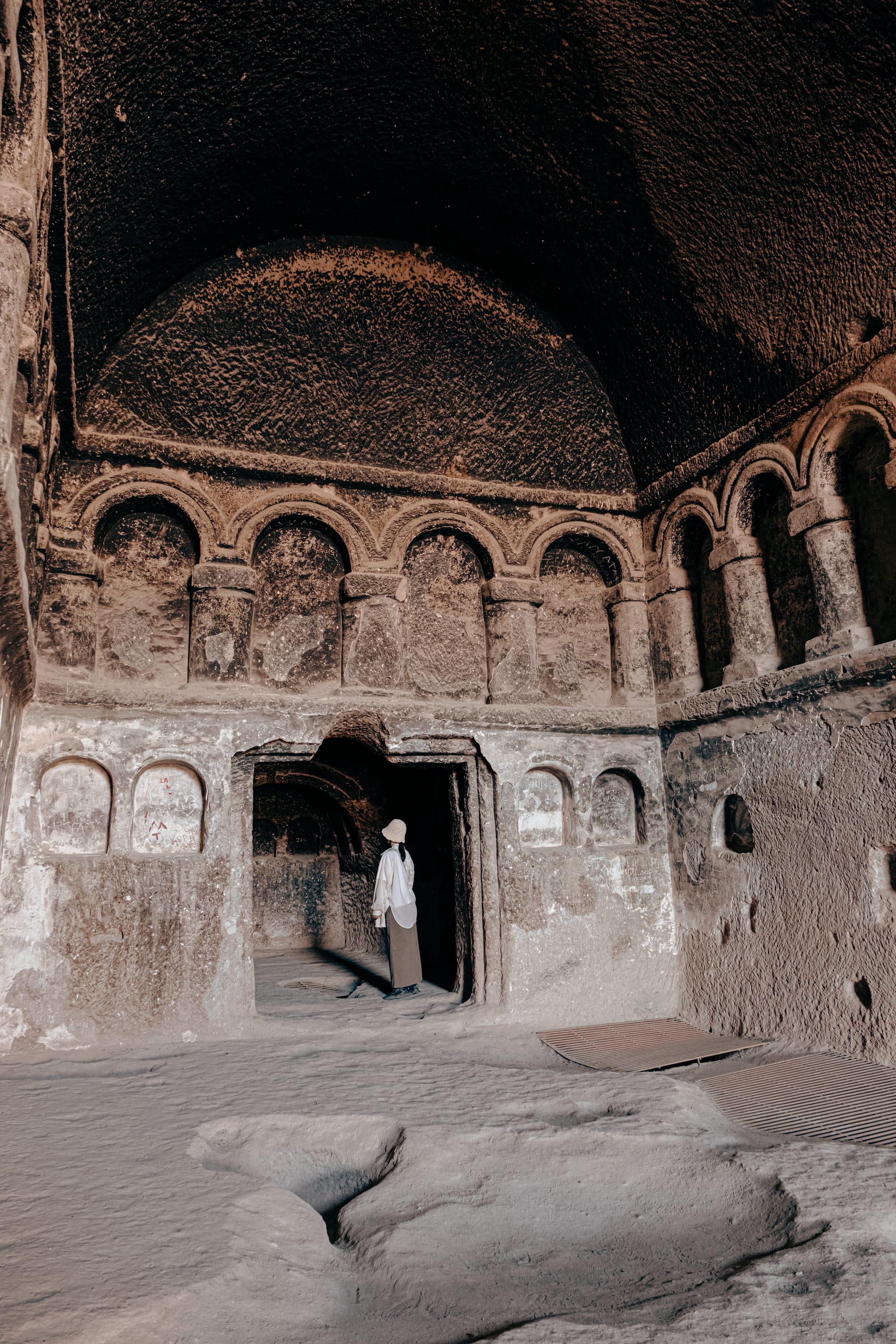
Climbing through its chambers is an adventure in itself—steep paths, hidden stairways, and openings that suddenly frame sweeping views of the valley below. The monastery’s size and setting give it a cathedral-like presence, yet it remains rough, elemental, inseparable from the rock it’s carved into.
Göreme Open Air Museum
Frescoes and chapels in a valley of devotion.
The Göreme Open Air Museum is one of Cappadocia’s most important monastic complexes, a cluster of rock-cut churches, chapels, and refectories carved into soft volcanic stone. Dating back to the 10th–12th centuries, its cave interiors are decorated with vivid Byzantine frescoes—Christ Pantocrator, saints, angels, and biblical scenes still glowing in ochre, indigo, and red. Walking between the chapels feels like stepping into a carved-out village of faith, each doorway opening to another sanctuary preserved in silence.
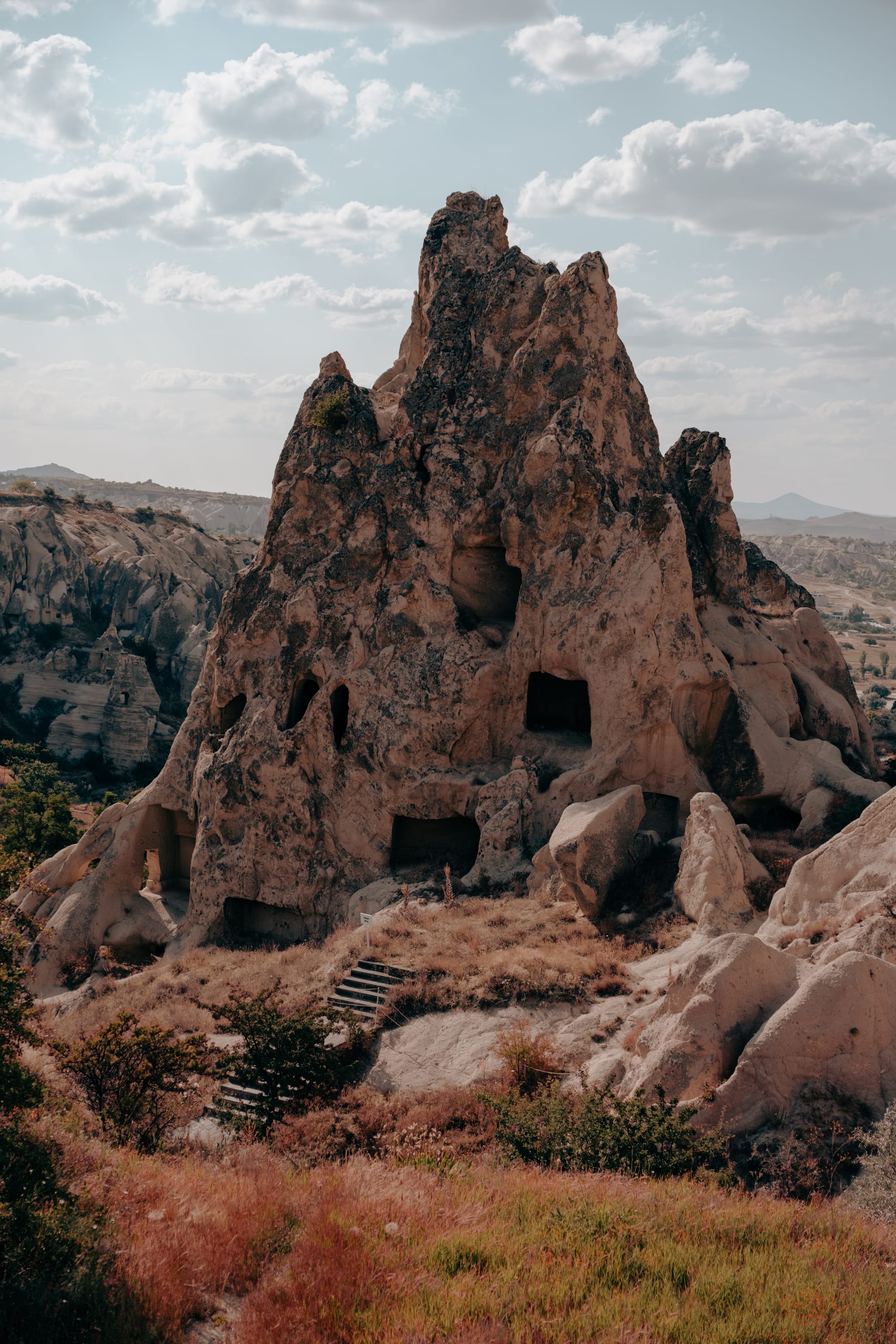
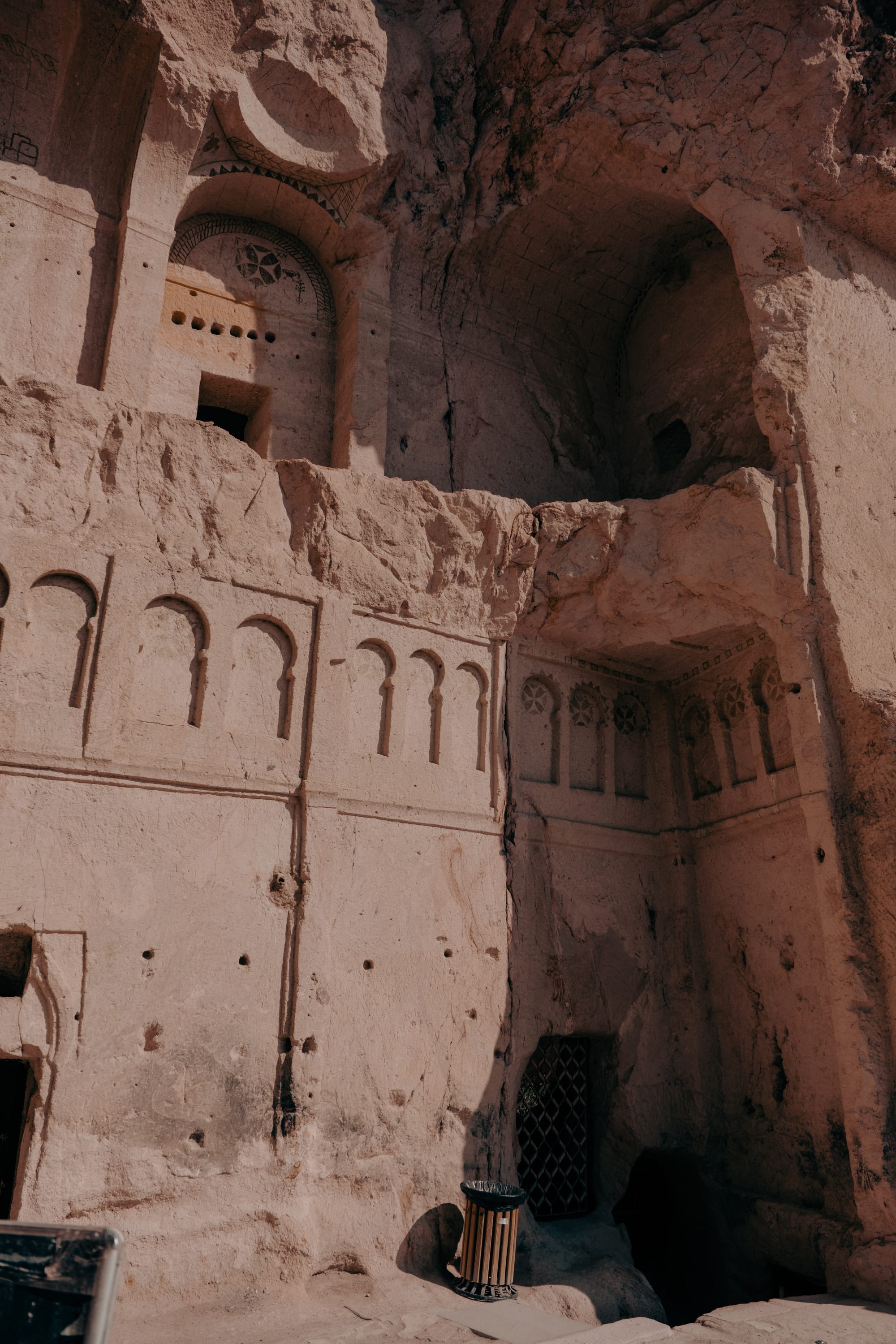
Though it draws crowds, the museum remains astonishing for its intimacy: spaces that once held monks and worshippers are small, simple, and alive with color. The most famous chapels—like the Dark Church with its well-preserved frescoes—show the heights of medieval Cappadocian art, while smaller chambers reveal everyday devotion.
Pigeon Valley Lookout
A panorama shaped by cliffs and dovecotes.
Just outside Göreme and Uçhisar, the Pigeon Valley lookout offers one of Cappadocia’s most accessible and sweeping views. The valley takes its name from the dovecotes carved into the cliffs, once used by locals to collect pigeon droppings as fertilizer for vineyards and fields. From the lookout, you can see the valley stretch between the towns, its ridgelines dotted with fairy chimneys and the distant form of Uçhisar Castle rising above it all.
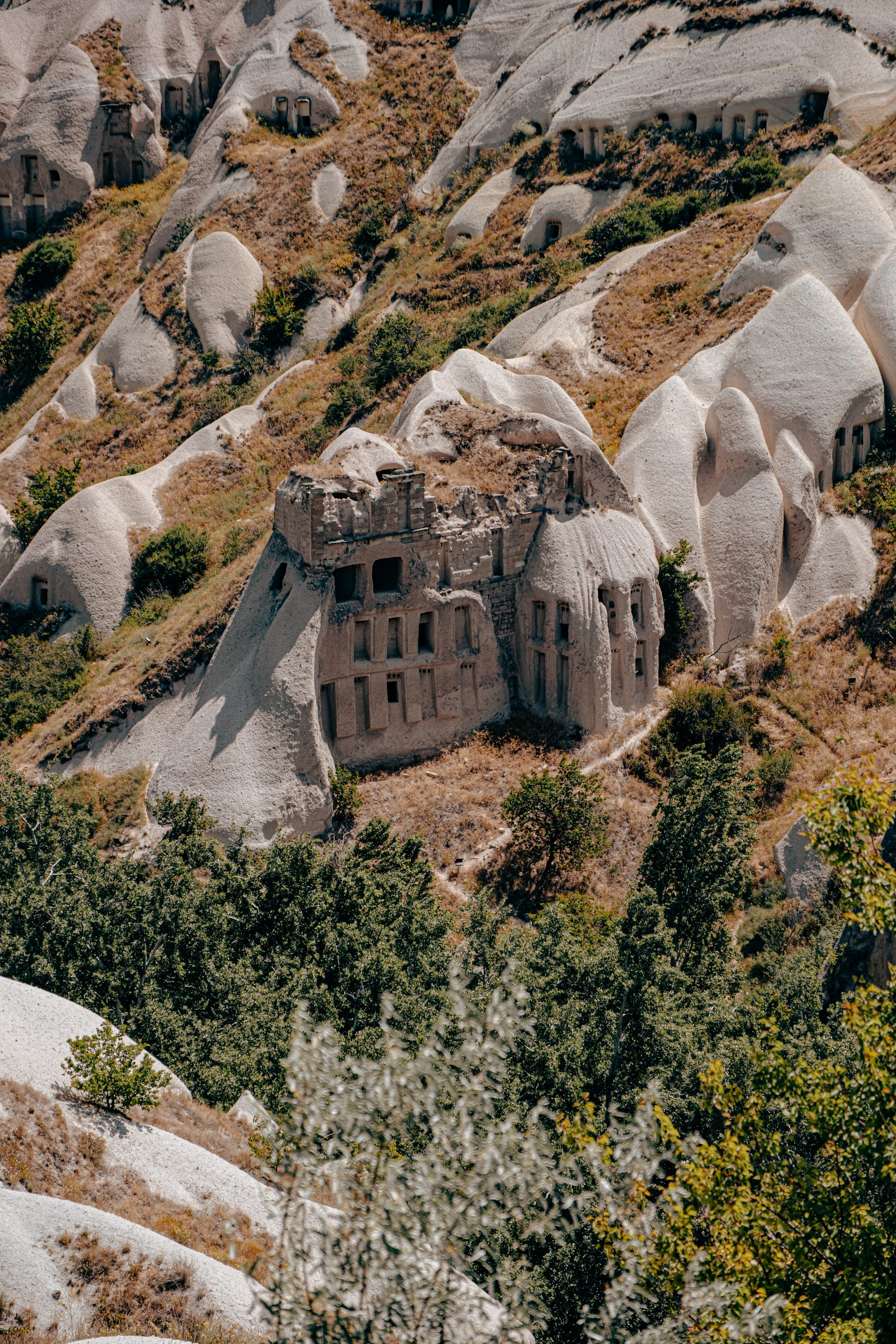
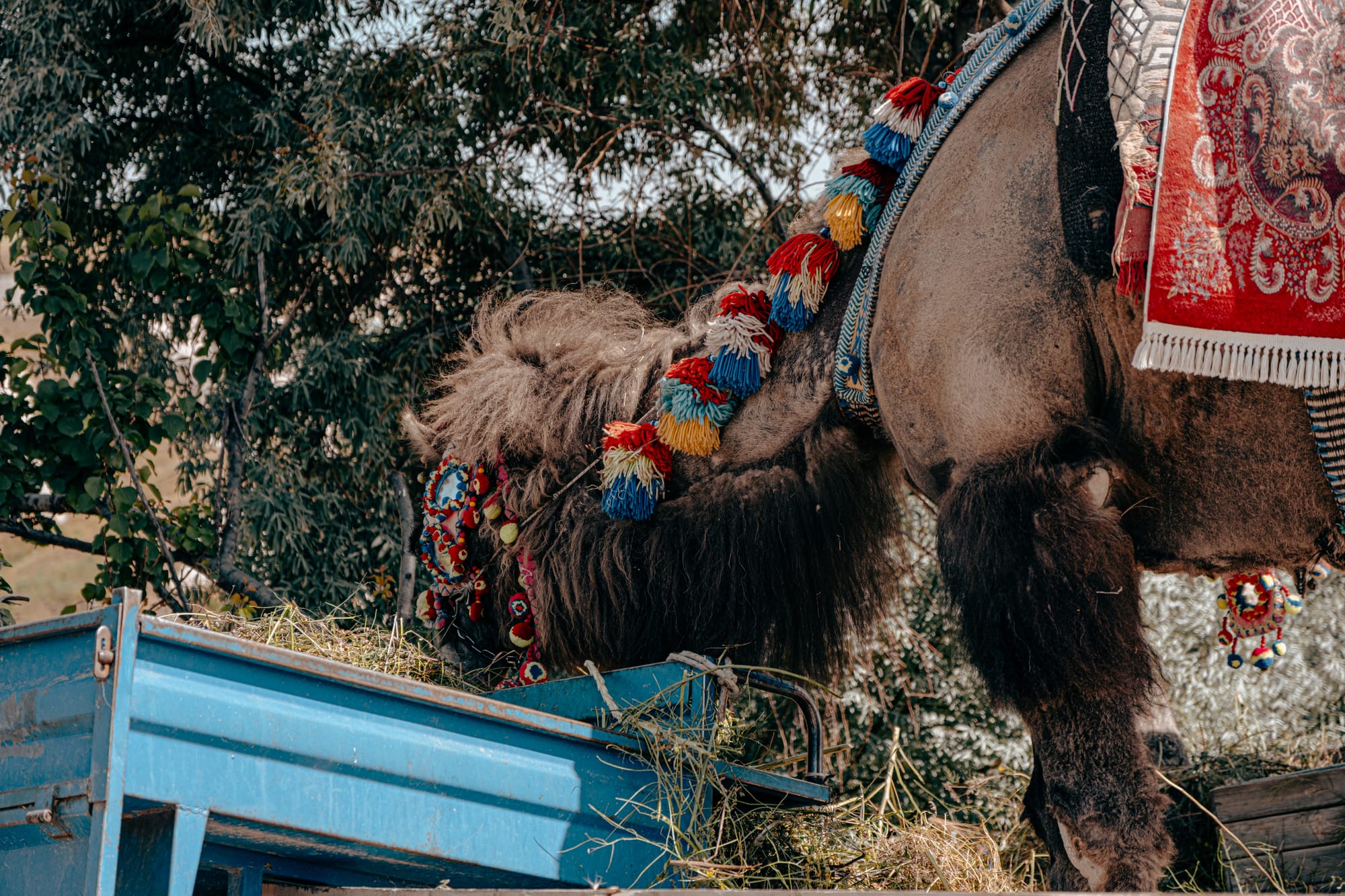
It’s a popular stop, especially at sunset, but the view remains striking no matter the time of day. Simple cafés and terraces nearby make it easy to linger, sipping tea while balloons drift by in the mornings or shadows lengthen in the evenings. More than just a viewpoint, the Pigeon Valley lookout captures the essence of Cappadocia in a single frame: human history etched into cliffs, layered with a landscape that feels both surreal and enduring.
Uçhisar Castle
A natural fortress with Cappadocia at its feet.
Rising above the surrounding plateau, Uçhisar Castle is the highest point in Cappadocia—a honeycombed rock citadel carved with tunnels, chambers, and passageways. Once used as a fortress and lookout, it served as both refuge and vantage point, controlling views across valleys and trade routes. Today, the castle still dominates the town that surrounds it, its stone silhouette visible from miles away.
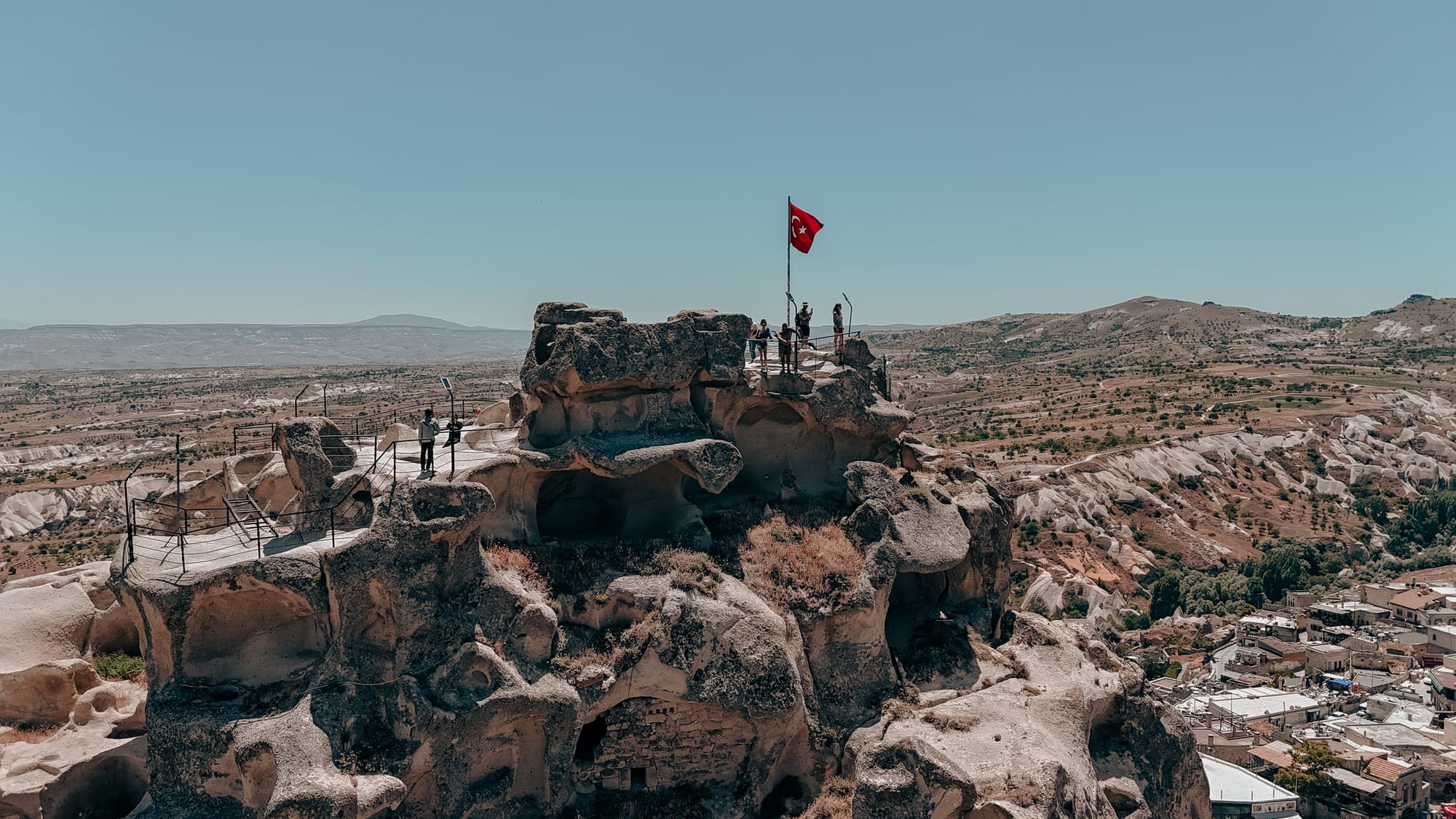
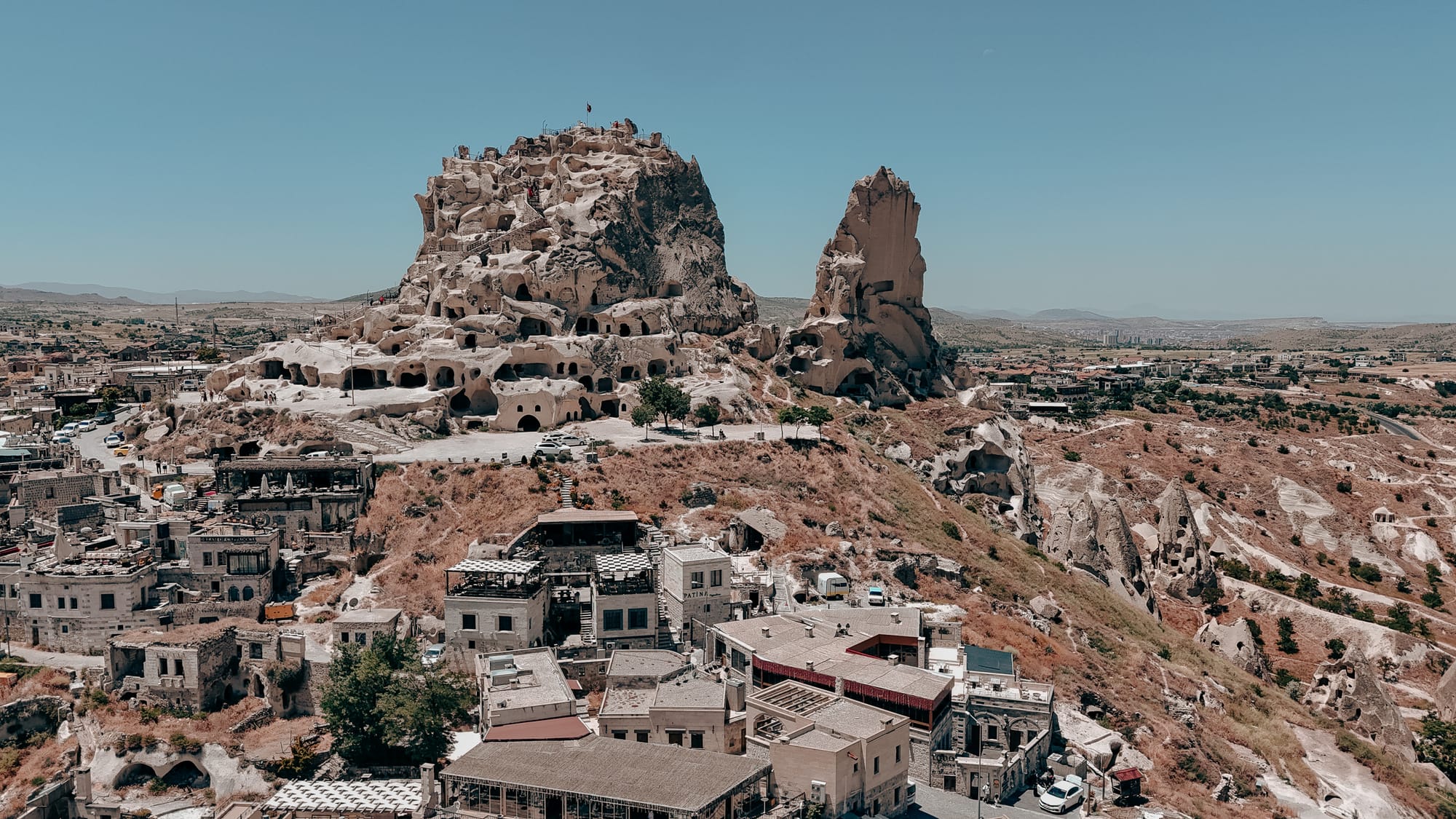
Visitors can climb to the very top, winding through narrow stairways and terraces to reach a panoramic lookout unmatched in the region. From here, the entire landscape opens—Göreme below, the fairy chimneys stretching into the distance, and on clear days, Mount Erciyes rising on the horizon. It’s one of the few places where you can grasp Cappadocia’s full scale in a single sweep of the eye, a reminder that this is not just a land of valleys, but a vast and interconnected terrain.
Göreme Panorama
A sweeping overlook of Cappadocia’s heart.
Perched just off the main road into town, Göreme Panorama offers one of the most expansive views of the region’s core valleys. From this high ridge, the town of Göreme sits nestled among fairy chimneys, while the horizon stretches toward Uçhisar Castle and the open plateau beyond. Balloons often rise over the landscape at dawn, and in the evening the cliffs catch the last light, turning shades of rose and gold.
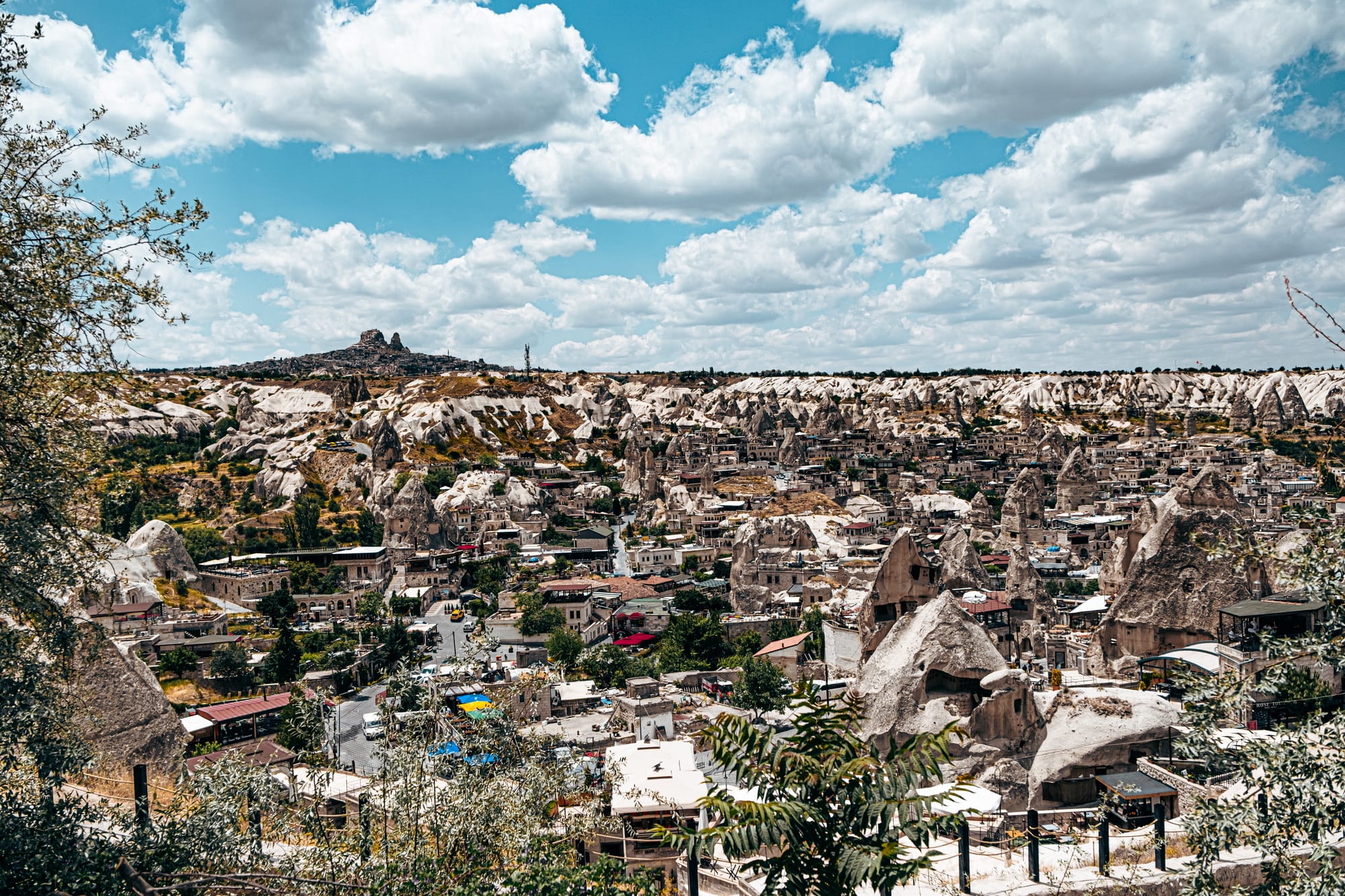
It’s a simple stop—marked by a terrace, a few cafés, and roadside stalls—but the view is extraordinary. Many visitors pass by quickly, but it’s worth lingering, letting your eyes adjust to the scale and complexity of the valleys.
Ranches
Moonlight Ranch
A glimpse into Cappadocia’s ranching heritage.
Set on the edge of Göreme, Moonlight Ranch is one of the places where Cappadocia’s long history with horses is still visible. The name Cappadocia itself is often translated as “the land of beautiful horses,” and for centuries horses were an essential part of transport, trade, and daily life here. At the ranch, you’ll see them grazing against a backdrop of fairy chimneys and ridgelines, a living reminder that this desert-like terrain has always been shared between land, animal, and people.
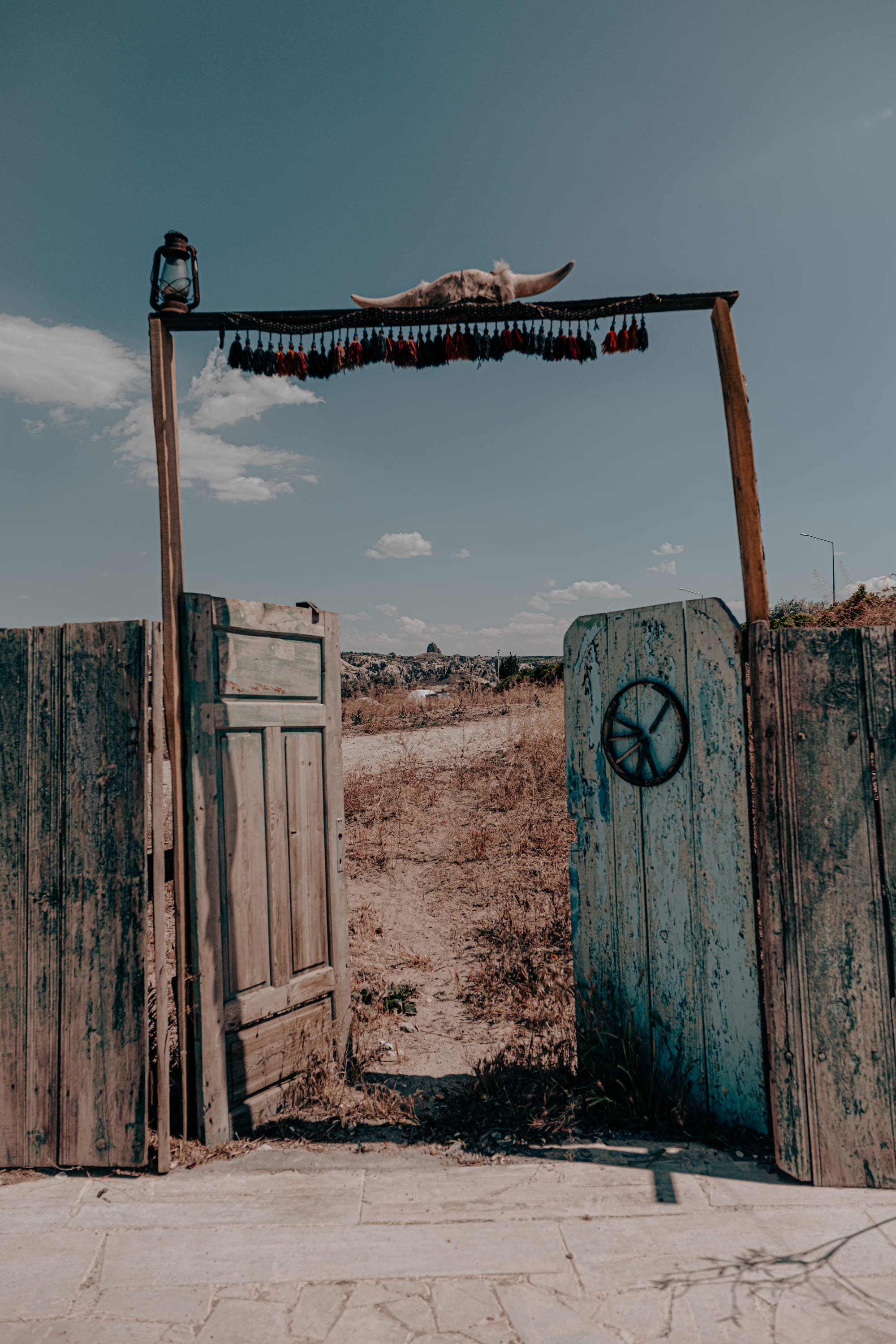
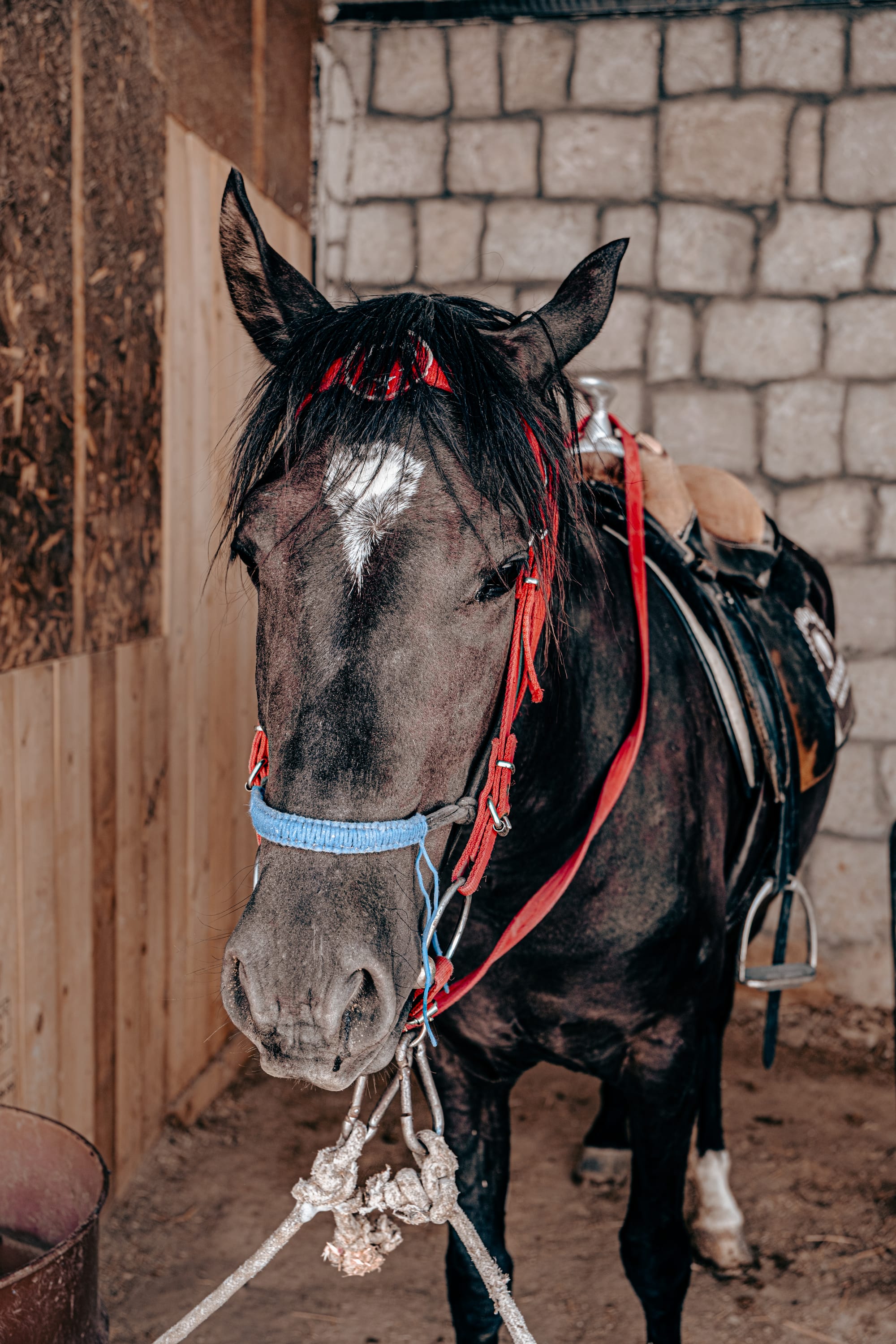
Even if you don’t ride, spending time at the ranch offers a different perspective on the region. Watching the horses move across the landscape, hearing the stories of ranchers who care for them, or simply pausing to see how animals and humans coexist with the valleys adds texture to Cappadocia beyond its trails and balloon rides. With its dusty paths, open horizons, and silhouettes of riders against the cliffs, the whole place has the feel of a Western film set. It’s a slower encounter—one rooted in observation and respect—that connects you to the pastoral rhythms still present beneath the region’s tourist surface.
Dalton Brothers Ranch
A slice of Americana in the middle of Cappadocia.
Dalton Brothers Ranch leans into a Western theme with saloon-style façades, cowboy iconography, and a ranch setting surrounded by Cappadocia’s surreal stone formations. It’s an unusual blend—fairy chimneys rising in the distance while wooden porches and horses recall something straight out of Oklahoma. The result is a space that feels both playful and uncanny, a cultural mashup dropped into a landscape already shaped by centuries of human imagination.
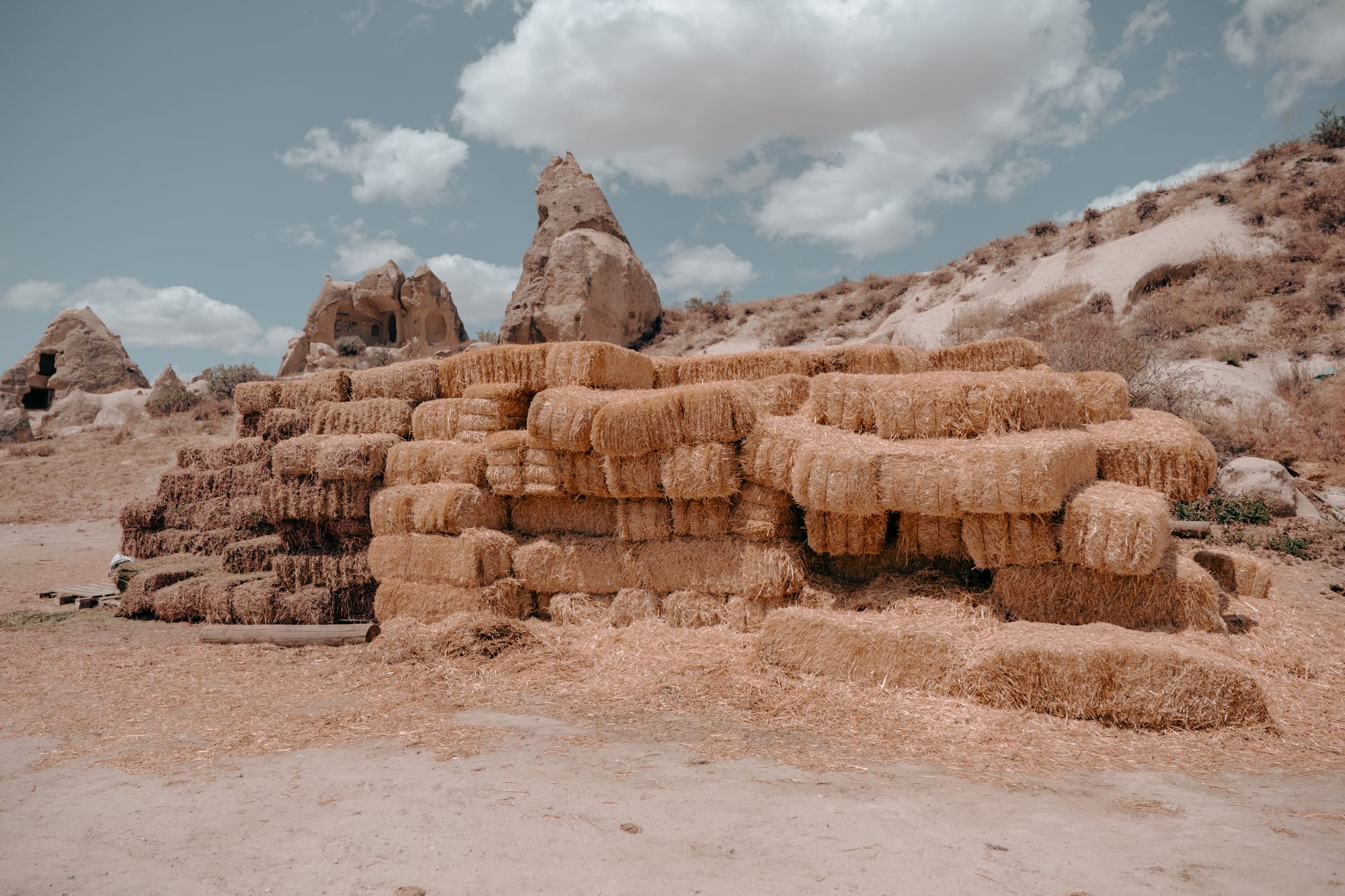
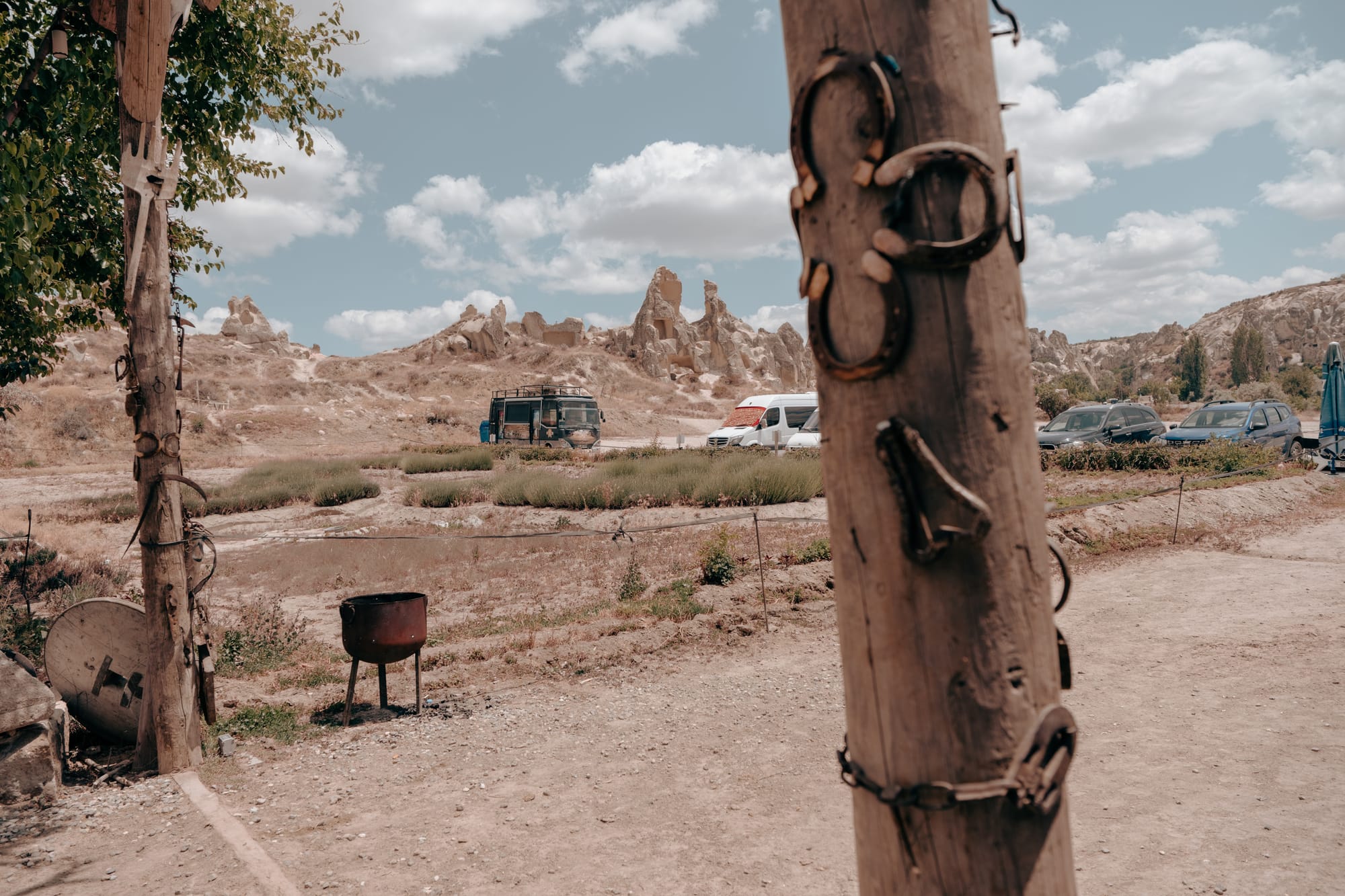
Even if you’re not here to ride, the ranch is worth a visit for its atmosphere. The décor, the corrals, and the sweeping backdrop give it the air of a film set where Cappadocia’s frontier character collides with Wild West nostalgia. It may not be traditional, but it taps into the same sense of scale and openness that has always defined the region. For a moment, you half expect dust to kick up and a duel to unfold, with fairy chimneys as the silent witnesses.
Villages and local experiences
Göreme
The bustling heart of Cappadocia.
Göreme is the region’s main hub, a compact town where tourism and daily life intersect against a backdrop of fairy chimneys and cave houses. Streets are lined with guesthouses, cafés, tour offices, and carpet shops, making it the easiest base for first-time visitors. Balloon launches happen right above town, and from nearly any rooftop terrace you can watch the sky fill at dawn. Despite the crowds, Göreme retains a charm—stone alleys that wind past cave dwellings, family-run restaurants serving gözleme, and trails that begin just steps from the main square.
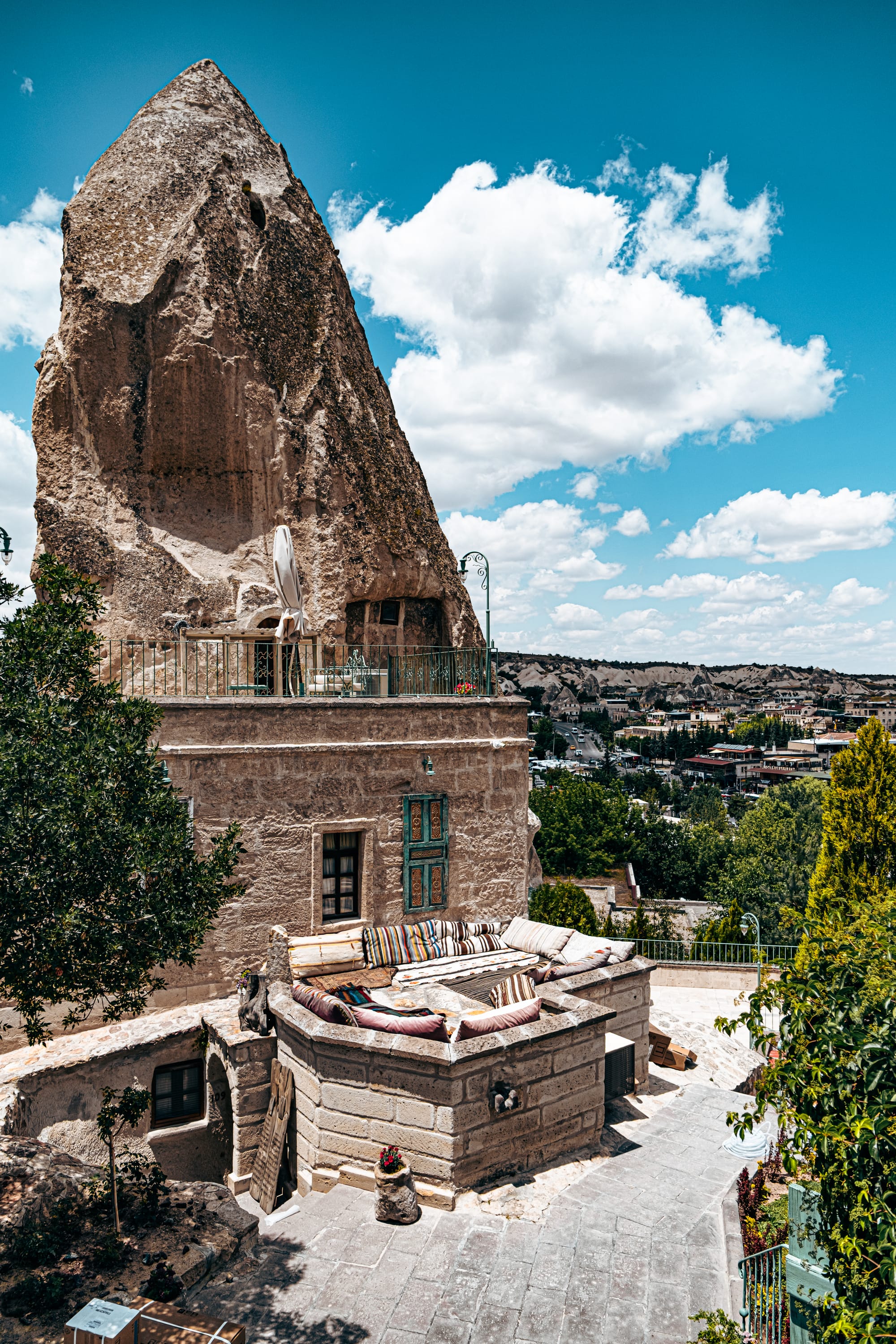
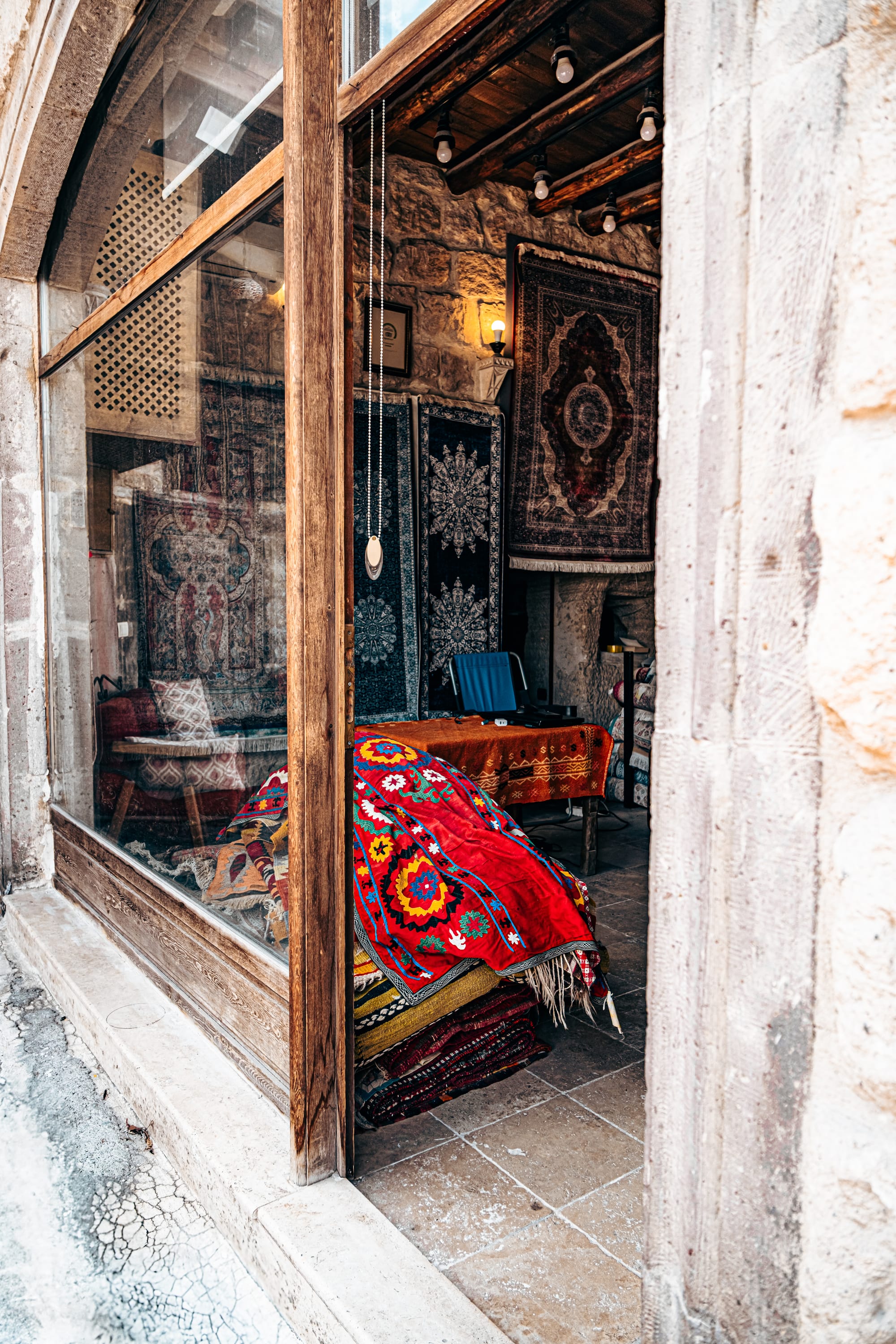
Living here as a nomad means convenience above all. Nearly every tour departs from Göreme, and most hikes can be reached on foot without transport. The town can feel busy in high season, but its energy makes it a natural meeting place for travelers from around the world. If you want to be in the center of the action, with cafés and valleys at your doorstep, Göreme is where Cappadocia feels most alive.
Photography at Galerie İkman (Göreme)
A kaleidoscope of carpets, color, and curated light.
Galerie İkman is one of Göreme’s most photographed spots—an atmospheric carpet shop where walls, ceilings, and floors are draped in intricate Turkish rugs. Beyond being a working family-run business, it has also become a kind of staged photography location, with certain rooms arranged specifically for capturing the perfect shot. The textiles themselves are stunning, layered in deep reds, blues, and golds that glow in the filtered light, creating a scene that feels almost cinematic.
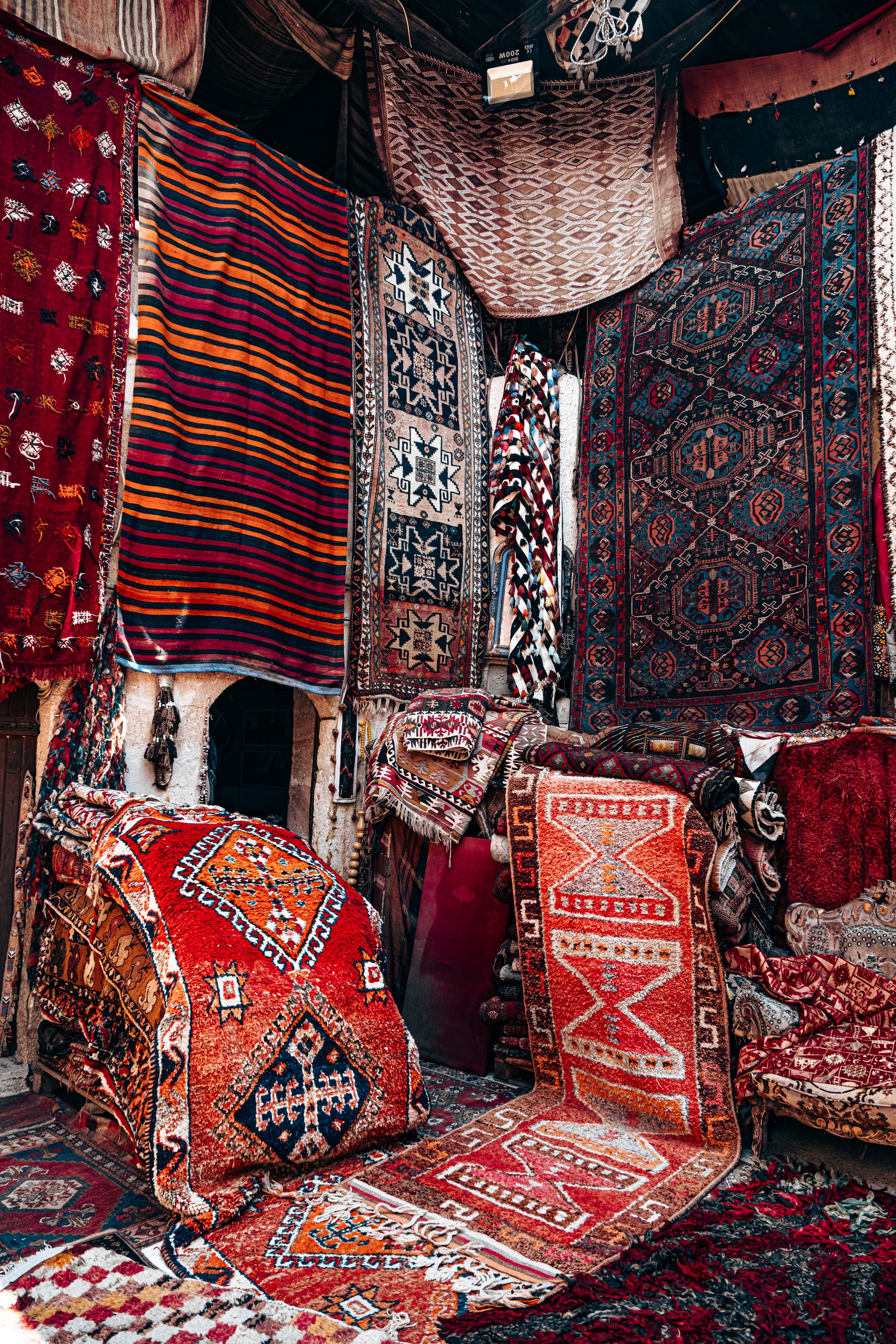
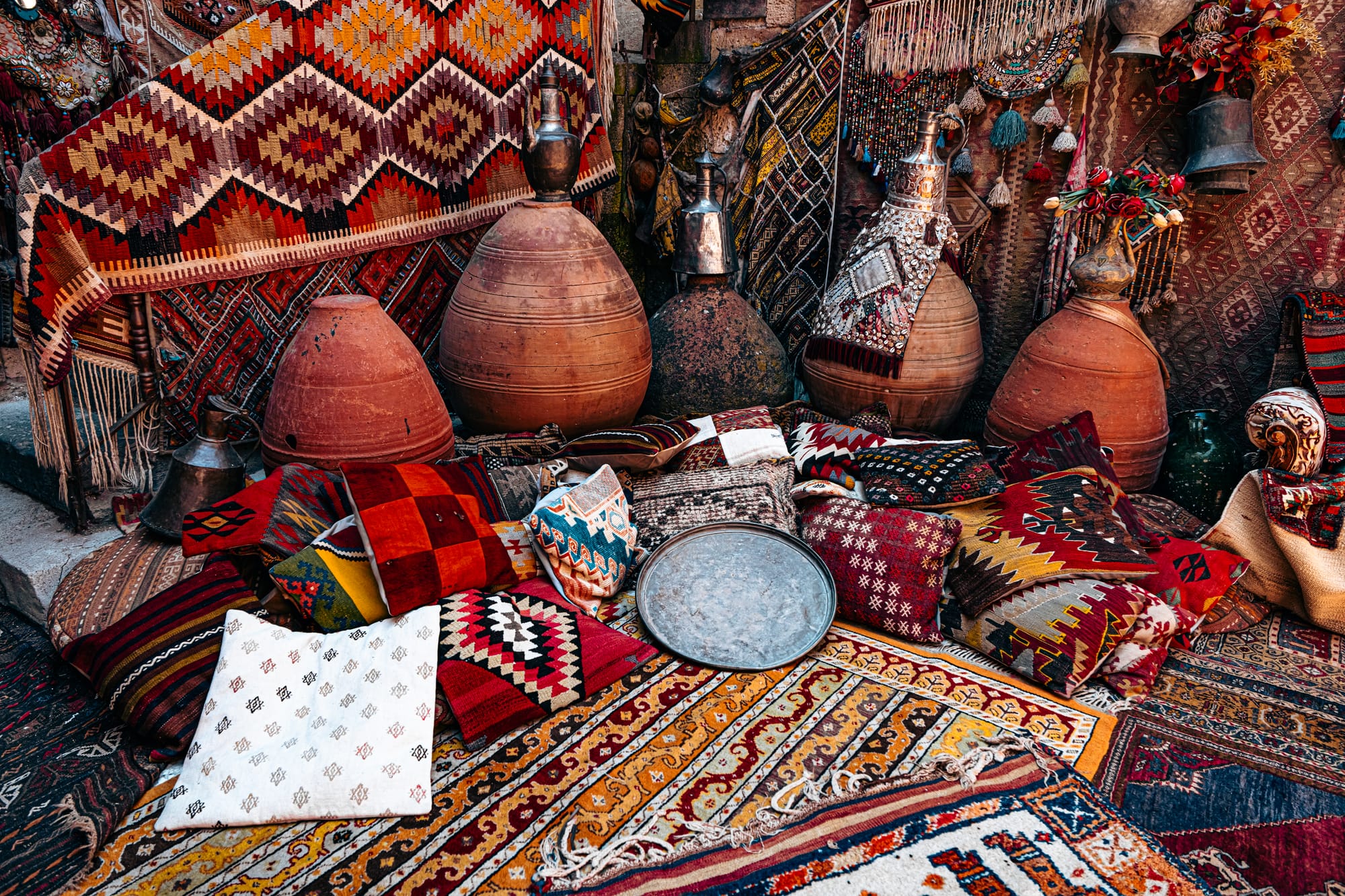
Visiting Galerie İkman is as much about the experience as the photos. You’ll find genuine carpets for sale alongside the staged sets, and the owners balance commerce with hospitality, often sharing tea while you browse. It’s undeniably touristy, yet the space remains memorable for its sheer sensory richness—textures, patterns, and colors overwhelming in the best way. Whether or not you walk away with a photo, it’s one of Göreme’s most unique interiors, a visual counterpoint to the stark stone landscapes outside.
Cappadocia Cultural Antique Collection (Göreme)
A museum of memory and craft.
Tucked away in Göreme, the Cappadocia Cultural Antique Collection is a small, family-run museum that feels more like stepping into someone’s personal archive than a formal institution. The space is filled with artifacts gathered over decades—handmade tools, ceramics, textiles, photographs, and household objects that trace everyday life in Cappadocia through the 19th and 20th centuries. Each piece tells a quiet story of how people lived with the land, shaping and being shaped by it.
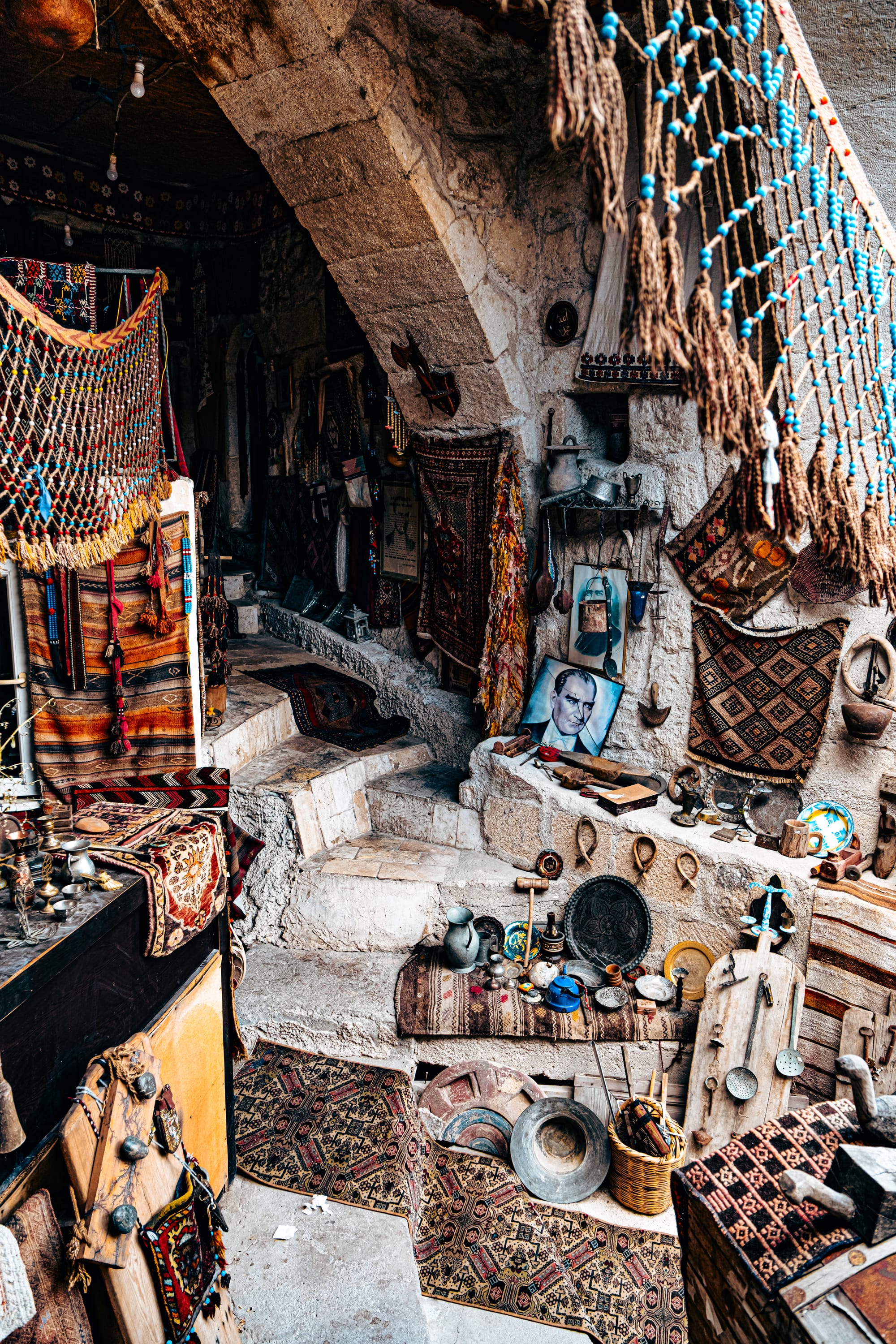
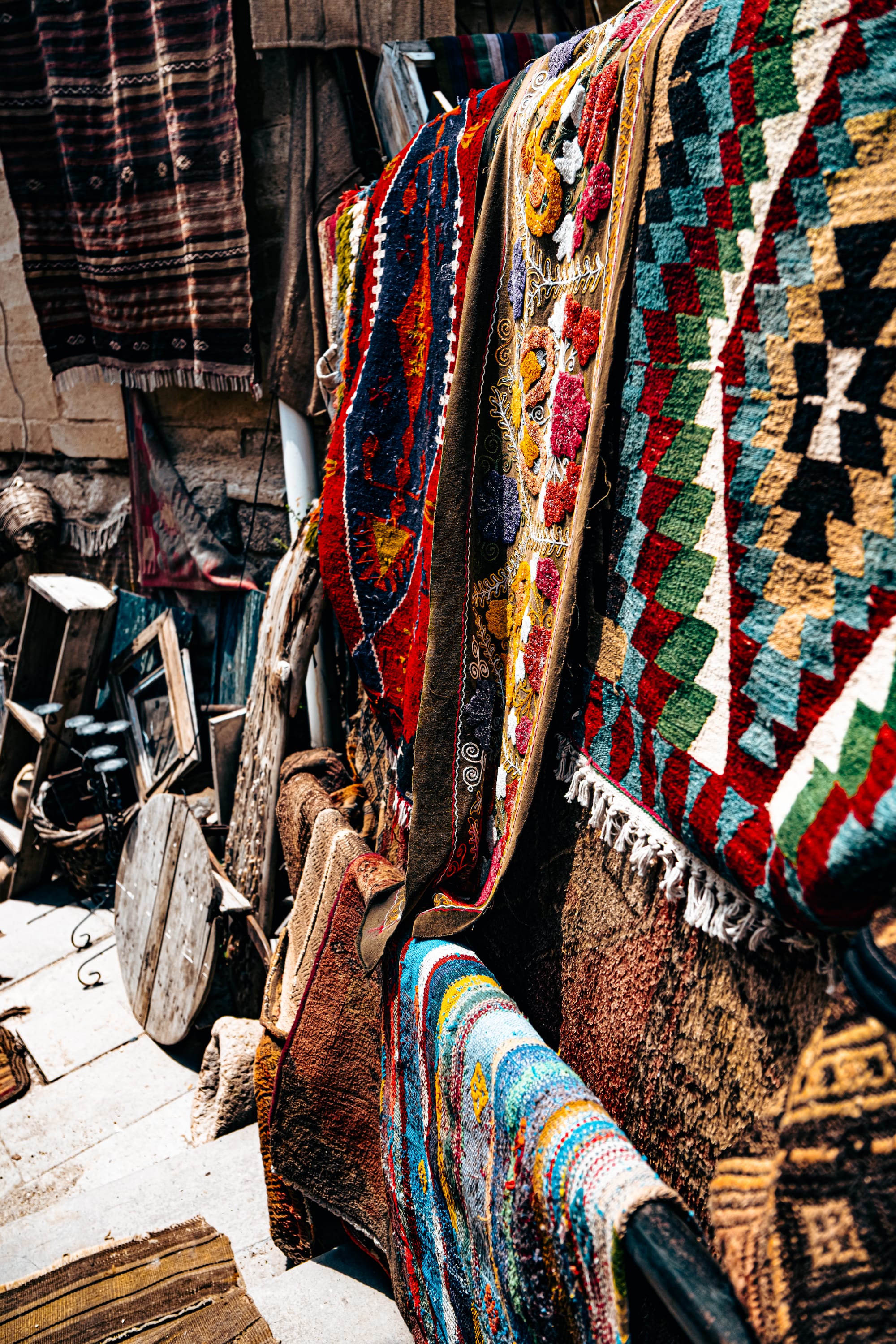
What makes the collection special is its intimacy. It’s a reminder that Cappadocia’s history isn’t only written in underground cities or painted in church frescoes—it’s also in cooking pots, wool blankets, and family portraits.
Uçhisar
A hilltop village crowned by stone.
Smaller and quieter than Göreme, Uçhisar is known for its dramatic centerpiece: Uçhisar Castle, the highest point in Cappadocia. The town spreads gently around it, a mix of stone houses, boutique hotels, and narrow lanes that open to sweeping views over the valleys. From almost anywhere in Uçhisar, you can see balloons rising at dawn or sunsets turning the cliffs shades of rose and gold. The atmosphere is slower here—less about bustle, more about perspective.
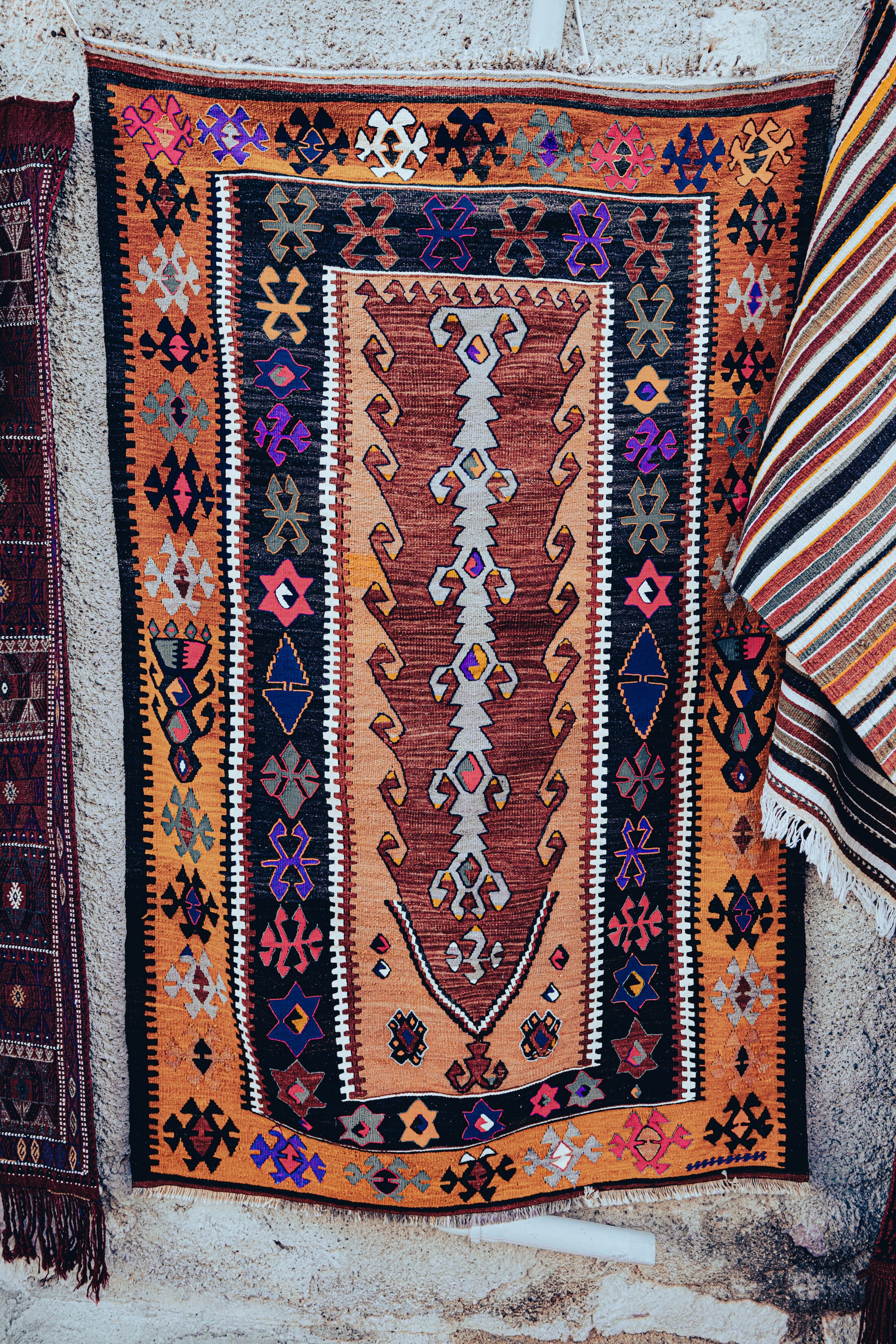
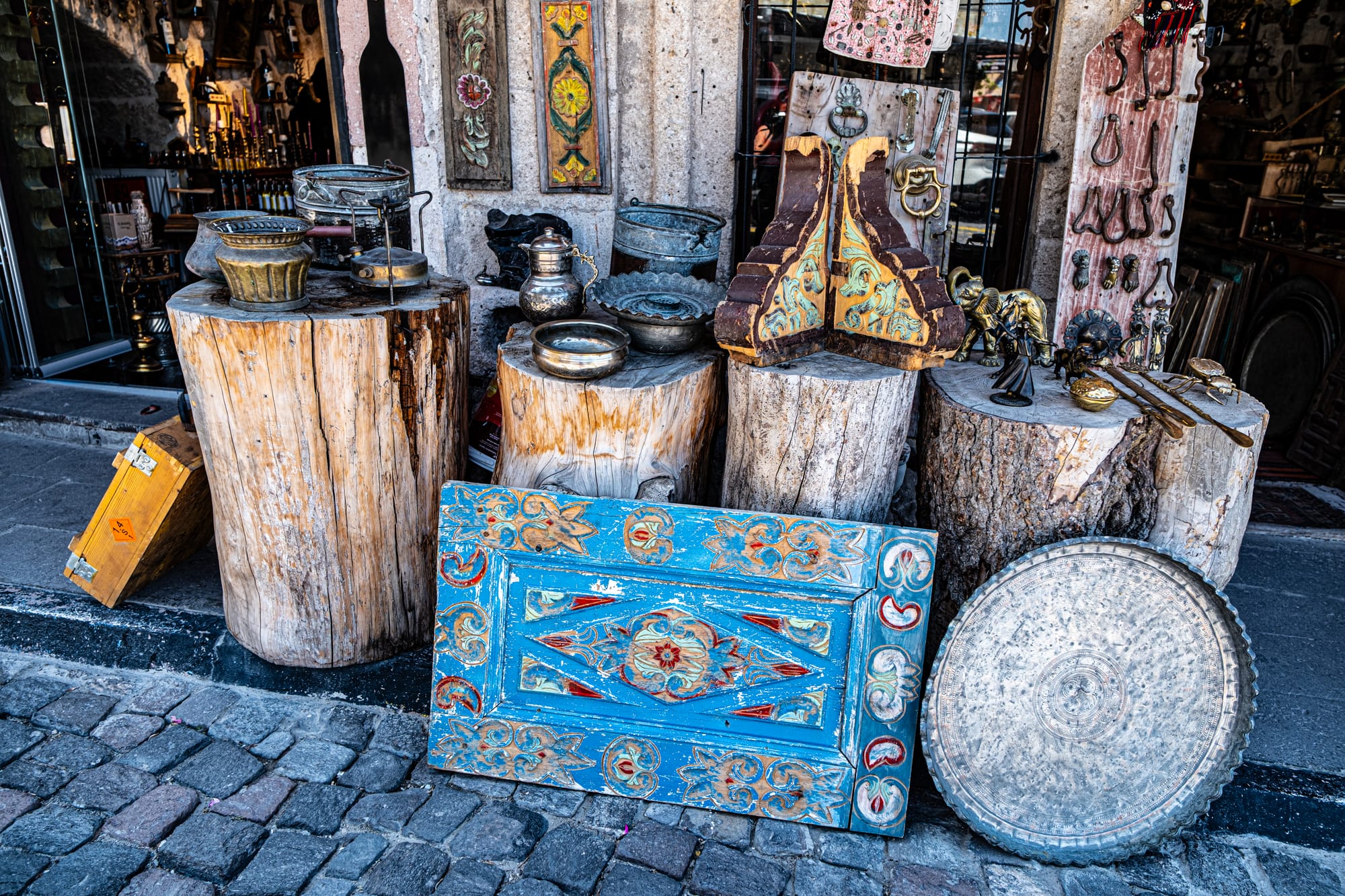
For nomads, Uçhisar offers a calmer base with easy access to trails leading through Pigeon and White Valleys. You’ll still find cafés and guesthouses, but the pace feels more local, shaped by daily life rather than constant tour traffic. Staying here means trading convenience for quiet, and for many, that’s the draw: a chance to wake up with Cappadocia stretched out below you, the land itself dictating the rhythm of your days.
Çavuşin
A village of crumbling cliffs and quiet lanes.
Just a short drive from Göreme, Çavuşin is one of Cappadocia’s oldest settlements, known for its dramatic rock face riddled with abandoned cave houses and churches. The village once housed both Greek and Turkish communities, and the layers of history remain visible in its crumbling façades and carved chapels, including the Church of St. John the Baptist, perched high above with sweeping views. Wandering its narrow streets, you feel the weight of time more tangibly than in the more polished tourist hubs.
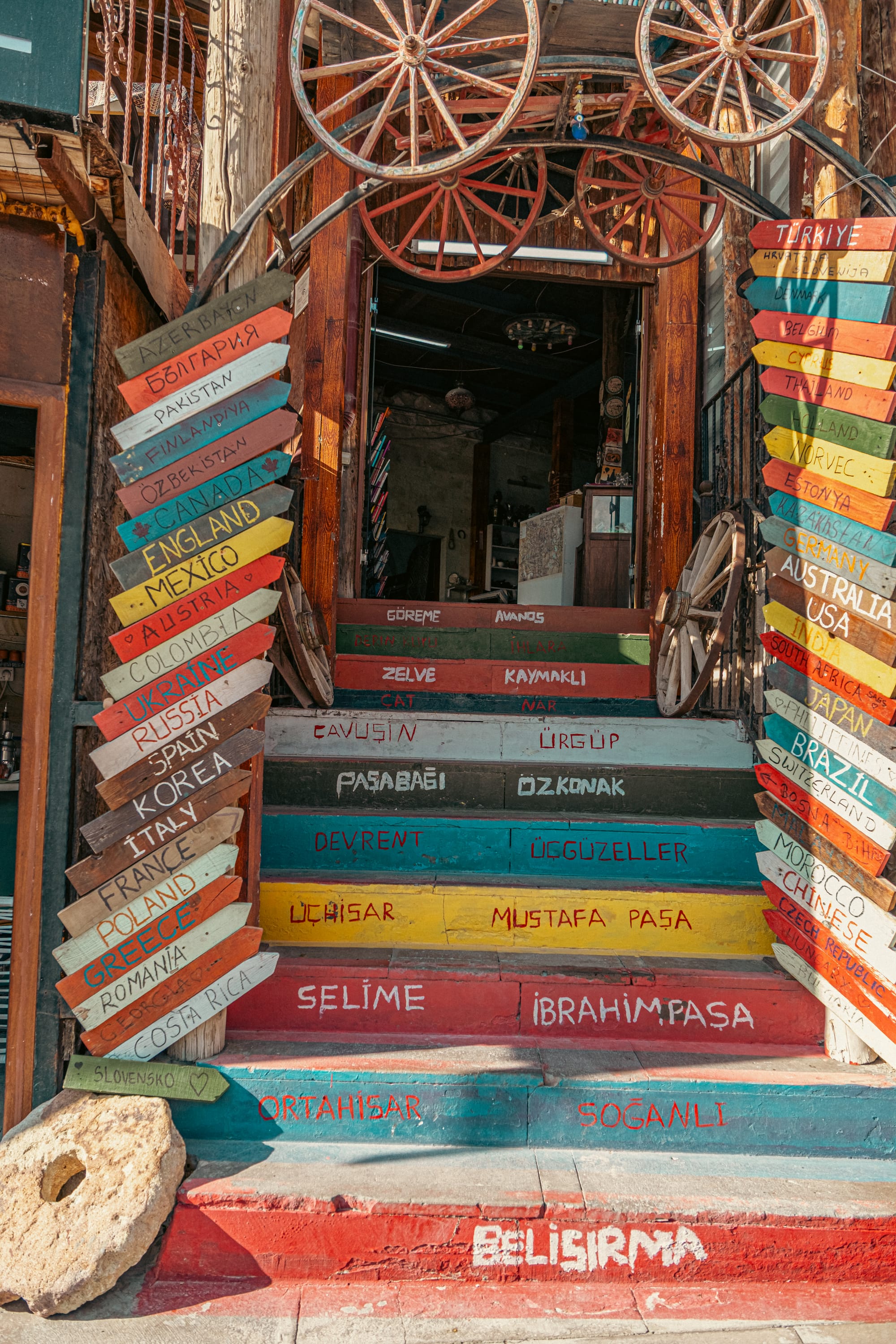
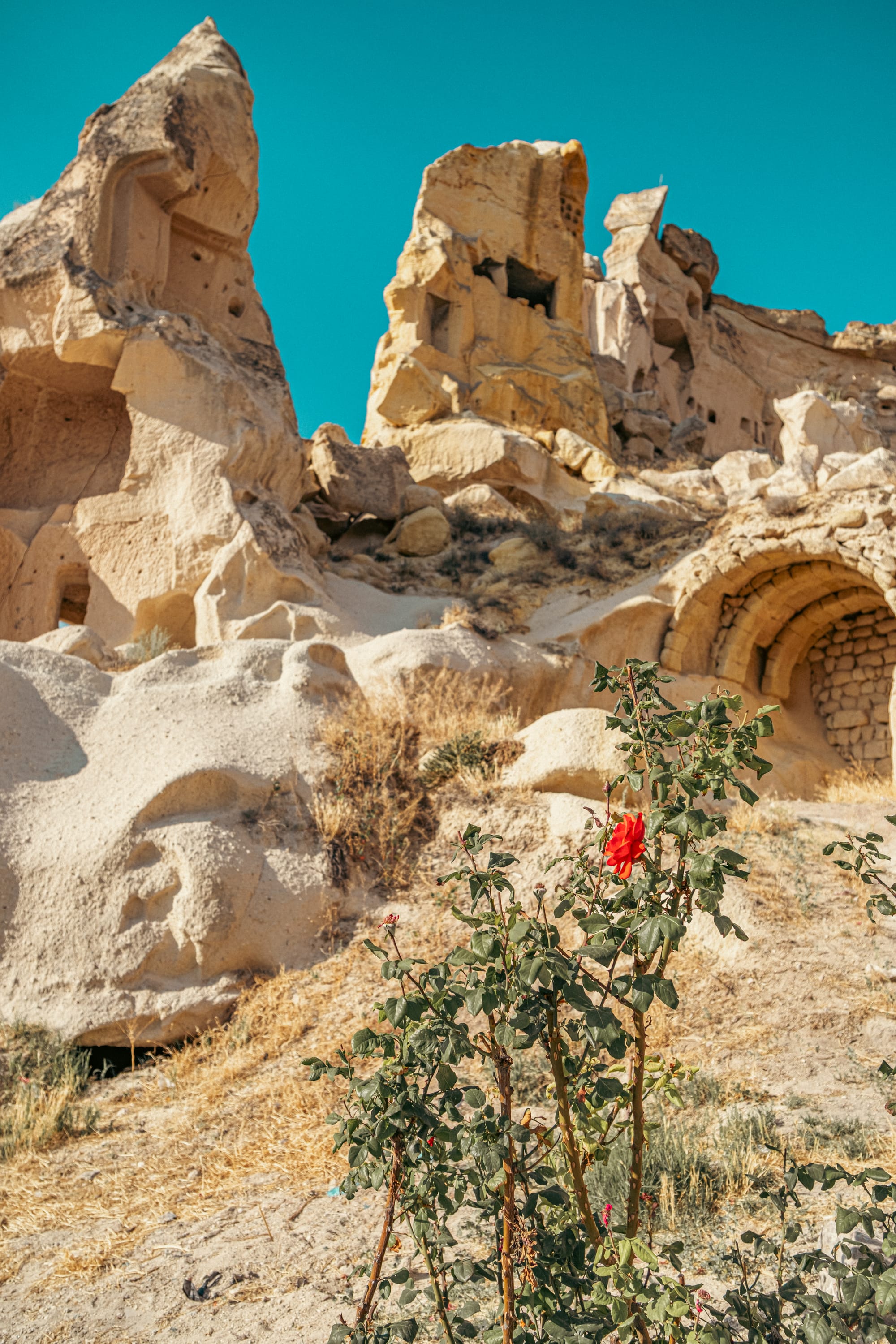
Today, Çavuşin is quieter than Göreme or Uçhisar, with a handful of guesthouses, pottery shops, and tea gardens that make it an easy stop for an afternoon. The atmosphere is rustic and a little wild—stone walls giving way to open fields, cliffside dwellings slowly eroding back into the rock.
Tarihi Ev Historical House (Çavuşin)
A family home turned living museum.
In the village of Çavuşin, Tarihi Ev Historical House offers an intimate glimpse into Cappadocia’s domestic past. Preserved by the same family for generations, the house has been carefully kept in its original form, with stone walls, carved rooms, and everyday objects that once filled the rhythms of life here. Walking through, you see not only architecture but also the traces of how people cooked, slept, and gathered—details often lost in larger sites.
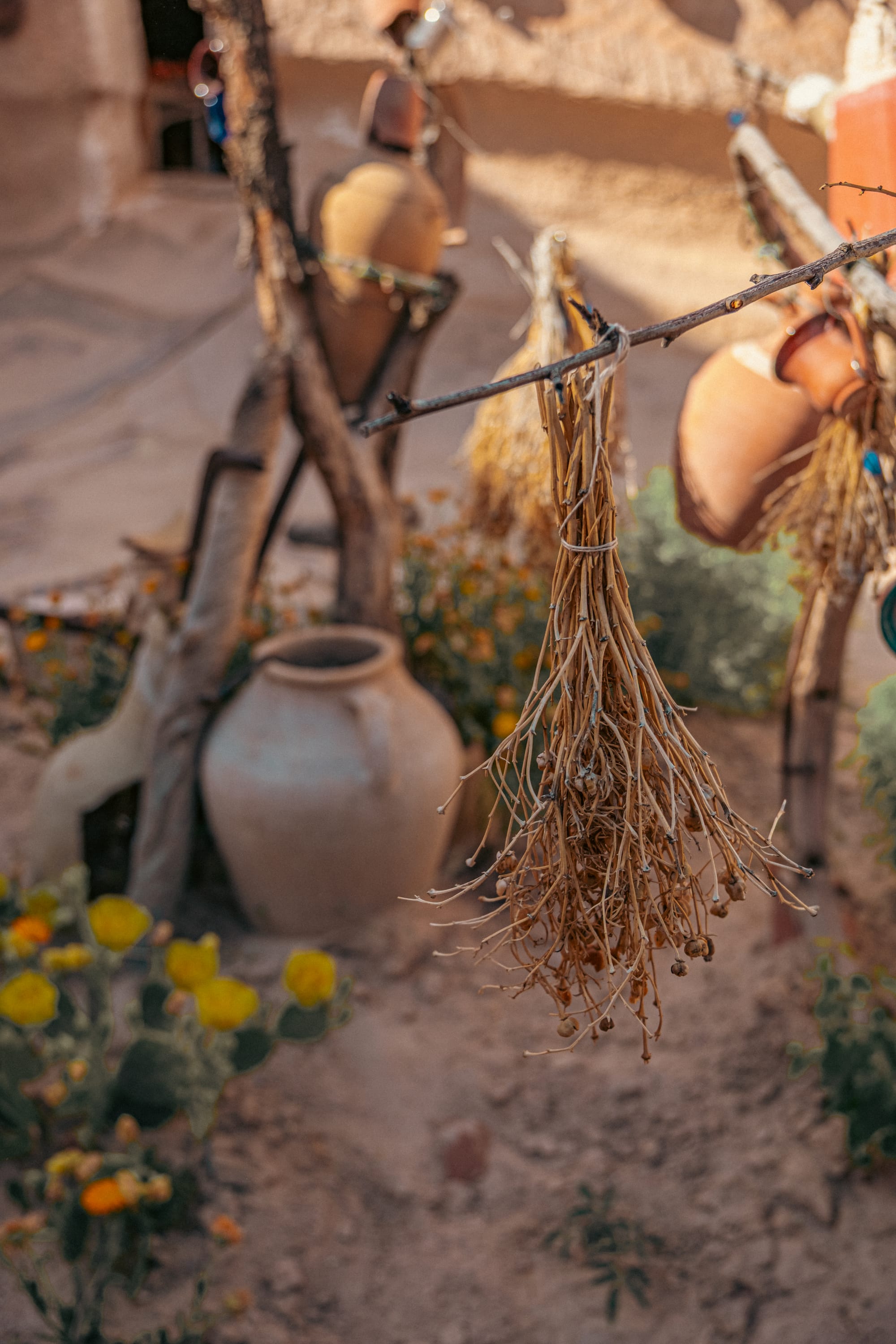
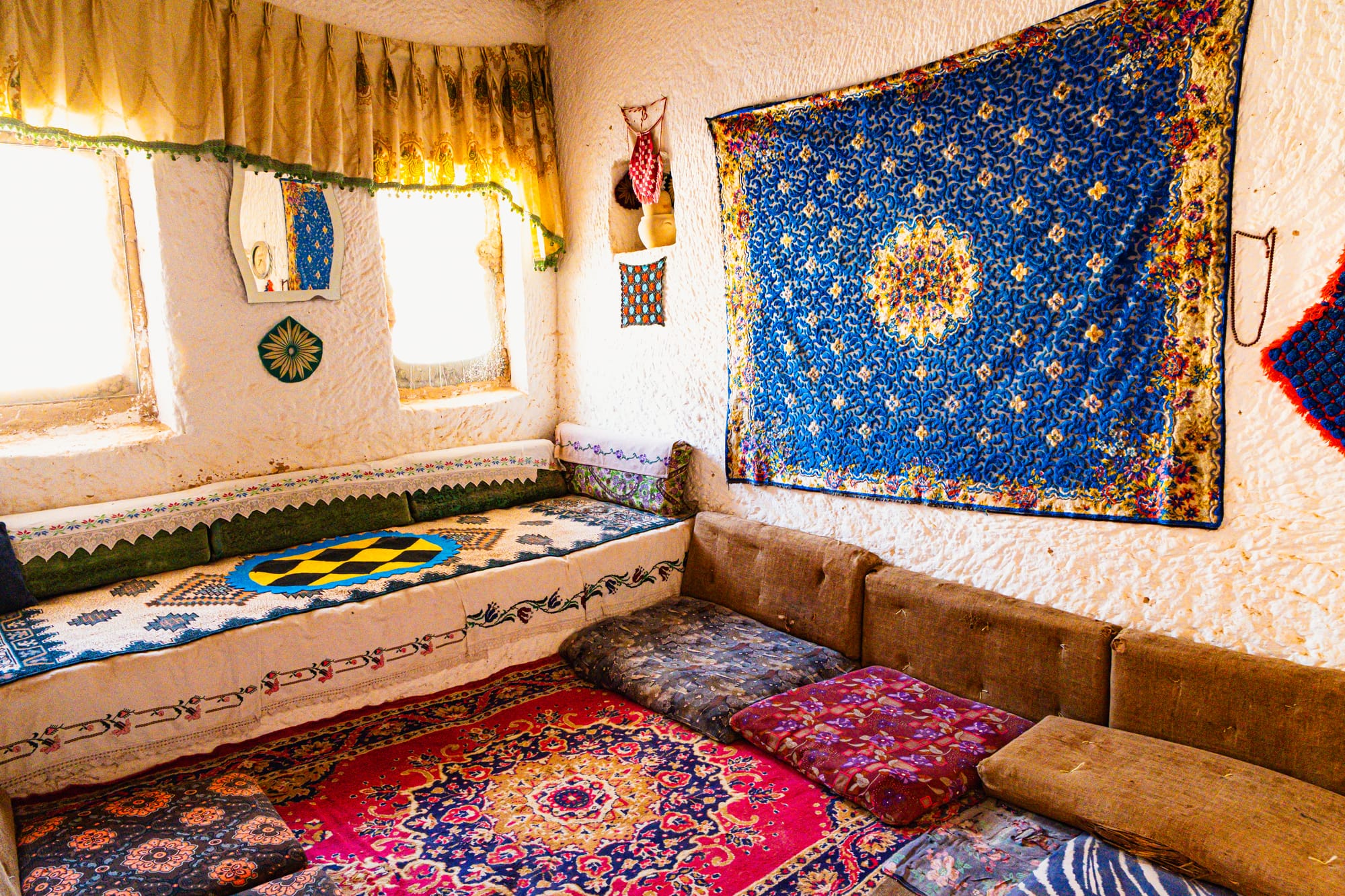
What makes it memorable is the personal connection. It feels less like a museum and more like being welcomed into someone’s home, where memory and heritage are alive in every corner.
Vegan food in Cappadocia
Plant-based eating in a land of clay pots and cave kitchens.
Cappadocia doesn’t have a huge vegan restaurant scene, but eating plant-based here is easier than you might expect. Many traditional Turkish dishes are naturally vegan—mercimek çorbası (lentil soup), stuffed vine leaves, grilled vegetables, and zeytinyağlı fasulye (beans in olive oil) are staples you’ll find on local menus. A few restaurants in Göreme and Uçhisar also offer thoughtful vegan options, including vegan versions of the famous clay pot (testi kebab) and hearty vegetable stews cooked in earthenware.
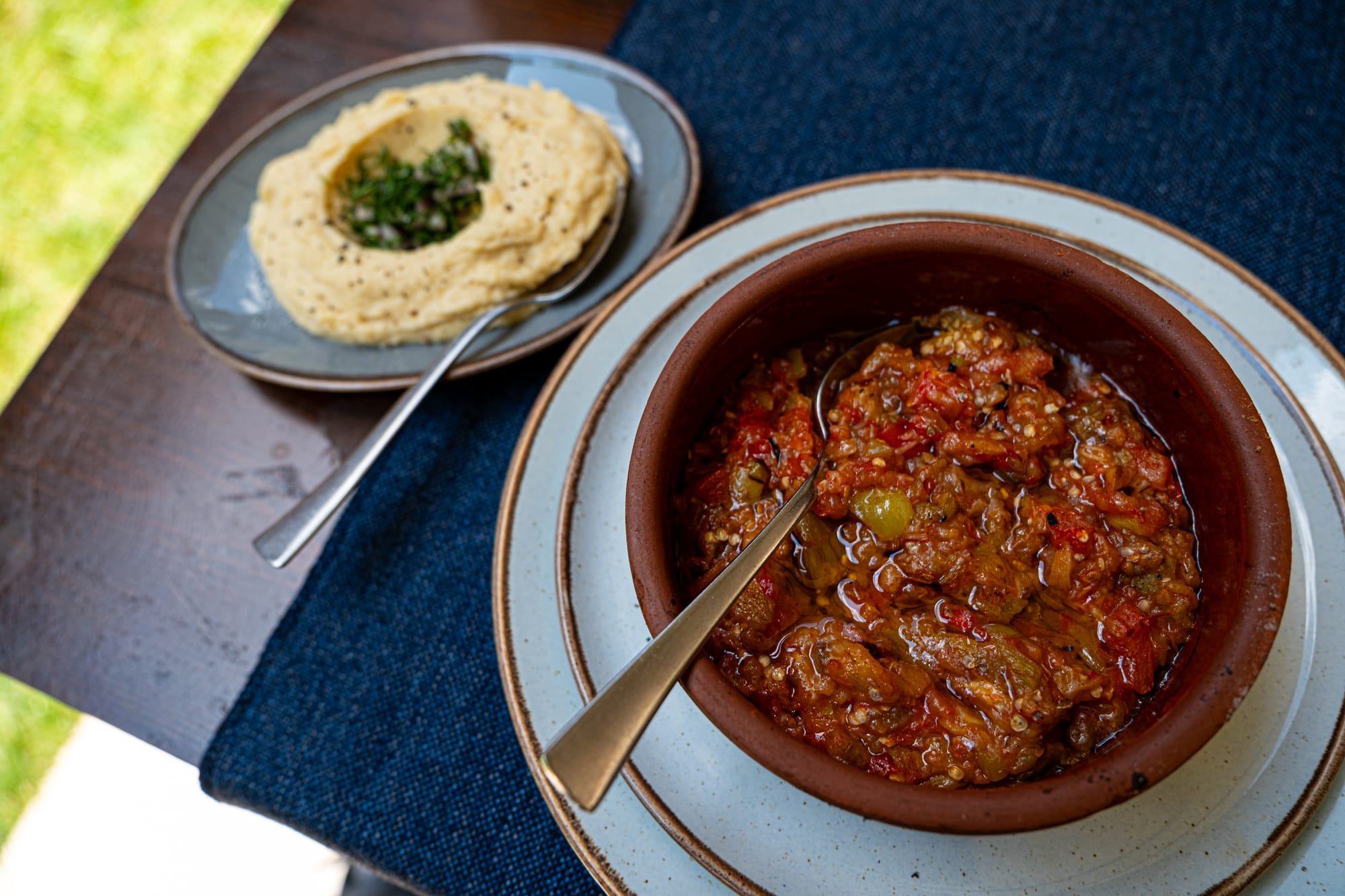
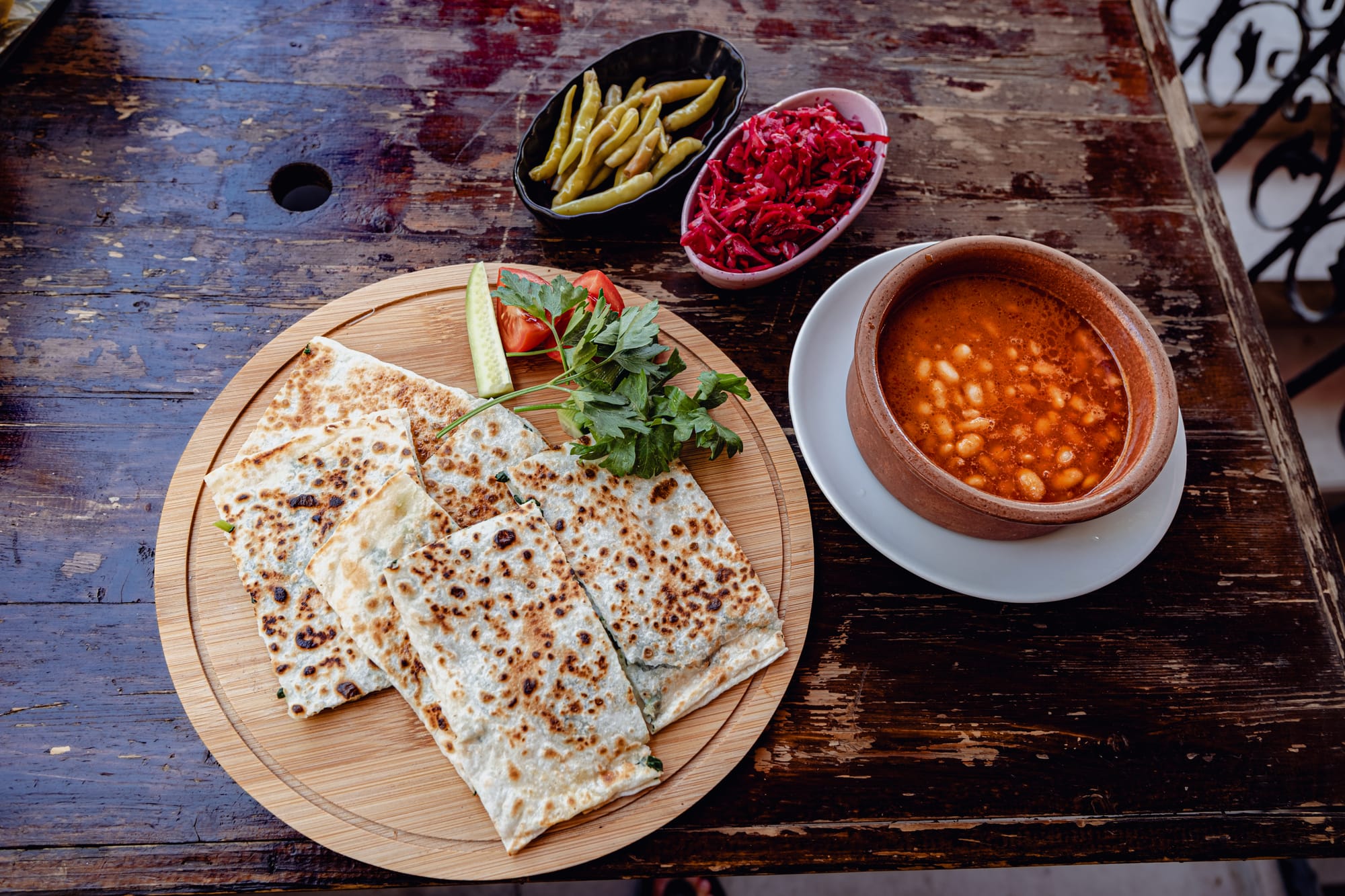
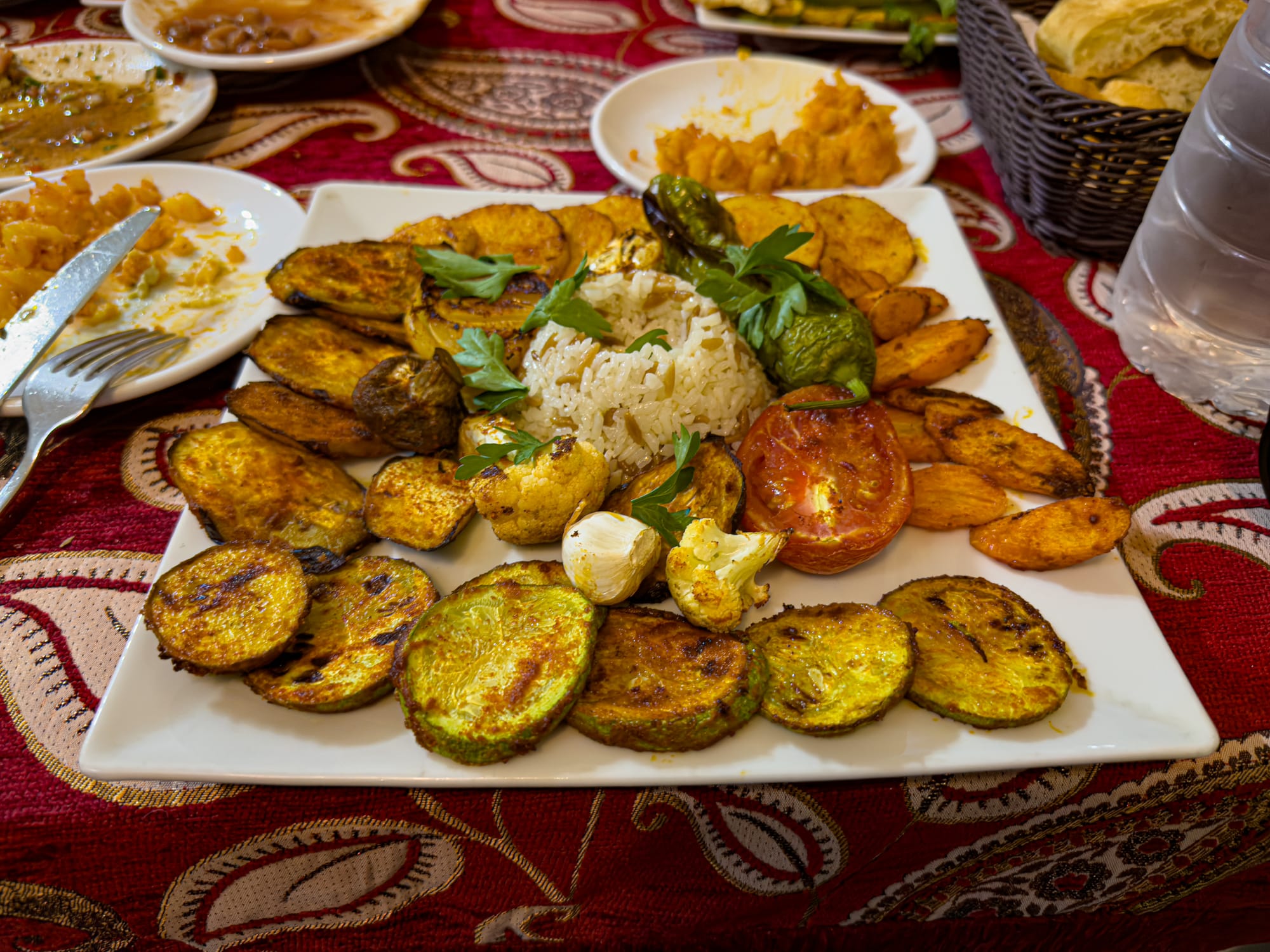
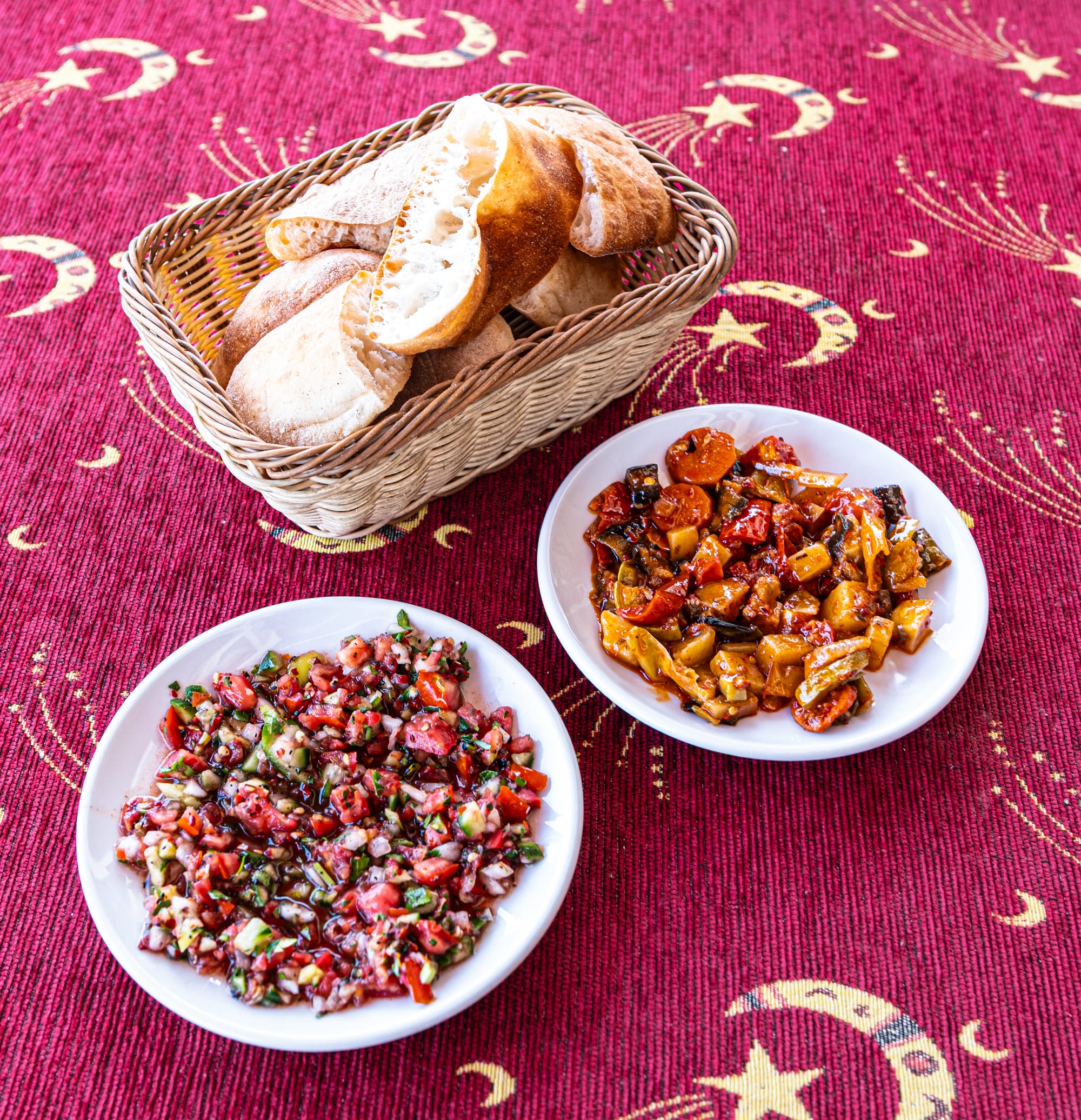
What makes dining here memorable isn’t just what’s on the plate, but the setting: cave restaurants lit by lanterns, terraces overlooking valleys, and family-run kitchens where meals are served with warmth and simplicity.
Balloon viewpoints
Nomads Cave Hotel’s Rooftop
A front-row seat to Cappadocia’s morning show.
In the center of Göreme, Nomads Cave Hotel’s rooftop terrace is a great spot to watch the hot air balloons rise. At sunrise, the sky fills with dozens of balloons drifting above the town, while fairy chimneys and cave houses glow in the early light. From the cushions and carpets spread across the rooftop, you get both the intimacy of being in town and the sweep of Cappadocia’s valleys opening around it.
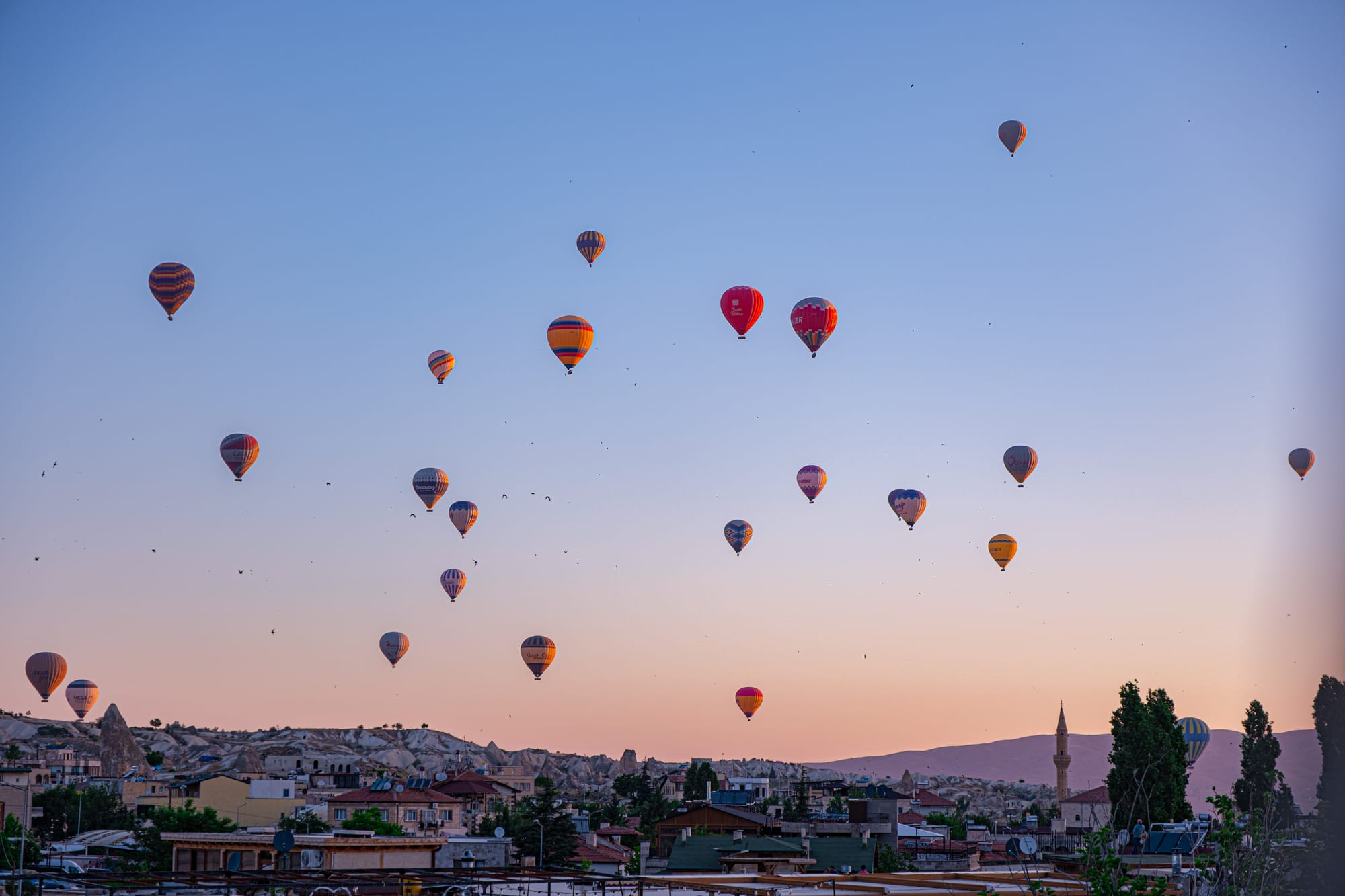
People gather quietly with tea or coffee, cameras poised, waiting for the burners to fire and the first balloons to lift. The scene feels almost cinematic, a reminder of why Göreme is the heart of Cappadocia’s balloon culture. Even if you’ve watched from ridgelines or valleys, seeing the balloons from this rooftop has its own magic: close, vibrant, and unforgettable.
Uçhisar Castle ridges
Dawn skies filled with color above a stone crown.
Just below Uçhisar Castle, the ridges that drop toward Pigeon Valley double as one of Cappadocia’s most atmospheric balloon viewpoints. At sunrise, dozens of balloons rise across the horizon, drifting above fairy chimneys and stone cliffs while the silhouette of the castle anchors the scene. From the ridgelines, you get both wide panoramas and close-up views, with balloons often gliding so low you can hear the burners roar.
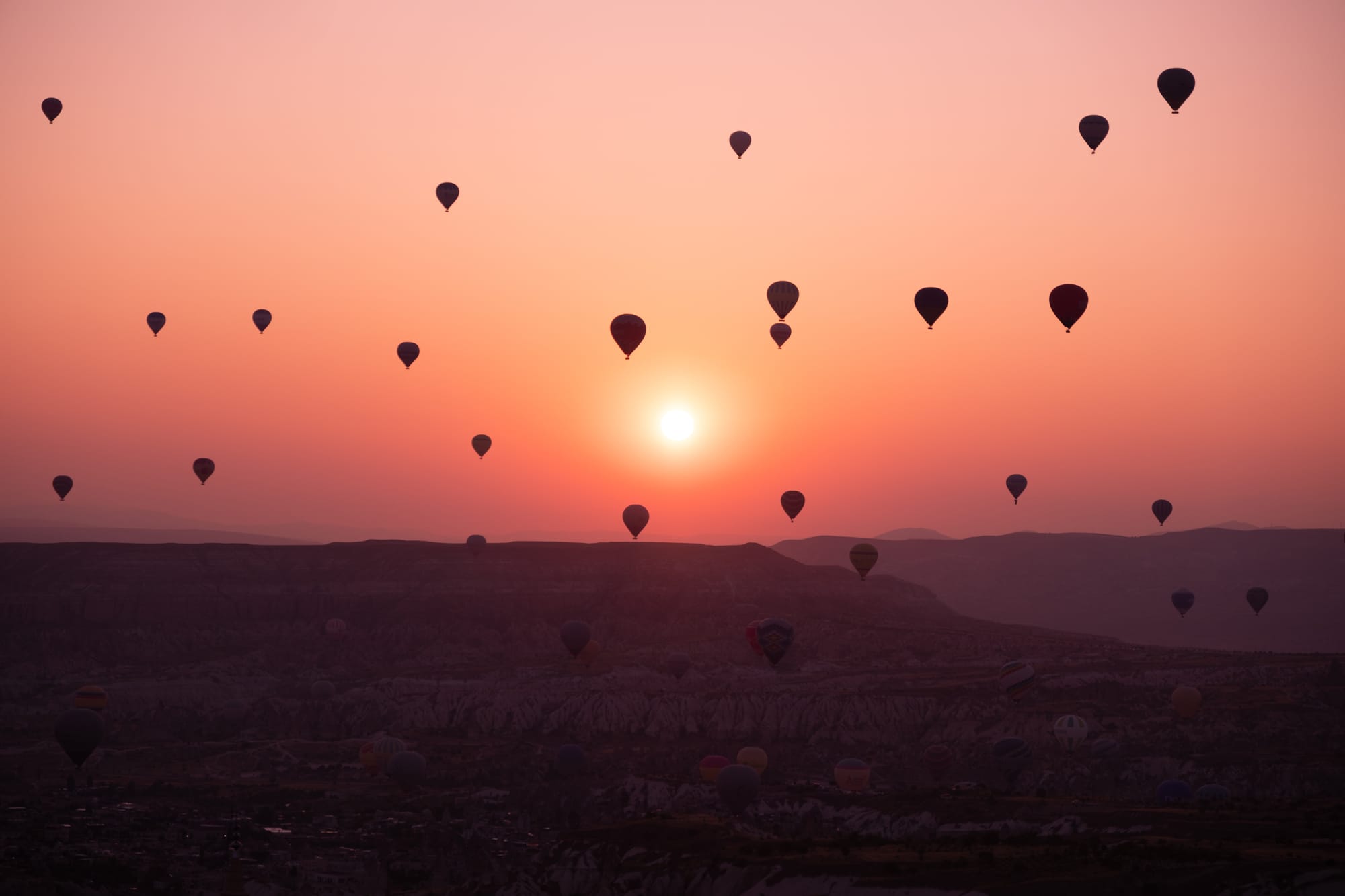
Unlike the crowded terraces in Göreme, the ridges here feel more open and less hurried. A short walk from town takes you onto paths where you can sit quietly with tea and watch the morning unfold.
Essential tools for Cappadocia
For nomads living and working from Cappadocia, these tools made our stay smoother.
Saily Global eSIM
Instant global mobile data without needing a local SIM. Saily global eSIM gives you mobile data in Turkey and dozens of other countries—no need to buy a separate local SIM when you arrive. Great for digital nomads who hop between places and want one seamless solution that works everywhere.
SafetyWing (global health & travel insurance)
An affordable, digital-nomad-friendly insurance plan that covers both travel hiccups and medical needs. We like that it runs month-to-month and can be started even if you’re already abroad. Helpful for peace of mind, especially on remote islands where care may require transfers or added costs.
NordVPN
A lightweight, fast VPN that lets you secure your connection on public wifi—especially important when working from colivings, cafes, or airports. It also lets you access content as if you were back home, which is helpful for banking, streaming, or logging into sensitive accounts.
Wise (multi-currency payments)
Our favorite banking solution for multi-currency payments and avoiding bad exchange rates. Wise lets you pay in Turkish lira locally and manage funds across dozens of currencies. We used it to split group dinners, pay for tours, and withdraw cash without the large fees traditional banks charge.
Should you choose Cappadocia?
Cappadocia isn’t a digital nomad hub in any conventional sense—there are no coworking spaces, no plug-and-play colivings, and very little community infrastructure. What it offers instead is atmosphere and depth: surreal landscapes that reward long stays, endless hikes, and mornings where hot air balloons rise over fairy chimneys like something from another world. It’s more frontier than hub, and that’s both its strength and its challenge.
The pros?
- A landscape unlike anywhere else, with endless hikes and valleys to explore
- Unique cultural sites: underground cities, cave churches, and centuries-old villages
- A rhythm of life that’s quiet, elemental, and conducive to focus
- Sunrise balloon spectacles that never get old
The trade-offs?
- No established nomad community—you’ll mostly be on your own
- Limited café culture and no dedicated coworking spaces
- Tourist crowds in hotspots like Göreme, especially in peak season
- Extreme weather: hot summers, cold winters, and changeable conditions for balloons
- Infrastructure geared toward short-term visitors, not longer stays
- It can be expensive during peak season
If you need a ready-made community and daily social structure, Cappadocia can feel isolating. But if you’re self-sufficient, drawn to strange landscapes, and curious about living in a place that feels closer to a desert frontier than a polished hub, it offers something rare: the chance to let workdays unfold alongside a landscape that never stops surprising you.
Read more
If you’re curious about how to make Cappadocia work for you, we’ve written extensively about our experience. Check out our Cappadocia guides for more information on what we enjoyed in the city.






